CPD: Muscles of Mastication
Dr Rehanna Beckhurst describes the anatomy of the masseter
Toxin Evolution
Practitioners dive into the development of toxin over the years and explore its future
Understanding Exosomes
Introducing the concept of exosomes in regenerative aesthetic medicine
Implementing Sustainability
Rebecca Waters advises on quick fixes to make your clinic more eco-friendly

VOLUME 10/ISSUE 1 - DECEMBER 2022
One Treatment. Endless Options.
HydraFacial is for everyone. It’s suitable for all skin types and addresses all skincare needs. The HydraFacial delivers immediate, noticeable results, with no downtime, that keep your customers returning regularly.
HydraFacial is your connection to millions of believers that know that beauty is more than a physical attribute – it’s a feeling. Our customers’ want to give their clients the best experience possible.


The HydraFacial Company helps them deliver it.
Consumers want to be pro-actively offered personalised solutions for skin health and provide them with education on their ideal, easy-to-follow skin health regimen1.
And your clients needs are as individual as they are, which is why HydraFacial has partnered with the best brands in aesthetics to bring you advanced booster options that meet the emerging consumer trends that are influencing our industry more than ever before.

HydraFacial is scored as a ‘99% Worth It’ rating by www.realself.com and on average, somewhere in the world, a HydraFacial treatment is now carried out every 10 seconds!
1 EddieWouldGrow Facial Research 2018, n=2000; 2 Mintel Trends 2017
Simplification Multi-benefit solutions that save time1 Personalisation Treatments tailored to specific skin concerns2 Recommendation Skin health technology and regimen education1 give your customers what they want!
to
Tips Tailored FOR Skin Type

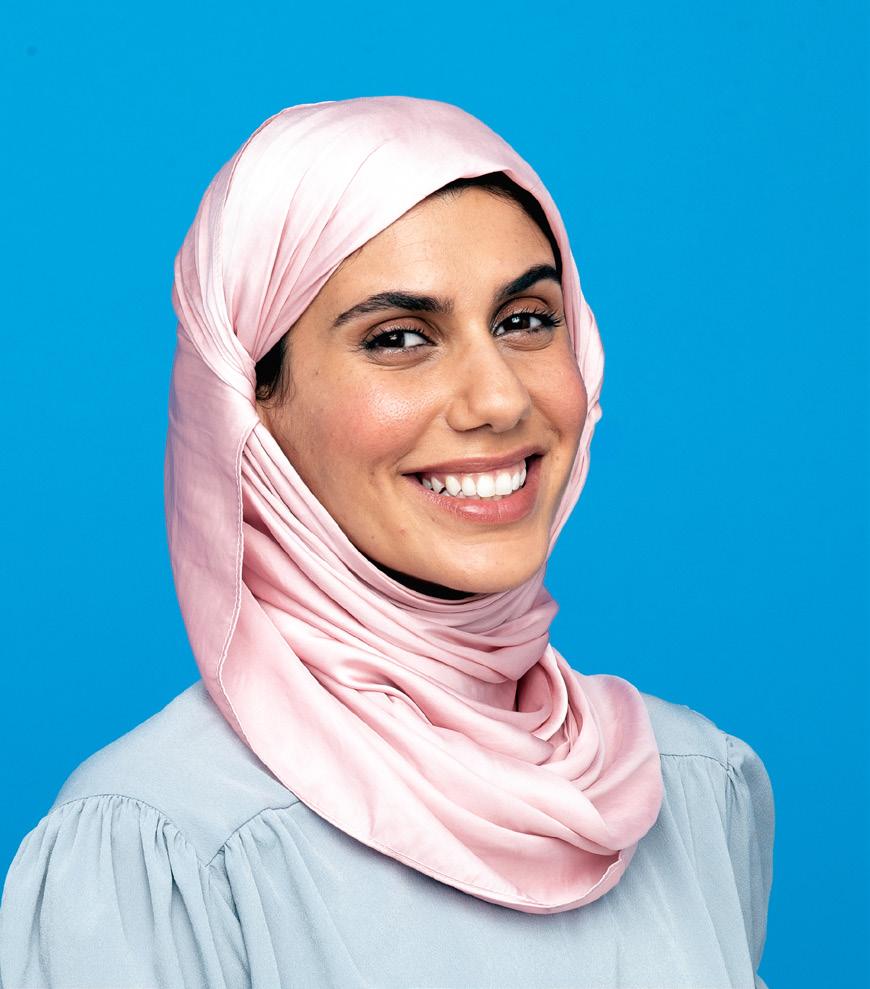
Only HydraFacial uses a unique, patented Vortex-Fusion delivery system to exfoliate, extract and hydrate skin. The spiral design of HydroPeel® Tips, used in conjunction with the HydraFacial proprietary vacuum technology and serums, creates a vortex effect to easily dislodge and remove impurities while simultaneously delivering hydrating skin solutions.
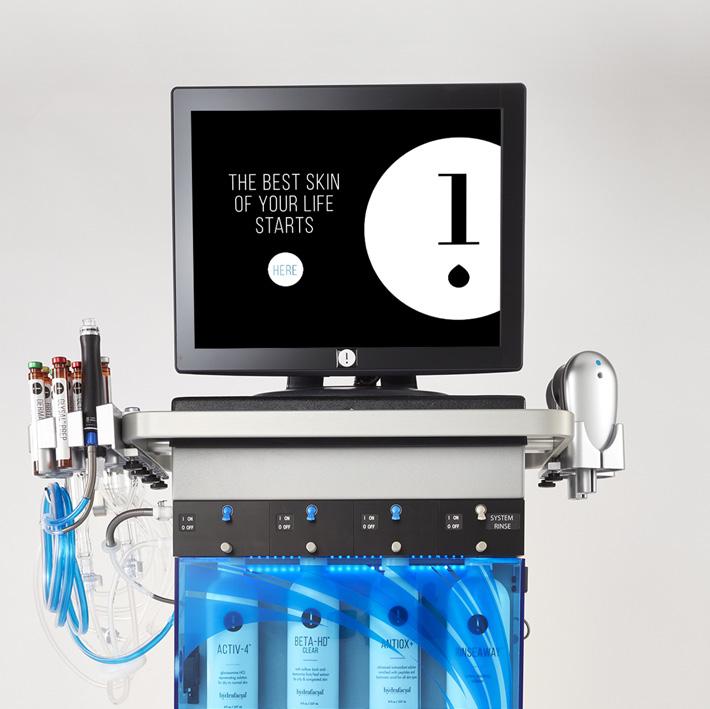
• Convenient, single use, saves time; eliminates the need for sterilisation equipment • Range of exfoliation levels allows for custom treatment results • Spiral design delivers painless extractions

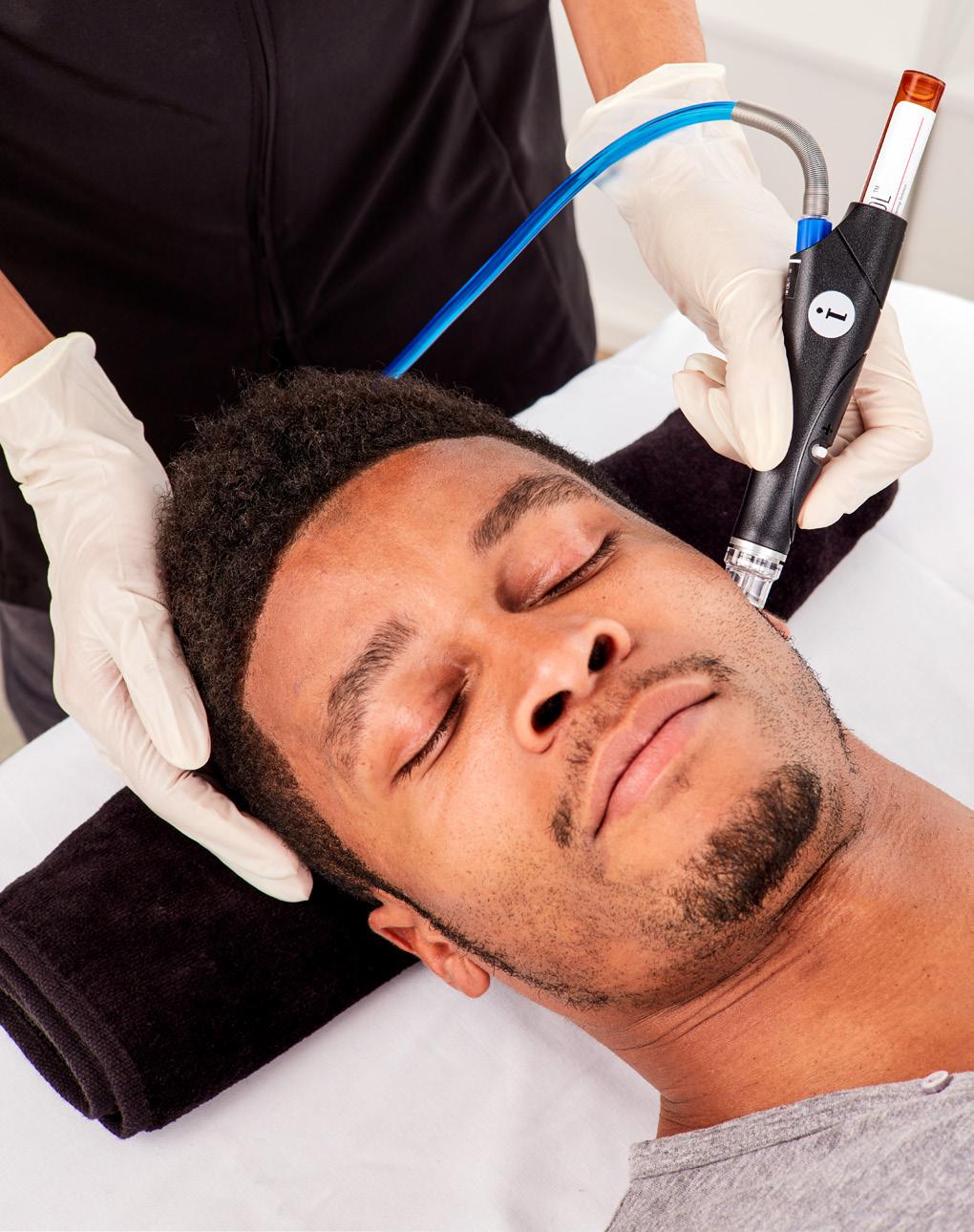
INTRODUCING KERAVIVE SCALP HEALTH

Expand into a new category with HydraFacial Keravive scalp heath treatment that leads to fuller looking hair. HydraFacial Keravive is a first of its kind 3-step treatment that includes an in-clinic component, as well as a 30-day take-home spray.
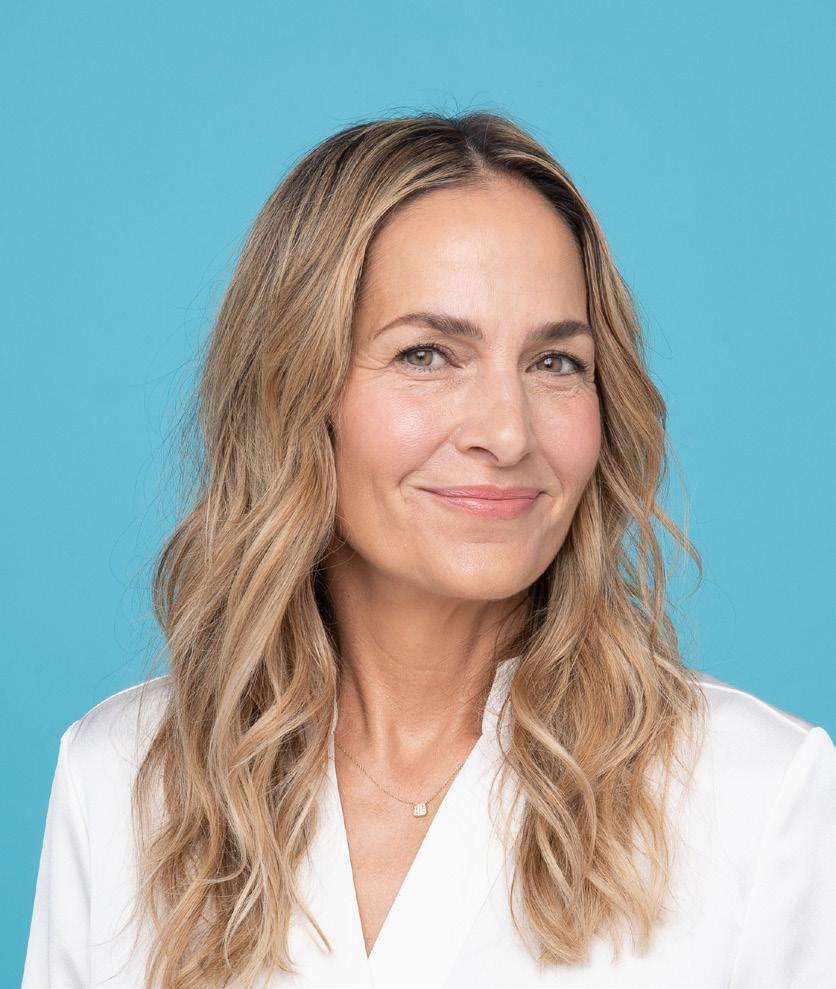
we deliver Personalisation...
How
Boosters
Target Skin Concerns HydraFacial delivers personalised skin health through boosters that are designed to: • Smooth and Refine • Restore and Firm • Brighten • Hydrate • Calm • Revitalise Lips & Eyes
W: hydrafacial.co.uk E: infoUK@hydrafacial.com T: 01788 572 007 To see the HydraFacial in action follow us @hydrafacialuk
“Whether it be on a fi lm set or at The Oscars, I always adopt an intelligent approach to skin health. As an advanced skincare device, providing total skin rejuvenation with no heat trauma, no skin injury, and no downtime, Celluma takes my skin engineering philosophy to new heights.”
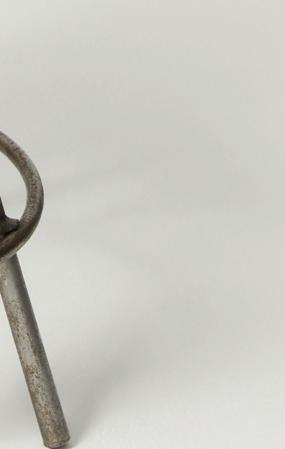








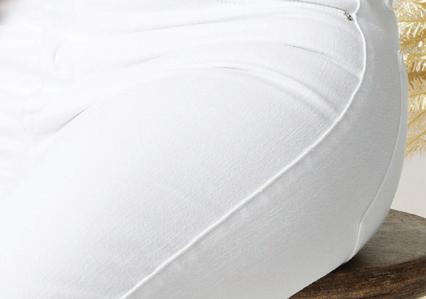
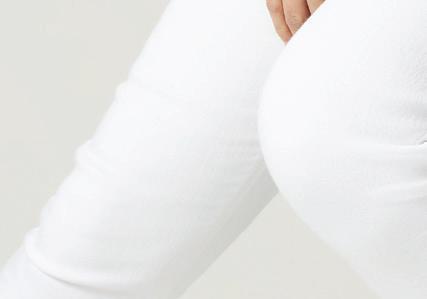





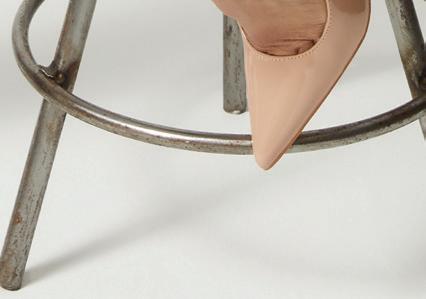


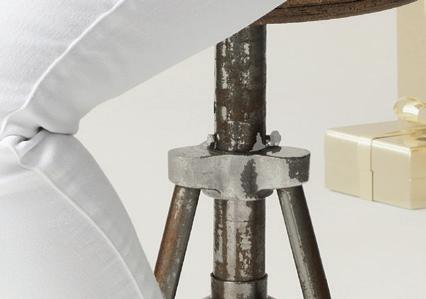




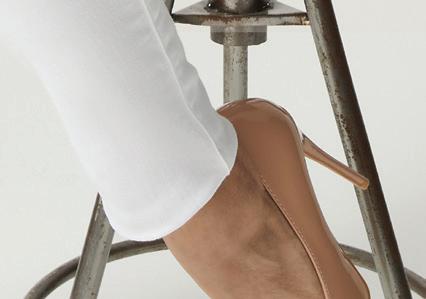



































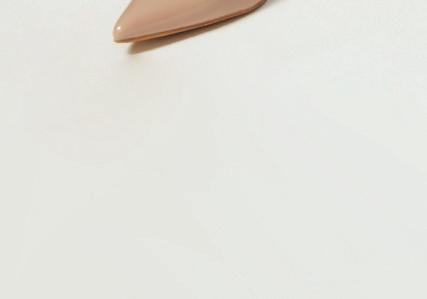






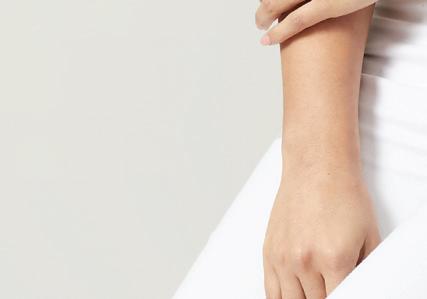


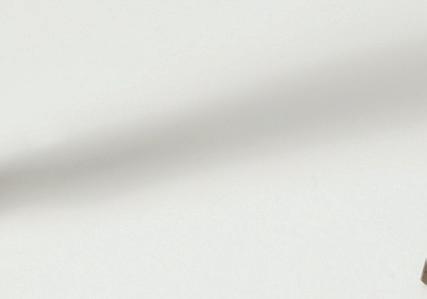


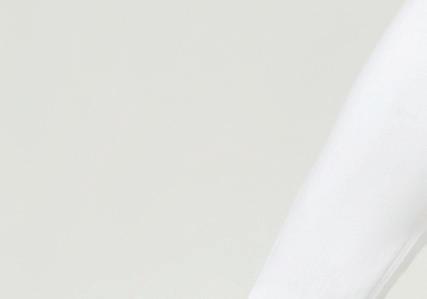



Light Therapy
infoUK@celluma.com www.celluma.co.uk 01462 481500
THRIVE WITH
ADEELA CROWN CELEBRITY AND FILM FACIALIST INSTAGRAM: @adeelacrown FDA-CLEARED MEDICAL CE MARK WOUND HEALING ANTI-AGEING ACNE PAIN Scan here so you don’t miss Celluma holiday specials! Distributed by Unique Skin Manufactured by Celluma By Biophotas
08 News

The latest product and industry news

Out and about in the aesthetics specialty this month
News Special: Combining Facial Aesthetics and Dentistry Aesthetics investigates whether professionals are working collaboratively to achieve facial harmony
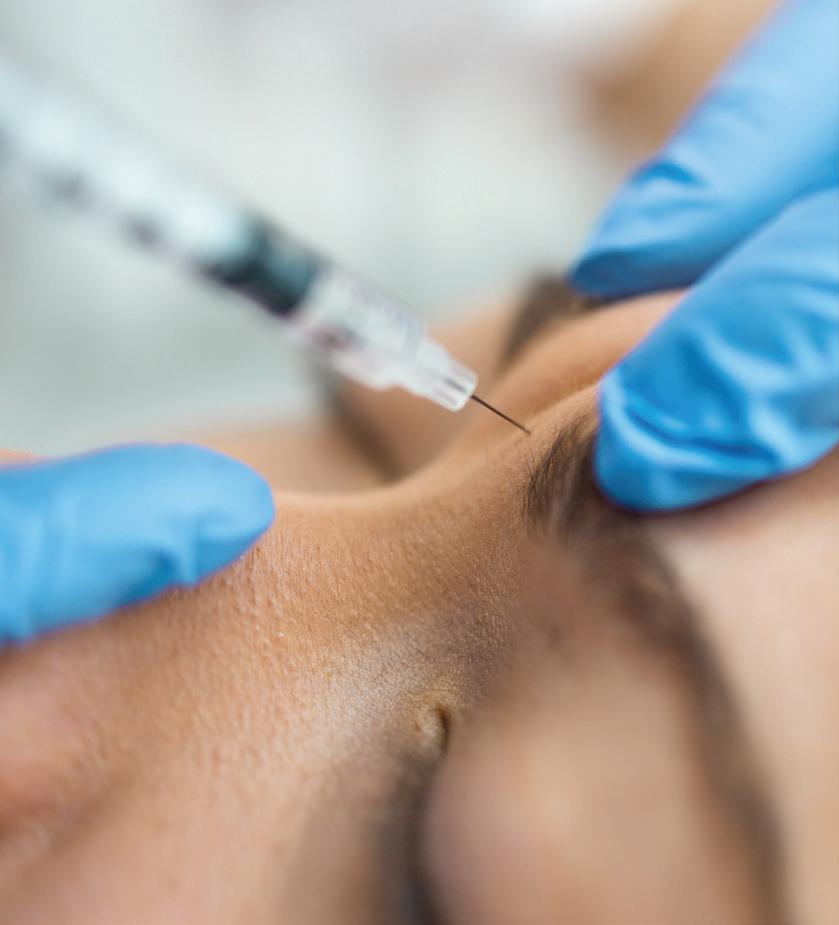
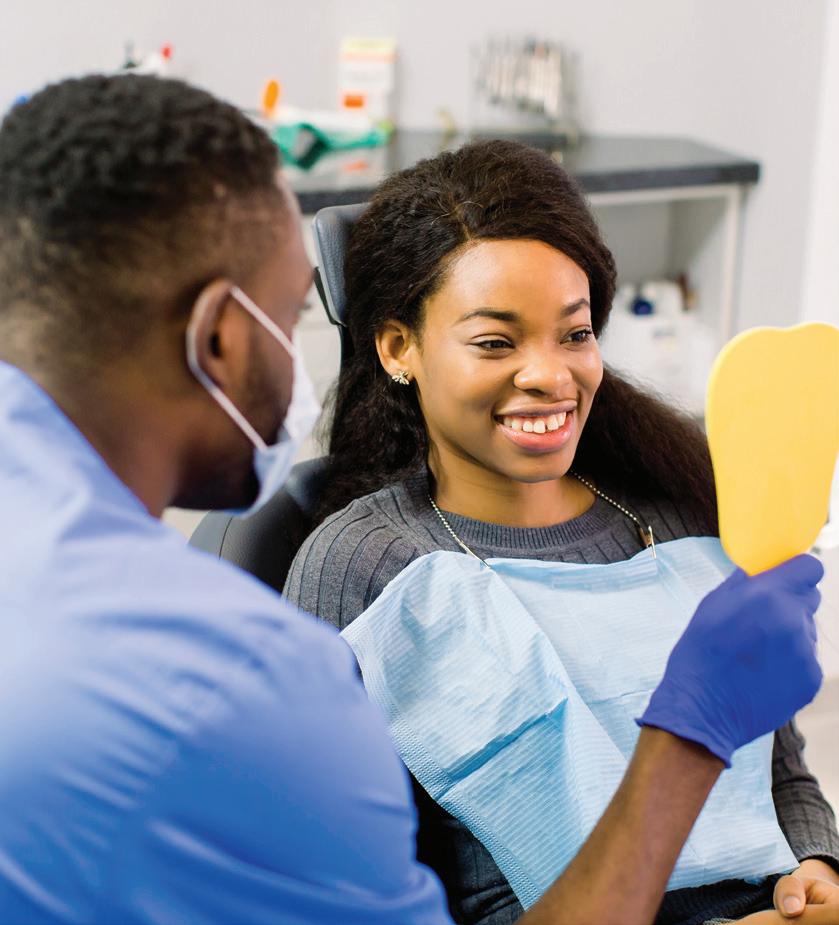






Special Feature: Exploring the Evolution of Toxin Practitioners discuss how botulinum toxin and its uses have developed over the last 20 years

Dr Rehanna Beckhurst describes the anatomy of the muscles of mastication
Dr Loredana Nigro shares her expertise on treating the intimate area
Dr
Clinical Contributors
Dr Rehanna Beckhurst is a cosmetic dental surgeon with a special interest in aesthetic medicine. She holds a Level 7 qualification and a postgraduate certificate in Aesthetic Non-Surgical Interventions. Dr Beckhurst is co-owner of ifab clinic in Barnstaple.


Dr Loredana Nigro worked in internal medicine in South Africa’s public health sector until 2009 and moved into aesthetic and antiageing medicine in 2010. She is now a senior aesthetic clinician at Riverbanks Clinic in Harpenden.
Mr Dalvi Humzah is a consultant plastic surgeon at PD Surgery in the West Midlands, Gloucester and The London Welbeck Hospital. He is also director of the award-winning Dalvi Humzah Aesthetic Training and clinical director of Derma-Seal Ltd.


Mr Tunc Tiryaki is a consultant plastic surgeon in facial regeneration. He was one of the first surgeons to use fat-derived stem cells for mini facelift procedures. Mr Tiryaki is the chair of the Humanitarian Programmes of ISAPS and founder of ISAPS-LEAP Surgical Relief Teams.
Serli Canikyan Turkay is a genetic bioengineer. She formerly worked as a research assistant at Harvard Medical School on stem cells and microchip technology. She is currently working as the chief research officer of Mane Biotech.

Contents • December 2022
News Special: Combining Facial Aesthetics and Dentistry Page 19
16 On the Scene
20
23
29
19
Experience First-Class Education at ACE Don’t miss out on two days of unmissable clinical insights and networking opportunities at next year’s ACE 2023
Innovations in Aesthetics Take a look at the innovative products showcased at CCR 2022 CLINICAL
34 CPD: Understanding Masseter Muscle Anatomy
41
43
Treating the Inner Thighs with EMSCULPT NEO A study claims 94% patient satisfaction with EMSCULPT NEO treatment
Rejuvenating the Hands
Mr Dalvi Humzah outlines a five-point plan for hand rejuvenation 49 Addressing Peri-Genital Hyperpigmentation
55 Understanding Exosomes
60 Robotic Hair Restoration in Modern Aesthetics How
and technology developments are revolutionising hair restoration 61 Abstracts A
and summary of useful clinical papers IN PRACTICE 62 Implementing Sustainability in Your Clinic
her advice on cost-effective changes to make a difference to the planet 65 Tackling the Recession
the recession will have
the
68 Introducing Trends in Your Practice
Mr Tunc Tiryaki and Serli Canikyan Turkay introduce exosomes in aesthetics
artificial intelligence
round-up
Rebecca Waters offers
Three business professionals discuss the impact
on
aesthetics specialty
trends driving the future
71 In
Eccleston
Dr Sophie Shotter shares five global
of aesthetics
Profile: Dr David
72 The
Manoeuvring the
Dr David Eccleston reflects on the aesthetic specialty’s growth
Last Word:
Metaverse in Aesthetics
74 The Aesthetics Reviewing
2022
Matthew Jarvie-Thomas debates the future of the metaverse in aesthetics
Panel
Exploring
Page
Aesthetics celebrates the success of our new peer-reviewing panel Special Feature:
the Evolution of Toxin
29 NEXT MONTH
IN FOCUS: SAFETY • Facial Danger Zones • Treating the Tear Trough
BUSINESS
CLINICAL
ULTHERAPY®


WE BRING THE EXPERTS TO YOU Live webinars Face-to-face events On-demand education
from industry experts that you can implement in your business today.
Advice
expertise on aesthetic treatments from industry-leading specialists.
Clinical
non-invasive anti-ageing treatment which stimulates the production of natural collagen. MERZ-AESTHETICS.CO.UK/EVENTS M-MA-UKI-2564 Date of preparation November 2022 JOIN OUR EXPERTS TODAY
Our
Shannon Kilgariff Editor & Content Manager @shannonkilgariff
Aesthetics is evolving. 2023 has been another year full of fascinating developments, new brands, new faces and new innovations. It’s wonderful to be a part of a specialty that’s so fast paced! This issue of the journal looks at the evolution and future of aesthetics, a topic which is so fitting to conclude 2023. Personally, I’ve noticed this year has been the Year of The Toxins! We hadn’t seen a new toxin hit the market since 2011, and then in the past 12 months or so, we have had three! Events I’ve been to recently have seen practitioners chatting about the newcomers –what’s the onset of action? How long are they lasting? Check out our article on p.29 where we answer some of these key questions for you. We also go through some of the latest innovations in aesthetics on p.23, the upcoming future of exosomes on p.55, the consumer trends you need to know for next year on p.68, plus much more! Another interesting discussion point is the metaverse! Our Last Word opinion article (p.72) is a must-read for anyone (like me) who is just
Clinical Advisory Board
a bit bamboozled by the whole concept. Notably, the discussions around regulation this year have been very promising, and I look forward to our continued work and relationships with the key industry associations pushing regulation forward.
I’d also like to take this opportunity to thank our Aesthetics Clinical Advisory Board for their help and guidance this year (check them out below), as well as our new Aesthetics Reviewing Panel (p.74)! Both groups have been integral in continuing to strengthen and increase the quality of content in the Aesthetics journal. Of course, thanks also must go to the whole Aesthetics team as well as the countless contributors we have had this year – all are on our website and each and every one of you has helped in making the journal such a must read for the aesthetics community.
Stay tuned for the exciting January issue, which will be announcing the 2023 Aesthetics Awards Finalists! Best of luck to all entrants, and make sure to get your Early Bird tickets!
Wishing you all the happiest and most joyous festive period, and I look forward to experiencing the future of aesthetics with you in 2023 and beyond.
Leading figures from the medical aesthetic community have joined the Aesthetics Advisory Board to help steer the direction of our educational, clinical and business content
Sharon Bennett is chair of the British Association of Cosmetic Nurses (BACN), previous UK lead of the BSI committee for aesthetic non-surgical standards, and member of the Clinical Advisory Group for the JCCP. She is a trainer and registered university mentor in cosmetic medical practice, and is finishing her MSc at Northumbria University. Bennett has won the Aesthetics Award for Nurse Practitioner of the Year and the Award for Outstanding Achievement.
Mr Naveen Cavale has been a consultant plastic, reconstructive and aesthetic surgeon since 2009. He has his own private clinic and hospital, REAL, in London’s Battersea. Mr Cavale is the national secretary for the ISAPS, president of the Royal Society of Medicine, and vice-chair for the British Foundation for International Reconstructive Surgery.
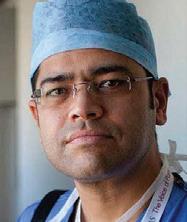
Jackie Partridge is an aesthetic nurse prescriber with a BSc in Professional Practice (Dermatology). She has recently completed her Master’s in Aesthetic Medicine, for which she is also a course mentor. Partridge is a founding board member of the British Association of Cosmetic Nurses and has represented the association for Health Improvement Scotland.
Mr Adrian Richards is a plastic and cosmetic surgeon with 18 years’ experience. He is the clinical director of the aesthetic training provider Cosmetic Courses and surgeon at The Private Clinic. He is also a member of the British Association of Plastic and Reconstructive and Aesthetic Surgeons and the British Association of Aesthetic Plastic Surgeons.
PORTFOLIO
Alison Willis • Director T: 07747 761198 | alison.willis@easyfairs.com
EDITORIAL
Shannon
T: 0203 196 4351 | M: 07557 359 257
shannon@aestheticsjournal.com
Holly Carver • Senior Journalist | T: 0203 196 4427 holly.carver@easyfairs.com
Ellie Holden • Journalist | T: 0203 196 4265 ellie.holden@easyfairs.com
Kate Byng-Hall • Journalist | T: 0203 196 4265 kate.byng-hall@easyfairs.com
DESIGN

Peter Johnson • Senior Designer T: 0203 196 4359 | peter@aestheticsjournal.com
Miss Elizabeth Hawkes is a consultant ophthalmologist and oculoplastic surgeon. She is the lead oculoplastic surgeon at the Cadogan Clinic, specialising in blepharoplasty and advanced facial aesthetics. Miss Hawkes is a full member of the BOPSS and the ESOPRS and is an examiner and fellow of the Royal College of Ophthalmologists.
Dr Tapan Patel is the founder and medical director of PHI Clinic. He has more than 16 years’ clinical experience and has been performing aesthetic treatments for more than 14 years. Recently, he was listed in Tatler’s Top 30 Anti-Ageing Experts. Dr Patel is passionate about standards in aesthetic medicine.



Dr Souphiyeh Samizadeh is a dental surgeon with a Master’s degree in Aesthetic Medicine and a PGCert in Clinical Education. She is the founder of the Great British Academy of Medicine and Revivify London Clinic. Dr Samizadeh is a Visiting Teaching Fellow at University College London and King’s College London.
ADVERTISING & SPONSORSHIP


Courtney LeBorgne • Event Director

T: 0203 196 4300 | M: 07818 118 741 courtney.leborgne@easyfairs.com
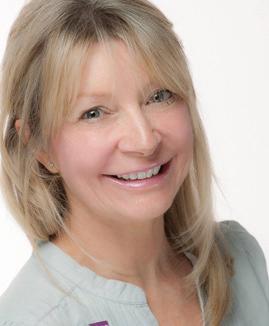
Judith Nowell • Business Development Manager T: 0203 196 4352 | M: 07494 179535 judith@aestheticsjournal.com
Chloe Carville • Sales Executive T: 0203 196 4367 | chloe.carville@aestheticsjournal.com
Emma Coyne • Sales Executive T: 020 3196 4372 | emma.coyne@easyfairs.com
MARKETING
Aimee Moore • Marketing Manager
T: 020 3196 4370 | aimee.moore@easyfairs.com
Emma Kurzyca • Marketing Assistant T: 020 3196 4306 | emma.kurzyca@easyfairs.com
WE WANT TO HEAR FROM YOU!
Do you have any techniques to share, case studies to showcase or knowledge to impart?
Email: editorial@aestheticsjournal.com
Dr Stefanie Williams is a dermatologist with a special interest in adult acne, rosacea and aesthetic medicine. She is the founder and medical director of multi-award winning EUDELO Dermatology & Skin Wellbeing in London, and creator of Delo Rx skincare. She is the author of three books and has published more than 100 scientific articles, book chapters and abstracts.
ARTICLE PDFs AND REPRO Material may not be reproduced in any form without the publisher’s written permission. For PDF file support please contact Chloe Carville, contact@aestheticsjournal.com
Aesthetics Media
© Copyright 2022 Aesthetics. All rights reserved. Aesthetics is published by Aesthetics Media Ltd, which is registered as a limited company in England; No 9887184 DISCLAIMER:
Editor’s letter
Aesthetics Journal @aestheticsgroup Aesthetics @aestheticsjournaluk
Sharon Bennett, Clinical Lead
the subject
The editor and the publishers do not necessarily agree with the views expressed by contributors and advertisers nor do they accept responsibility for any errors in the transmission of
matter in this publication. In all matters the editor’s decision is final. PUBLISHED BY
MANAGEMENT
Kilgariff • Editor & Content Manager
Talk #Aesthetics
Follow us on Instagram @aestheticsjournaluk

#Aestheticsjournal
Dr Sana Sadiq
@dr.sana.sadiq
Reading my latest article in the Aesthetics journal… my case study covers the challenges of taking on poor aesthetic outcomes.
#Symposium
Sharon Bennett @sharonbennettskin
It’s been a whirlwind few days of great education at GAIN by Galderma in Geneva.
#CCR
Dr Mayoni Gooneratne
@skinfit.drmayoni

Flashback to CCR London! It was such an honour to be on the CCR advisory panel.
#Panel
Dr Vincent Wong
@drvincentwong

Laser Clinics UK event with discussions and questions around the aesthetics industry – it was a great evening!.

#Event

Dr Pradnya Apte @drpradnyaapte Had an amazing time at the Gala Dinner with my fabulous friends, kindly hosted by Sinclair.
Regulation MHRA launches consultation on medical safety
The Medicines and Healthcare products Regulatory Agency (MHRA) has announced a consultation on how the agency engages with healthcare professionals, regarding medicines and medical devices.
The agency explains that the consultation will aim to improve safety surrounding the use of medicines and medical devices by ensuring medical professionals receive sufficiently accurate information and guidance from the MHRA.
Dr June Raine, MHRA chief executive, said, “All healthcare professionals want to deliver the best outcomes for patients, and we share this goal. Effective engagement and communication with healthcare professionals are therefore vital for the MHRA to support healthcare professionals and patients to make informed decisions about care and treatment.”
The consultation period closes at 11:45pm on January 18, 2023.
Advertising ASA rules against hydrocortisone ads
The Advertising Standards Authority (ASA) has upheld a complaint against an aesthetic clinic after it released two advertisements promoting prescription-only (POM) hydrocortisone injections. The initial adverts, posted by a clinic in Doncaster in August 2022, were promoting ‘steroid joint injections’, and showed a practitioner injecting a patient’s knee with hydrocortisone to treat painful joints. The clinic stated they believed that if they referred to the treatment as ‘hydrocortisone injections’ rather than a specific brand name, they would not be advertising a POM. However, the ASA stated in its ruling that because hydrocortisone is a type of steroid, which is a POM, the adverts breached the code. The clinic has since removed the advertisements, and will not repeat them.
Technology Study recommends AI healthcare training
New research published by the NHS AI Lab and Health Education England (HEE) has called for all health and care staff to receive training in artificial intelligence (AI). AI is projected to take on a more prominent role in healthcare in areas such as managing disease. The HEE report has recommended that education and training providers should prioritise AI-based education to prepare healthcare professionals, with advanced learning for specialists.
Brhmie Balaram, head of AI research and ethics at the NHS AI Lab, said, “For the NHS to wholly embrace new AI technologies so they are adopted equitably across the country, it is vital that we ensure all our staff receive appropriate training in AI.”
Reproduced from Aesthetics | Volume 10/Issue 1 - December 2022 @aestheticsjournaluk Aesthetics @aestheticsgroup aestheticsjournal.com Aesthetics | December 2022 8 Insider News @aestheticsjournaluk
Conference Teoxane announced as Headline Sponsor of ACE 2023

Aesthetic manufacturer Teoxane has been revealed as the Headline Sponsor of ACE 2023, which will take place at the Business Design Centre, London on March 10-11, 2023.
During the conference, Teoxane will host four masterclass symposiums for delegates, covering the fundamentals of assessment, anatomy, techniques and rheology.
The symposiums will contain several live demos, as well as talks from top aesthetic practitioners Dr Lee Walker, Dr Raul Cetto, Dr Ayad Harb, Dr Benji Dhillon, Mrs Sabrina Shah-Desai, Dr Saleena Zimri, Dr Tahera Bhojani-Lynch, Dr Wassim Taktouk, Dr Kam Lally, Dr Jeremy Isaac and Rachel Goddard. Jordan Sheals, deputy country manager of Teoxane commented, “Following the successful return of ACE in March 2022, Teoxane is thrilled to exhibit once again as the Headline Sponsor in 2023! Conferences such as ACE represent an excellent opportunity to shape and co-create the future of aesthetics, which is why in 2023, Teoxane will offer even more opportunities for healthcare professionals to engage with each other, with our expert faculty and with our science.”
Registration for ACE 2023 is open now! Scan the QR code to register for free.

Prescription
NMC clarifies remote prescribing guidelines
The Nursing and Midwifery Council (NMC) has released clarification on the guidelines for prescriptions, emphasising that remote prescribing for cosmetic and aesthetic purposes is not permitted.
The NMC has told Aesthetics that it is receiving a high volume of questions from nurses regarding prescribing and remote prescribing, hence felt a reiteration of the rules was necessary to ensure patient safety. The NMC highlighted that nurses are not permitted to prescribe prescription-only medicines for cosmetic/aesthetic purposes, including botulinum toxin, prescription weight loss treatments, hyaluronidase and triamcinolone acetonide (Kenalog), without an in-person medical consultation. The NMC reminds nurses of the Royal Pharmaceutical Society’s (RPS) Competency Framework, as well as section 18.1 of The Code which states that, ‘Those suitably qualified must only prescribe, advise on or provide medicines or treatment, including repeat prescriptions, if you have enough knowledge of that person’s health and are satisfied that the medicines or treatment serve that person’s health needs’.
According to the NMC, if nurses are found to have engaged in remote prescribing for cosmetic procedures, such as via a video or phone call, they are liable to be called before an NMC Fitness to Practise Committee panel. The sanctions which may follow could include a temporary caution, a temporary suspension or being struck off completely.
Vital Statistics
43% of almost 2,000 UK adults have considered non-surgical treatments as part of their regular grooming routine (Mintel, 2022)
In a survey of 4,000 respondents, one in four Black, Hispanic and multiracial women believe that society’s beauty standards are racist (DREAM, 2022)
Of 2,000 perimenopausal women, 67% experience anxiety and stress about their skin and body issues, compared to 60% of menopausal women (Dr Yusra Clinic, 2022)
A survey of nearly 5,000 UK students found that 43% of Gen Z never buy beauty products tested on animals (UNiDAYS, 2022)
In a survey of 2,000 British adults, 18% do not know the contents of the products they’re putting on their skin (Amatus Skin, 2022)
Of 600 41-50-year-old respondents, 84% are hesitant to undergo treatment due to concerns over safety and product quality (RARE: Group, 2022)
Reproduced from Aesthetics | Volume 10/Issue 1 - December 2022 @aestheticsjournaluk Aesthetics @aestheticsgroup aestheticsjournal.com Aesthetics | December 2022 9 Insider News
Events diary
10th February
Menopause in Aesthetics (MIA) www.menopauseaia.co.uk
10th-11th March
ACE 2023 www.aestheticsconference.com
11th March
The Aesthetics Awards 2023 www.aestheticsawards.com
Wellness
New event exclusively focuses on menopause in aesthetics
A conference focusing on the link between aesthetics and menopause has been announced for the new year.
The Menopause in Aesthetics (MIA) event will take place in February 2023, and will be chaired by aesthetic practitioners Dr Shirin Lakhani and Dr Mayoni Gooneratne, both of whom have an interest in women’s health and wellness.
According to the organising team, topics covered will include hormones, weight reduction, hair loss, functional medicine, nutrition, wellbeing, intimate health, genetics and more.
Event organiser Charlotte Body said, “Many women feel let down by their GPs when it comes to menopause, and aesthetic clinics are increasingly becoming the place they turn to. We believe the future of aesthetic medicine isn’t antiageing, it’s agelessness and longevity, and we are excited to put on an event that encourages discussion around this important issue and what can be done to create a holistic and 360-degree approach to menopause.”
MIA will take place at the Waldorf Hotel, London on February 10.
Body
Miss Korea finalists generate plastic surgery controversy
On October 26, the Miss Korea 2022 beauty pageant announced its winner in Seoul, South Korea – 23-year-old Lee Seung Hyeon. However, the event has garnered criticism after social media users claim surgery made the three finalists look too similar. South Korea has the highest global rate of plastic surgery per capita, with skin whitening, nose jobs and double eyelid surgery being wide-spread.
Popstar JLo partners with HydraFacial Pop sensation Jennifer Lopez –otherwise known as JLo – has announced a partnership with aesthetic treatment company HydraFacial. A new brightening HydraFacial JLo Beauty Booster has been launched in the US, with plans for the company to introduce it in the UK next spring. A video of JLo having a HydraFacial has nearly a million views on Instagram.
#Periodfacemask trends on TikTok In a new twist on ‘natural beauty’ the hashtag #periodfacemask is trending on video-sharing platform TikTok, with women using their own menstrual blood as a face mask. Various users claim the ‘beauty’ treatment is a way to connect to your femininity, but many dermatologists have said it can create an infection risk. The content has amassed a total of 6.4 billion views so far.
HydraFacial launches HydraBody protocols
Aesthetic treatment company HydraFacial has expanded its portfolio to treat a range of areas with HydraBody.
HydraBody includes treatments for the neck, back, buttocks, legs, hands and arms, utilising the three-step procedure of cleanse, extract and hydrate. According to the company, these treatments can be used to address conditions including keratosis pilaris, acne on the back or buttocks, or pigmentation and uneven skin tone.
HydraFacial UK country manager Lauren Gibson said, “Following demand from our loyal HydraFacial providers, we are delighted to launch the much-anticipated HydraBody protocols to the aesthetic market. As a brand, we have always aligned ourselves with a 360 approach to health and wellbeing, and the six new body protocols help HydraFacial fans benefit from skin health and confidence head-to-toe.”
Device
Eden
Aesthetics distributes new radiofrequency device
Aesthetic distributor Eden Aesthetics has acquired Novaclinical’s 4Plus quadripolar radiofrequency device. According to the company, 4Plus is designed to treat the face and body with variable radiofrequency, a radiofrequency safety system, ultrapulsed radioporation and the internet of medical things (IoMT) concept. The device also utilises dynamic quadripolar radiofrequency (DQRF) technology, which the company says allows the device to reach deep tissues. Lindsay Gray, managing director at Eden Aesthetics, commented, “With 4Plus, the tissue is treated in a natural, safe, comfortable and effective results-driven short session with no downtime. Thanks to painless procedures and with total comfort for the patient, no anaesthesia or cooling systems are required.”

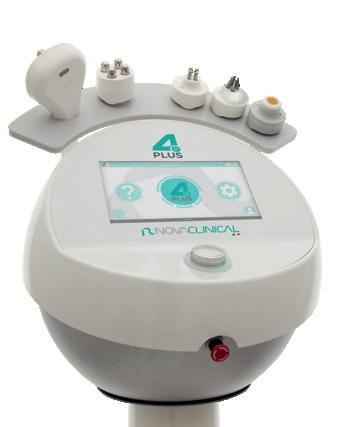
Reproduced from Aesthetics | Volume 10/Issue 1 - December 2022 @aestheticsjournaluk Aesthetics @aestheticsgroup aestheticsjournal.com Aesthetics | December 2022 10 Insider News
IN THE MEDIA
What’s trending in the consumer press
Awards
The Aesthetics Awards reveal judges for 2023
More than 80 judges for The Aesthetics Awards 2023 have been announced. The judges will evaluate the 25 categories at this year’s Awards, selecting Commended and Highly Commended entrants and Winners. The full list of judges can be found on The Aesthetics Awards website. The Finalists of The Aesthetics Awards 2023 will be revealed in the January issue of the Aesthetics journal and online. Shannon Kilgariff, editor and content manager of the Aesthetics journal, commented, “We are delighted to announce the fabulous judges for next year’s Aesthetics Awards. At Aesthetics, we pride ourselves on honouring the best quality results, research, practice and technology in the specialty, which is why our judges represent some of the best aesthetic practitioners and professionals in the industry. I’d like to thank them for their time, effort and support. We are looking forward to working with all the judges and welcoming you to the Awards in March!”
The Aesthetics Awards 2023 will take place at Grosvenor House, London on March 11, 2023. Turn to p.13 to get your discounted Early Bird tickets now.

New Yvoire filler launches
Aesthetic distribution company Church Pharmacy has announced the UK launch of Yvoire Y-Solution 720 dermal filler, manufactured by LG Chem. According to Yvoire, the filler utilises a S-HICE cross-linking method, with a high concentration of hyaluronic acid and low use of cross-linking agents, to create a ‘spring-like’ result with immediate volume. Dr Vikram Swaminathan, international KOL for LG Chem, said, “Yvoire Y-solution 720 is a very versatile product with impressive treatment results. From my experience, its unique combination of elasticity and cohesivity allows for easy injection and great results, even with minimal quantities, in the cheek, chin, jawline and lip areas.”


BACN UPDATES
Aesthetics / BACN Column / December 2022
//HEAD// BACN Regional Meetings
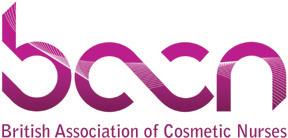
A round-up of the latest news and events from the British Association of Cosmetic Nurses BACN
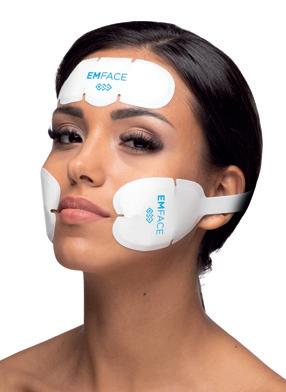
REGIONAL MEETINGS
October and November saw the second round of BACN Regional Meetings and get togethers before the start of a new year.
HIFES
BTL Aesthetics releases facial modelling technology
Aesthetic device manufacturer BTL Aesthetics has announced the release of its new EMFACE device – a hands-free, non-invasive device designed to smooth and tone the facial muscles. BTL says that the device uses simultaneous synchronised radiofrequency and HIFES (high intensity electric fields) energy, supposedly both increasing collagen and elastin levels and contracting specifically targeted muscles. Scott Mills, president of BTL, said, “When the innovative EMSCULPT surprised the aesthetics market in 2018, BTL committed to continued investment in creating an extensive pipeline of ground-breaking therapies. Utilising 20+ years of institutional knowledge, we have our sights set on tackling facial applications with EMFACE.”
October and November saw the second round of BACN Regional Meetings and the final get-togethers before the start of a new year.
Stopping at 10+ locations across the UK, members gathered for educational reviews and networking with fellow nurses.

Thank you to all our newly appointed regional leaders who guided the sessions members so well, and to our lovely members and guests who attended these some fantastic feedback and we’re looking forward to welcoming you back for
//INSERT
Stopping at 10+ locations across the UK, members gathered for educational presentations, peer reviews and networking with fellow nurses. Thank you to all our newly appointed regional leaders who guided the sessions and welcomed our members so well, and to our lovely members and guests who
IMAGE//
ANNUAL GENERAL MEETING
//SUBHEAD// Annual General Meeting
The BACN Board met on October 31 for our 2022 Annual General Meeting. The updates on regional and national events, charity status and the new Assessor
A new format for regional meetings is planned for 2023, building on 2022’s take forward all the best things already in place, while improving educational more opportunities for local events linked to networking and mentoring.
The 2023 Spring Symposium has also been confirmed and is to be held in London are excited that this will be an ‘advanced aesthetic practice’ event, specialised experienced members.
The BACN Board met on October 31 for our 2022 Annual General Meeting. The agenda covered updates on regional and national events, charity status and the new Assessor Training programme. A new format for regional meetings is planned for 2023, building on 2022’s successes. We plan to take forward all the best things already in place, while improving educational content and providing more opportunities for local events linked to networking and mentoring.
We are also in the process of setting up a separate charitable body to coordinate training activities with a focus on patient safety and protection for the public.
Finally, we have launched the BACN L3 Assessor Training programme in Aesthetics IQ, which has had a fantastic response so far
The 2023 Spring Symposium has also been confirmed and is to be held in London early next year. We are excited that this will be an ‘advanced aesthetic practice’ event, specialised for our more experienced members.
We are also in the process of setting up a separate charitable body to coordinate our education and training activities with a focus on patient safety and protection for the public.
Finally, we have launched the BACN L3 Assessor Training programme in Aesthetics alongside MAP-IQ, which has had a fantastic response so far. Members can find the full minutes from the Annual General Meeting in the Member’s area of the BACN website.
This column is written and supported by the BACN
Reproduced from Aesthetics | Volume 10/Issue 1 - December 2022 @aestheticsjournaluk Aesthetics @aestheticsgroup aestheticsjournal.com Aesthetics | December 2022 11 Insider News aestheticsjournal.com
Injectable
New clinic management software launches
Clinic management app AesthetiDocs has officially launched in the UK. AesthetiDocs provides aesthetic clinics with automation of booking and documentation systems, with the company saying its processes centre around a medico-legal safety ethos. Some of the services provided include online booking with deposits, online consent forms, patient before and after photos, face mapping treatments and revenue records, explains the company. Medical director of AesthetiDocs, Dr Bonny Armstrong, said, “I looked at the needs of many aesthetic practitioners and analysed what they wanted to make their clinic easier – for themselves, their staff and their patients. Combined with my expertise as a medical doctor and advanced aesthetician, I believe we have the software to revolutionise this industry.”
AesthetiDocs is happy to provide 60 days’ free subscription exclusively for paying Full Members of the Aesthetics community, using the code FREE60
Delo Rx releases rejuvenating product
Cosmeceutical skincare brand Delo Rx has released its new Youth Matrix Activator. The Youth Matrix Activator uses active ingredients in a QuadRetinoid Complex to provide antiageing effects: retinol, retinal, retinyl linoleate and hydroxypinacolone retinoate. According to the company, the Delo Rx range is designed specifically to treat adult women with skin prone to breakouts of acne, rosacea and periorificial dermatitis. Dermatologist and founder of Delo Rx, Dr Stefanie Williams commented, “In my work as a clinical dermatologist, I have spent decades treating those suffering as a result of adult acne and rosacea and observed their skins’ complex needs, and therefore recognised the demand for this unique range. Re-inventing the base formulations of products, in addition to putting together the most hard-working antiageing ingredients, we have optimised skin rejuvenation without aggravating breakouts.”
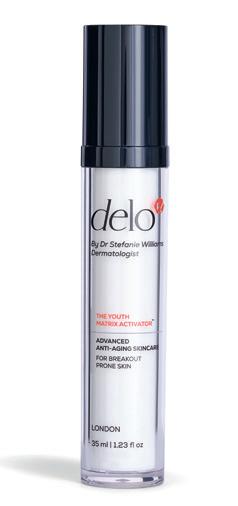
Aftercare
Skinade debuts three post-treatment products
Skin rejuvenation company Skinade has expanded its portfolio with a range of products to help medical practitioners care for patients following injectable treatments. SkinadeMD INsupport incorporates three elements – liquid sachets, capsules and a sublingual spray –to form a 10-day post-injectable course, which the company says is designed to mitigate bruising, swelling and inflammation. Piers Raper, CEO of Skinade, said, “SkinadeMD INsupport Injection Support Programme For Injection Perfection is the second addition to our important SkinadeMD product line, only available to medical professionals. Bruising and swelling from injectable treatments creates feelings of self-consciousness, and INsupport targets these from the inside, helping patients return to normal social activities sooner while enhancing treatment results. Our team is very excited and proud to be launching this innovative product to the injectable space.”

Development
AlumierMD unveils new Alumier Medical pharmacy
Medical-grade skincare brand AlumierMD has launched its new licensed pharmaceutical wholesaler and registered pharmacy, Alumier Medical. The company explains that Alumier Medical is available to doctors, dentists, independent nurse prescribers and independent pharmacist prescribers. The platform will allow prescribers to engage with growing demand in the aesthetic and dermatology market. The new pharmacy will stock a range of licensed and unlicensed medicines which complement AlumierMD professional and retail skincare. Sophie Gibb, superintendent pharmacist, said, “AlumierMD is a business built on the desire to support our professional community to deliver the best possible patient outcomes. Our commitment to that mission is never more evident than today, as we launch Alumier Medical; a wholesaling pharmacy service designed to ensure that we can offer a broader range of products and services to our professional community.”
Skin
Monkeypox symptoms added to dermatology register
The American Academy of Dermatology (AAD) and the International League of Dermatological Societies (ILDS) have added a monkeypox dermatology registry to the existing COVID-19 registry. The ADD/ILDS Dermatology COVID-19 Monkeypox and Emerging Infections Registry was founded after monkeypox symptoms were added to the COVID-19 registry, following the classification of the disease as a public health emergency in the US. Monkeypox also exists in the UK, with 3,600+ confirmed cases as of the end of October, 2022. The ADD/ILDS Registry is designed to help practitioners identify the dermatological symptoms of monkeypox, in turn aiding them in understanding treatment options. Dr Esther Freeman, dermatology professor at Harvard Medical School, said, “Monkeypox is particularly important for dermatologists to be aware of because the classic clinical course of the disease nearly universally encompasses a skin rash. Dermatologists are uniquely positioned to be able to recognise this and provide testing, treatment and guidance for patients.”
Reproduced from Aesthetics | Volume 10/Issue 1 - December 2022 @aestheticsjournaluk Aesthetics @aestheticsgroup aestheticsjournal.com Aesthetics | December 2022 12 Insider News
Automation
Skincare
Technology Obagi unveils new skincare device
Skincare brand Obagi has launched its first complementary skincare device Skintrinsiq in the UK and Ireland. The treatment begins with extraction and removes built-up debris and impurities from the skin’s surface. The second step is infusion, where Obagi medical products are applied to the skin and the vacuum infuses the product into the skin. Skincare protocols include Brightening, Clarifying, Firming and Antioxidant. LED benefits can also be integrated into the treatment. The final step is locking the Obagi products into the skin, explains the company.


Jaime Castle, Obagi president and CEO, said, “The unique design of the Skintrinsiq device, combined with its exclusive availability in medically trained clinics allows, healthcare practitioners to provide an efficacious treatment for the skin that capitalises on the science and heritage of Obagi products.”
Safety
New NHS aesthetic complications course
Aesthetic practitioner and BCAM trustee Dr Sophie Shotter has created a CPD-accredited complications course for NHS staff.
The training day will take place in London on February 25 and will enable staff to learn how to deal with aesthetic complications and how to refer severe cases. Dr Shotter explains that she has created the course with her peers to provide better treatment for those distressed, in pain and disfigured by aesthetic treatments.
She commented, “We are all too aware of the lack of regulation in the aesthetic sector, something which is hopefully changing. An understanding of who our patients are and their motivations, how to manage these problems acutely and who to refer onto will hopefully improve help available for victims of these procedures.”
Healthxchange launches online skincare platform
Aesthetic supplier Healthxchange has launched Clever Patient – a platform through which patients can purchase skincare offered by aesthetic clinics.
According to the company, the app allows Healthxchange customers to set up a virtual ‘storefront’ free of charge, through which patients can order the medical-grade skincare sold by clinics 365 days a year.
CEO of Healthxchange Jack Curran said, “Coming off the back of COVID-19 it was recognised that a mobile web app like Clever Patients could break down barriers further and make a major contribution to our clients’ profitability and time management. The new system has been beta-tested with a few select clinics since the summer and it’s now ready to be rolled out across the UK. We hope to expand the range of products available through the app sometime in the future.”
Enjoy a Night of Celebration
Join us for a night of festivities at the most prestigious event in the aesthetics calendar! The Aesthetics Awards returns with a bang on the evening of March 11, following two days of discovery, learning and networking at ACE 2023. Known as the ‘Oscars of Aesthetics’ the incredible achievements of our fantastic specialty will be commemorated during this glamourous event, making it the perfect place to dress up and celebrate with your team.
Don’t miss out on Early Bird tickets! After selling out quickly last year, The Aesthetics Awards has a new home for 2023 at the dazzling Grosvenor House, London. As well as giving you the opportunity to mix with the best of the best of the aesthetics specialty at a stunning location, purchasing an Awards ticket will also provide you with:
• A delicious three-course meal
• Live entertainment
• A glass of bubbly on arrival
• Professional photographs
• A celebrity host
• Afterparty
Spaces at the event are still extremely limited, so avoid missing out and make sure you purchase your tickets today at our exclusive Early Bird rate!
Connect with your industry Even if you aren’t shortlisted for an Award, the ceremony is still a great event to come along to and celebrate with the rest of the industry. All our incredible Finalists, judges, KOLs and top brands will be attending, so take the opportunity to come together and network with some key industry players. It’s also the perfect chance to unite your team and thank them for the last 12 months of hard work and dedication.
The Aesthetics Awards is a night any member of the aesthetic community simply cannot miss, so scan the QR Code below and get your Early Bird ticket now!
Scan the QR code to book your Early Bird tickets now!

Reproduced from Aesthetics | Volume 10/Issue 1 - December 2022 @aestheticsjournaluk Aesthetics @aestheticsgroup aestheticsjournal.com Aesthetics | December 2022 13 Insider News @aestheticsjournaluk Aesthetics @aestheticsgroup aestheticsjournal.com
App
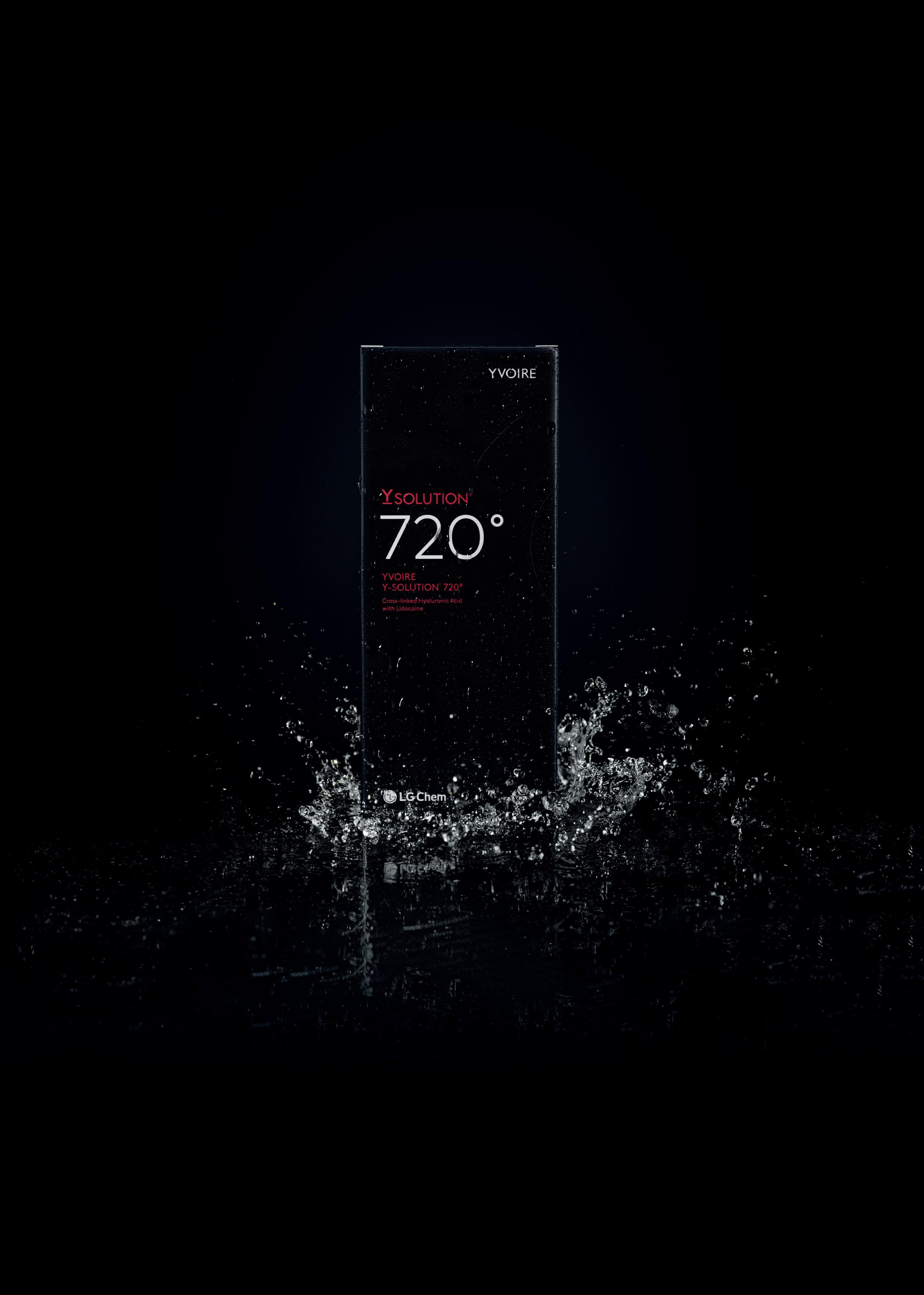

EXCLUSIVELY AVAILABLE AT Minimal patient swelling and discomfort High lifting capacity using low cross-linkers Y-Phasic dermal filler with high elasticity and cohesivity The New Solution ChurchPharmacyUK @ChurchPharmacy ChurchPharmacy.co.uk 01509 357300 info@churchpharmacy.co.uk
Charity #IAMME Living Foundation officially launches

A new foundation has been launched to provide the LGBTQ+ community with access to crucial health, wellbeing and aesthetic services.
Aesthetic practitioner Dr Vincent Wong and gut health and wellness practitioner Dr Sunni Patel officially launched the #IAMME Living foundation at an event held at ME Aesthetic Lounge in London on October 28. The event welcomed supporters and members of the LGBTQ+ community, and was hosted by Miss Universe Great Britain 2022 Noky Simbani. Dr Wong and Dr Patel explained that the mission of #IAMME Living is to provide holistic care to the queer community, as well as general queer health awareness and training for healthcare professionals and organisations. The services include medical aesthetics, wellbeing, mental health, primary care and surgery.
The foundation has two advisory boards. The first is a community advisory board consisting of members of the community to identify gaps in healthcare, and the second is a professional advisory board to help provide services to those who are in need and can’t afford treatments.
According to Dr Wong and Dr Patel, their vision is for the foundation to eventually go global. Dr Wong added, “This launch is such a big moment for our team, for the foundation and for the LGBTQ+ community. There is a lot of data suggesting that there is a limitation of access to healthcare for this community and a lot of these needs aren’t met by the NHS. We would like to allow people to feel better, be healthy and be their true selves, and our vision is to be the trusted health and care provider worldwide.”
Symposium
PCA Skin hosts day of learning and celebration in Manchester
On October 24, skincare brand PCA Skin’s Social Symposium offered an educational day in Manchester, followed by an evening of networking and awards.

At Manchester’s Menagerie Restaurant and Bar, the company welcomed delegates for a networking breakfast, followed by a morning of learning. The educational content was delivered by PCA Skin brand manager Lizzie Shaw, alongside PCA Skin international educators and nurse prescribers Sue Young and Lauren Asquith.
The topics covered were centred on advanced approaches to treating complicated skin concerns, addressing ageing, discolouration, acne and skin sensitivity. After this, delegates enjoyed canapés as the awards began, marking the achievements of PCA Skin stockists in creating excellent patient results through best industry practice, according to the company. Some of the categories included Best Brand Initiative, Best Combination Treatment Approach, Best Skin Transformation and Best Challenging Case. After the event, PCA Skin’s brand manager Lizzie Shaw said, “We created our Social Symposium to break the mould of how our practitioners learn. Therefore, we developed a fun-filled day of exceptional education with a twist. We were able to engage more with our stockists and strengthen our relationships. Through our very first awards ceremony, we recognised those who have worked hard with the brand to produce results that have truly changed lives. The feedback has been amazing, and we will definitely be holding more events like this next year!”
News in Brief
Sinclair releases new Ellansé injectable book
Pharmaceutical company Sinclair has published Ellansé An Expert’s Guide for practitioners who have completed Ellansé injection training. According to the company, the book’s eight chapters cover the anatomy of the face, the ageing process, patient selection and preparation and case studies. Anna Kremerov, nurse practitioner, commented, “This book is based on years of experience and systematically developed statements from the most experienced key opinion leaders to assist new and experienced practitioners in their professional development.”
Aesthetic Nurse Software redesigns website
Patient management software company
Aesthetic Nurse Software has unveiled a new design for its website, making the booking page and online forms more efficient and clinical, according to the company. Director of Aesthetic Nurse Software Max Hayward said, “The new design isn’t just about a new colour scheme and making it easier to navigate. We wanted to give our practitioners a system that represents the professionalism and high-quality experience they deliver in their clinics.”
5 Squirrels receives new accreditation Private label skincare manufacturer

5 Squirrels has achieved certification of conformance to standards in the manufacture and supply of cosmetic products. The ISO 9001:2015 is a recognised quality standards certification, developed by the International Organisation for Standardisation (ISO). Gary Conroy, CEO of 5 Squirrels, commented, “Achieving this certification is fantastic news. It means our valued customers have complete assurance that we operate to the highest quality standards and that all regulatory requirements are met for providing our products and services.”
Evenswiss launches hair growth range Cosmeceutical company Evenswiss has released a range of haircare products – a daily shampoo, conditioner and styling serum – to promote hair growth and reduce shedding, according to the company. Alex Petrone, vice president and board member of Evenswiss, said, “Evenswiss brings to the aesthetics world a proven and revolutionary system to rejuvenate skin and scalp. Dermatopoietin lets the tissue work in a more functional and efficient way. It is the first ingredient in aesthetics that does not penetrate the skin and acts as an endogenous factor.”
Reproduced from Aesthetics | Volume 10/Issue 1 - December 2022 @aestheticsjournaluk Aesthetics @aestheticsgroup aestheticsjournal.com Aesthetics | December 2022 15 Insider News
On the Scene
Out and about in the specialty this month
IAAFA conference and charity ball in Windsor
First MINT symposium held for beginners
HansBiomed, creator and distributor of MINT PDO threads, held an educational symposium for delegates who are beginners in thread procedures.
The event took place on November 12 at the JW Marriott Grosvenor House, London and was hosted by the MINT Education Board including aesthetic practitioners Dr Kam Lally, Dr Zunaid Alli, Dr Jeremy Isaac and Dr Chike Emeagi.

The symposium began with Dr Lally introducing MINT threads, the various products available in the portfolio and the suitable threads to use for facial indications, as well as announcing that the company will be launching a new cosmeceutical skincare line in 2023. Following this, Dr Isaac provided an in-depth talk on anatomy and patient assessment. The talk discussed different skin layers and the appropriate layer to place threads, the ageing process, as well as using threads in combination with fillers.
Aesthetic practitioner and dentist Professor Bob Khanna welcomed 220 delegates to the annual International Academy of Advanced Facial Aesthetics (IAAFA) conference and charity ball on November 19. The day encompassed a variety of clinical and business topics including botulinum toxin, the multi-faceted approach to facial aesthetics, enhancing the patient journey, sustainability, how to develop a successful clinic, how to get returning patients and social media.


Speaking at the conference was IAAFA founder and president Professor Khanna, business development consultant Ron Myers, aesthetic dentist Dr Rita Poddar, aesthetic practitioner Dr Manav Bawa, aesthetic practitioner Miss Sherina Balaratnam, aesthetic dentist Dr MJ Rowland-Warmann and journalist Alice Hart-Davis. The conference was followed by the IAAFA Awards and Charity Ball, supporting Make-A-Wish UK. There were more than 300 people in attendance, and £35,000 was raised on the night.
Following IAAFA, Professor Khanna said, “I am so delighted and humbled by the turnout at this year’s IAAFA Conference, Awards and Charity Ball. The feedback for both the educational content and the exhibition was excellent – it’s always such a pleasure to host the latest innovations at IAAFA. We also had our biggest ever turnout for the IAAFA Awards and Charity Ball. Not only did everybody thoroughly enjoy the night, but we were also able to raise more than £35,000 for Make-A-Wish UK. This wouldn’t have been possible without my amazing team, who help make this event such a success year after year.” IAAFA will return on November 25, 2023 at the De Vere Beaumont Estate, Windsor.
The second half of the symposium included some patient case studies using MINT threads, presented by Dr Emeagi. He showed videos of three different patient cases with various laxity concerns and discussed the techniques he used to achieve rejuvenated results. The final presentation looked into the complications and contraindications of using threads, with patient suitability being a key aspect.
Galderma’s GAIN event takes place in Geneva
Pharmaceutical company
Galderma hosted its inaugural GAIN (Galderma Aesthetic Injector Network) event in Geneva, Switzerland, highlighting what transformational aesthetic journeys look like for different patients.
The event on November 5-6 was centred around the company’s new AART (Assessment, Anatomy, Range, Treatment) and HITs (Holistic Individualised Treatments) approaches, which aim to deliver holistic facial treatments, explains the company. Over the two-day event, 43 delegates from the UK and Ireland learnt about patients of various ages, ethnicities and genders, and how AART and HITs can help practitioners put together holistic treatment plans to optimise results. Speakers included Galderma key opinion leaders Mr Jeff Downie, Dr Kuldeep Minocha and Miss Priya Chadha. Joanna Neal, brand manager for Galderma in the UK & Ireland, said, “We had an amazing two days in Geneva. It was a great opportunity for us to showcase the Galderma aesthetics portfolio and beyond to its full potential in this educational setting. The feedback has been overwhelmingly positive, and I speak for the entire Galderma team when I say it was a joy to connect with people and provide a fantastic networking opportunity.”
Reproduced from Aesthetics | Volume 10/Issue 1 - December 2022 @aestheticsjournaluk Aesthetics @aestheticsgroup aestheticsjournal.com Aesthetics | December 2022 16 Events On the Scene
Spotlight on complications at CMAC Conference
On November 19-20, the inaugural Complications in Medical Aesthetic Collaborative (CMAC) Conference was held at IET London: Savoy Place.
The two-day ‘New Frontiers’ event was hosted by aesthetic practitioner and chair of CMAC Dr Lee Walker, and saw 200 delegates gather from 28 countries around the world to learn more about aesthetic complication management. According to CMAC, the agenda aimed to cover the most common adverse events which can arise from aesthetic procedures, including vascular adverse events, delayed onset nodules, blindness, neuromodulators, infection, energy-based device complications and the use of hyaluronidase. Case studies of complication rectification were also presented by aesthetic practitioners Dr Jair Mauricio Cerón Bohórquez from Germany, Dr Jonathan Hopkirk from Australia and CMAC vice-chair Dr Cormac Convery.
The usefulness of ultrasound pre-, during and post-treatment was a particular highlight, as ultrasound research specialist Dr Leonie Schelke shared how the technology can be utilised to identify the deviances in facial anatomy in different patients, thus allowing practitioners to avoid danger zones.
Other speakers included aesthetic practitioner Dr Steve Weiner from Florida, dentist and aesthetic practitioner Dr MJ Rowland-Warmann, aesthetic practitioner Dr Steve Harris, consultant ophthalmologist and oculoplastic surgeon Mrs Sabrina Shah-Desai and clinical prescribing pharmacist Gillian Murray. Each session featured a panel discussion with the speakers, during which delegates’ questions were answered and debates regarding different areas of complication management were discussed. Reflecting on the event’s debut, Dr Walker said, “I am privileged and incredibly proud to have been a part of the first global conference dedicated to complications management. The speakers came from all corners of the world to generously share their knowledge and time with the focus on recognising, avoiding and managing complications associated with aesthetic intervention. The feedback was amazing and incredibly humbling. We can’t wait for next year’s event which will be bigger, better and educationally richer!”
Cadaver Masterclass takes place in Lyon with VIVACY
On November 15 and 16, French injectable manufacturer Laboratories VIVACY invited 40 UK aesthetic practitioners to the Faculty of Medicine in Lyon for two days of learning.
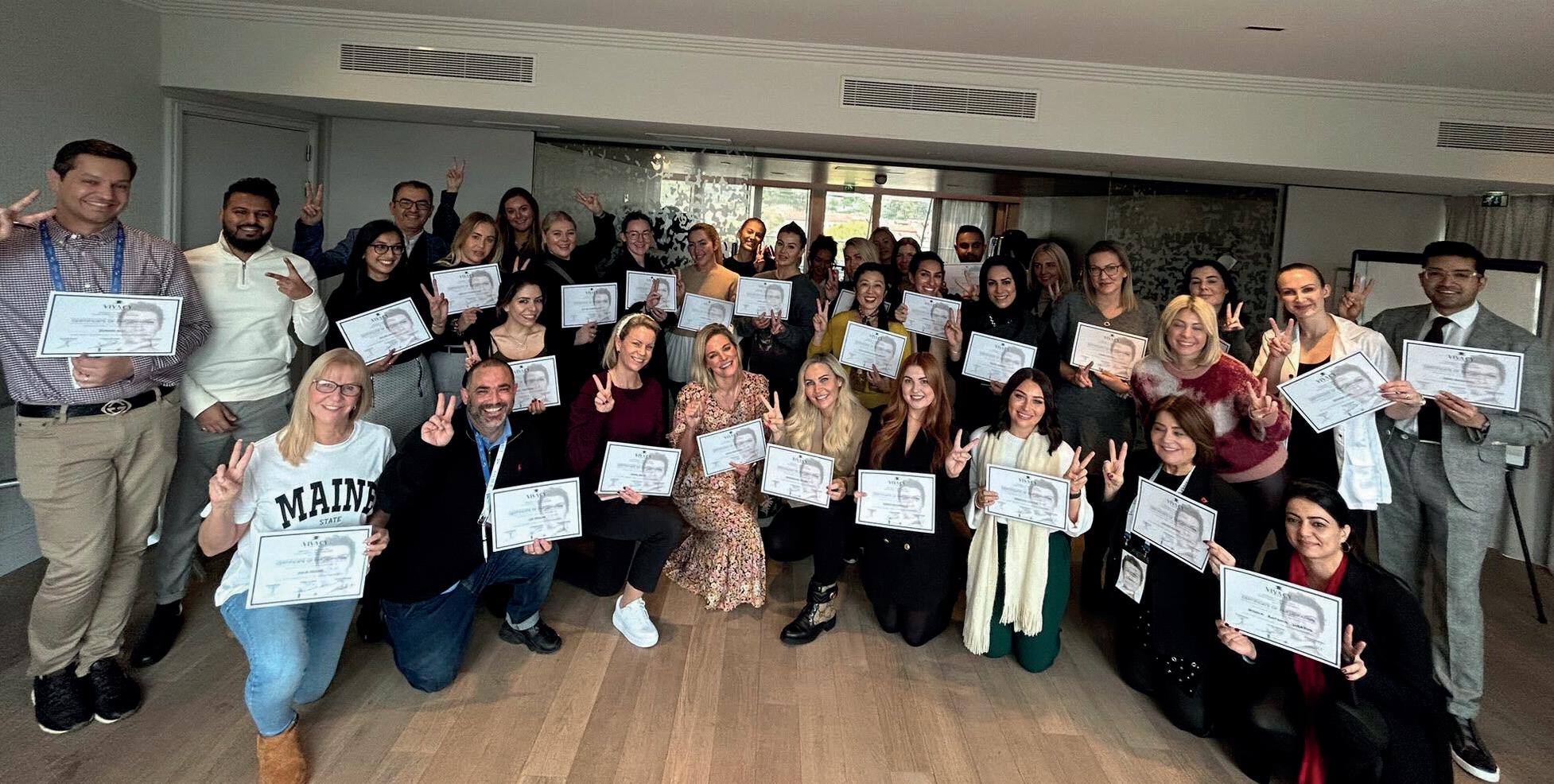

The masterclass included live anatomy dissections and injections for delegates to enhance their understanding of the facial arteries, and to help avoid complications when performing aesthetic procedures.
Discussions on clinical cases and danger zones were presented, focusing on each individual part of the face, as well as a variety of cadaver images and videos to highlight these areas to delegates before the live dissections.
Plastic surgeon Dr Fabien Boucher discussed the mid-face and tear troughs, reinforcing how they both work in synergy with each other, and clarifying the crucial areas to avoid when injecting.
Plastic surgeon Dr Sophie Converset presented on lips and the perioral area. She noted that there were eight points to sculpt the lips, including the vermillion border to the commissures. Dr Converset then moved on to exploring the lower face and neck area, reinforcing that practitioners should explain the Ricketts Line to patients during
consultations. The final presentation was with plastic surgeon Professor Ali Mojallal, focusing on the nose and nasolabial folds. After a short break, delegates were asked to put on hair nets, gloves, aprons, face masks and shoe protectors before entering the dissection room. Cadavers were already present with a sheet placed over their heads except for one, which had half of its face already dissected to show delegates the different anatomical layers and arteries. Delegates were then split into six groups and spent one hour dissecting the mid-face
to inject STYLAGE fillers and try different techniques with the oversight of the surgeons. After a lunch break, delegates dissected and injected the nose, nasolabial folds, lips and lower face.
The following day, delegates were invited to watch three live injectable demonstrations. The first two were performed by Dr Converset, focusing first on the temples, cheeks and chin, before the nose, jawline and chin were injected. A presentation on STYLAGE dermal fillers, its IPN-like technology and viscoelastic properties were then discussed by scientific communications officer, Pauline Dadre. The final injectable demonstration was performed by aesthetic practitioner Dr Tatiana Lapa, who treated the glabellar and
Reproduced from Aesthetics | Volume 10/Issue 1 - December 2022 @aestheticsjournaluk Aesthetics @aestheticsgroup aestheticsjournal.com Aesthetics | December 2022 17 Events On the Scene


Combining Facial Aesthetics and Dentistry
When evaluating a patient, practitioners tend to look at all the features of the face in harmony to produce a beautifully natural result. But do you also look at your patient’s teeth when conducting facial examinations? With the global market for cosmetic dentistry predicted to grow at an annual rate of 5%, increasing its value to an estimated £21 billion by 2026, it might be time to work in synergy with a dentist or dental clinic to create full-facial harmony for your patients.1,2
With social media being a constant platform for information in patients’ everyday lives, dental practitioners have started to see a rise in procedures sought through this platform. According to a new study of 377 participants, 90.7% of dental practitioners believe there has been an increase in demand for cosmetic dental procedures, and social media is a major contributor to it.3 Concerning popular procedures, teeth whitening (54.7%), Hollywood smile (white, straight and aligned teeth – 17.1%), dental veneers (11.9%) and Invisalign (10.4%) were the most requested.3 Patients showed a desire for these procedures because they were trending on social media.3
To find out more about the rise of cosmetic dentistry and what this means for the non-surgical aesthetics specialty, we spoke to vice president of the British Academy of Cosmetic Dentistry (BACD) Dr Sam Jethwa and the organisation’s communications director Dr Sheila Nguyen. Dr Jethwa conducts only cosmetic dentistry but has a good referral process in place for facial aesthetics, and Dr Nguyen is a previous dentist turned aesthetic practitioner full-time.
Awareness through social media
In an ever-growing industry, it can be difficult to differentiate yourself in a competitive market, with many turning to social media to promote their results. Almost half of the general dental practitioners in the study used social media for this purpose.3
Much like the non-surgical facial aesthetics field, Dr Jethwa acknowledges the rise of social media within the cosmetic specialty and believes influencers have been a driving force behind this. He notes, “Social media is a powerful tool and the rise in requests for cosmetic dentistry is partly a result of patients being able to see before and after photos of real results – not only of dentistry but facial aesthetic improvements too. This allows patients to realise that the smile is just as important as the face and both work in harmony together.”
Dr Nguyen agrees with this and has personally seen a rising demand across dental practices for facial aesthetic treatments. “We are seeing an increase in patients asking dentists whether they do facial aesthetics and feeling comfortable to discuss this. However, many dentists don’t do facial aesthetic procedures themselves, so I receive a lot of personal referrals,” she explains.
Working in partnership
Both Dr Jethwa and Dr Nguyen agree that to achieve facial harmony for patients, all practitioners should observe the full-face, including the smile and teeth. They believe practitioners of all disciplines should
have a referral pathway or partnership in place so that patients have access to both cosmetic dentistry and facial aesthetics to optimise outcomes. Building trusted relationships are key here, and not enough practitioners are working in partnership
Dr Jethwa says, adding, “More education is always needed as there is still limited awareness amongst dentists on why they would modify a patient’s lips or why the jawline is relevant to the design of the teeth.
Even if dentists don’t offer aesthetic treatments, it’s still important to have the understanding and knowledge of facial aesthetic treatments so they can advise patients and refer them to get a better result.”
Dr Nguyen believes facial aesthetics and dentistry are a fantastic blend, and having a referral pathway in place is pivotal. She says, “There is a lot that happens around the mouth and ageing teeth, such as perioral lines and pigmentation. Therefore, dentists shouldn’t just produce a beautiful smile, and facial aesthetic practitioners shouldn’t just produce beautiful lips. Practitioners and dentists should, therefore, work in synergy with each other.”
Dr Nguyen adds that the best way to start conversations around referral pathways is to contact dental and aesthetic associations such as the BACN, BCAM, BACD and BDA, attend industry events and conferences such as ACE, BDIA and CCR, speak to colleagues for recommendations or contact reputable dentists on social media.
A collaborative industry
Achieving the best results for your patients is the aim of every aesthetic practitioner, so building relationships, pathways and referrals with a cosmetic dentist might be the future of this evolving specialty. Dr Jethwa concludes, “There is still a separation between facial aesthetics and dentistry when there is a huge overlap. I think the issue is that most dentists aren’t performing aesthetic treatments alongside dentistry, so our patients aren’t linking dentistry and facial aesthetics together, instead acknowledging them as two separate entities. It is our prerogative to change this by educating and advising patients, as well as practitioners, to achieve the best results.”
Referral guidelines
When you have a referral pathway in place, it’s important to abide by your professional register’s code for referrals. The GMC, GDC and NMC all have slightly different guidelines, but all mention the importance of ensuring that the referral is in the best interests of the patient rather than your own, only accepting referrals if you are trained or competent to carry out treatment and to not accept any inducement gift, payment or hospitality that could appear to affect your professional judgement.4-7
Reproduced from Aesthetics | Volume 10/Issue 1 - December 2022 @aestheticsjournaluk Aesthetics @aestheticsgroup aestheticsjournal.com Aesthetics | December 2022 19 News Special Aesthetics & Dentistry
Following a rise in cosmetic dentistry procedures, Aesthetics investigates whether professionals are working collaboratively to achieve facial harmony
VIEW THE REFERENCES ONLINE! AESTHETICSJOURNAL.COM
Business tips at the In Practice
Set your clinic aside from the competition and advance your business knowledge at our In Practice theatre, learning the latest insights for topics such as social media, patient relations, marketing and finance. Sponsored by booking platform PLIM, these sessions will be led by entrepreneurs and established practitioners, making it the perfect place to discover essential commercial support to drive the success of your business. As soon as you step out of the sessions, you can also source free advice directly from the companies, who will be situated right outside the In Practice theatre.
Symposiums and Masterclasses
Experience First-Class Education at ACE
After an incredible CCR 2022, plans are well under way for your next medical aesthetics meeting, ACE 2023! Taking place on March 10 & 11 at the atmospheric Business Design Centre in Islington, London, ACE is your go-to event to discover, learn, network and celebrate with your colleagues and peers. This year we’re enhancing all your favourite features, introducing new clinical content and adding more exciting elements to give you the ultimate non-surgical aesthetic learning experience. And don’t forget, the prestigious Aesthetics Awards will take place after the second day of the conference –making these dates a must for your diaries.
20 years of changing lives with TEOXANE
Our Headline Sponsor TEOXANE will host four FREE masterclass symposiums in the Main Auditorium, covering the topics ‘Beauty is Personal’ and ‘Every Lip is Unique’. The unmissable programme will be led by world-leading medical practitioners including:
• Dr Lee Walker
• Dr Raul Cetto
• Dr Ayad Harb
• Dr Benji Dhillon
• Mrs Sabrina Shah-Desai
• Dr Saleena Zimri
• Dr Tahera Bhojani-Lynch
• Dr Wassim Taktouk
• Dr Kam Lally
• Dr Jeremy Isaac
• Rachel Goddard
Experience a first-hand look at how these experts utilise the TEOXANE filler range, telling you their invaluable tips and techniques as well as conducting live demonstrations.
The industry’s top pharmaceutical brands will showcase their innovative techniques in our symposiums, featuring leading aesthetic practitioners across the two days. Enhance your skillset by watching live demonstrations from companies such as Galderma, Prollenium and Novo Nordisk and receive in-depth guidance for injectable success!
You can also refine your treatment skills and expand your clinic offering by attending our Masterclasses, hosted by top KOLs from the specialty’s leading brands, including Church Pharmacy, Croma, HA-Derma and SkinCeuticals.
The latest innovations in aesthetics
Discover how you can develop your clinic offering at the Innovation stage, through workshops and demonstrations from the industry’s most trusted and respected


Reproduced from Aesthetics | Volume 10/Issue 1 - December 2022 @aestheticsjournaluk Aesthetics @aestheticsgroup aestheticsjournal.com Aesthetics | December 2022 20 Event Preview ACE
miss out on two days of unmissable clinical insights and networking opportunities
Don’t
Set your clinic aside from the competition and advance your business knowledge at our In Practice theatre
community. From brand-new injectable launches to time-saving tech and clinic support services, you can discover endless new solutions to improve your practice and patient experience. Brands will often host mini talks, demos and Q&As on the show floor that you can drop in and out of as you enjoy your time at ACE. More information coming soon.
The Oscars of Aesthetics
What better way to round off two days of incredible education and learning than to attend the biggest event in the aesthetics calendar?
This year The Aesthetics Awards will once again take place after the second day of ACE, recognising the achievements of practitioners, clinics, suppliers, products and other aesthetic companies. This proved a huge success in 2022, with tickets selling out weeks before the event.

The Awards are the perfect place to come together and celebrate the last 12 months, so make sure you purchase your ticket at our exclusive Early Bird rate. Single tickets or tables of 10 are available and places are extremely limited, so make sure you get yours today to avoid disappointment!
companies. Hosted by top clinicians, these sessions provide you with exclusive access to the latest innovations and products set to take the specialty by storm. Expect cutting-edge sessions from AestheticSource, Cutera, VIVACY and more.
Unite with the industry
As well as being able to discover all the latest education in non-surgical medical aesthetics, ACE provides delegates with

the perfect opportunity to unite with friends and colleagues. Sponsored by HydraFacial, the networking drinks taking place after the first day of the conference will give you a chance to catch up and discuss the day with your peers, all while enjoying refreshments and a glass of bubbly! Dedicated drinks and refreshments will be available throughout the conference, so be sure to register early to get all the updates on networking opportunities with your favourite brands, speakers and associations. We are also delighted to have HA-Derma returning as our VIP sponsor, to offer our speakers and Aesthetics Awards Finalists a dedicated area to network throughout the two days.
Discover the latest products
In addition to the first-class content available, ACE is also renowned for hosting the leading products and suppliers to the aesthetics

Don’t forget that Finalists for The Aesthetics Awards will be revealed in the January journal – good luck to everyone who entered!
SCAN TO REGISTER FREE
Headline Sponsor
Reproduced from Aesthetics | Volume 10/Issue 1 - December 2022 @aestheticsjournaluk Aesthetics @aestheticsgroup aestheticsjournal.com Aesthetics | December 2022 21 @aestheticsjournaluk Aesthetics @aestheticsgroup aestheticsjournal.com Event Preview ACE

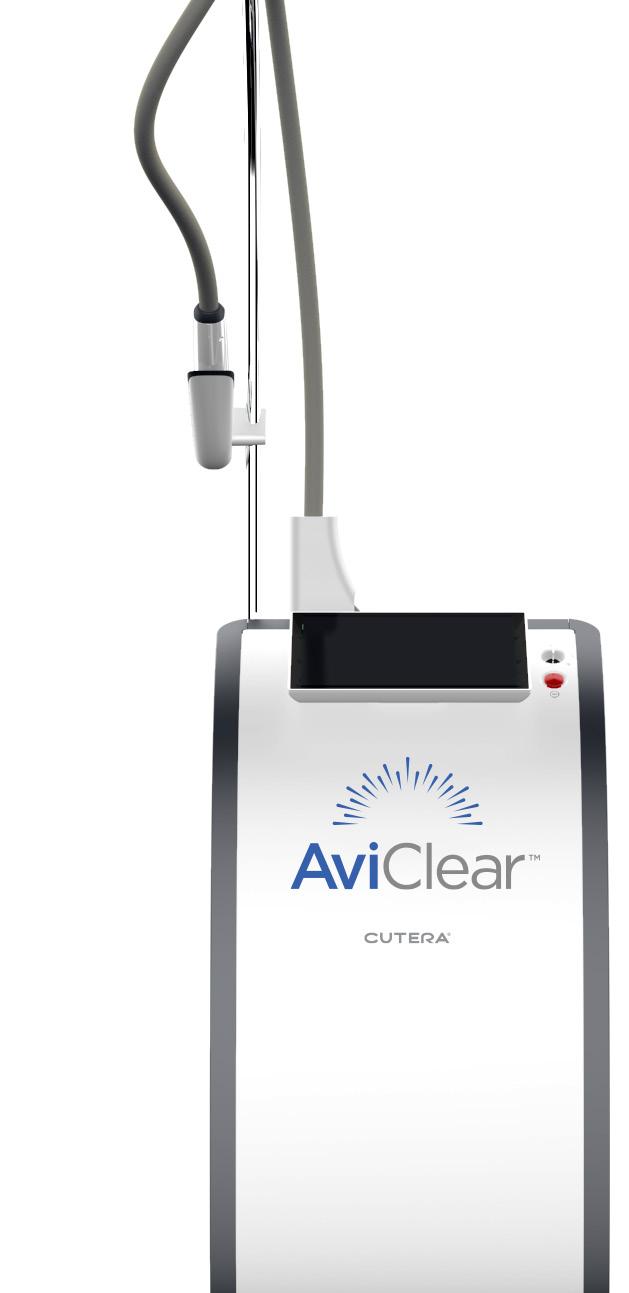




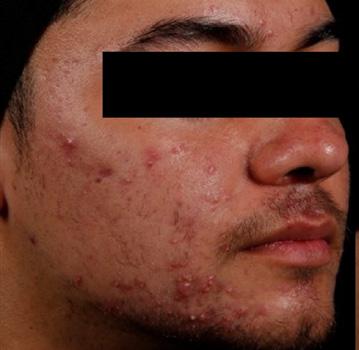
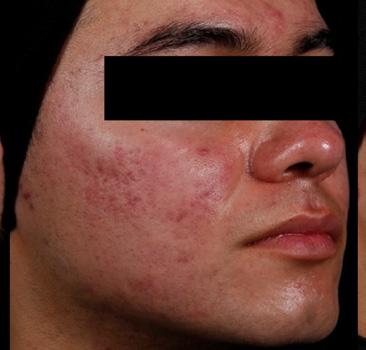
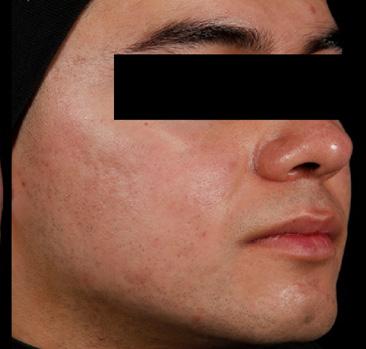

first and only FDA-cleared energy device for the treatment of mild to severe acne. INTRODUCING THE
worrying
acne Reference: 1. Data on file. Cutera, Inc. ©2022 Cutera, Inc. All rights reserved. AP003733 rA (03/22) Register Interest Helps prevent future acne No prescriptions needed Results continue to improve with time1 Safe for all skin types 6 Months After Final Treatment Session Before 12 Months After Final Treatment Session COMING SOON
A future without
about
Innovations in Aesthetics


Take a look at some of this year’s innovative products showcased at CCR 2022
In an evolving specialty like aesthetics, practitioners are constantly searching for the latest innovations and products to add to their clinic offerings to improve results and patient wellbeing.
A new addition to CCR this October was the Innovation Trail, which
showcased 10 new and exciting products, companies and brands that launched innovations this year!
We’re casting a spotlight on these new innovations and finding out the science behind them.
ASCEplus
SRLV and HRLV by EvoCyte
About
ASCEplus SRLV is a skin rejuvenating product containing five billion exosomes in combination with high viscosity hyaluronic acid, 10 types of growth factors, six types of peptides, NAD+, DMAE and glutathione. The company claims it helps improve rosacea, melasma and eczema.

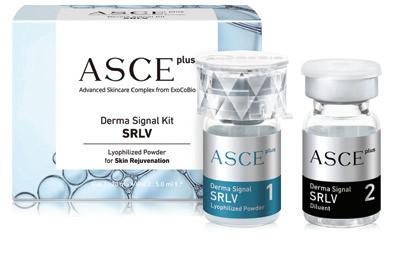
ASCEplus HRLV is a scalp care treatment containing 10 billion exosomes with 10 growth factors, 30 types of nutrients, biotin and copper tripeptide. The company explains that the product helps with male and female pattern hair loss.
The science Studies conducted by the company highlight that ASCEplus SRLV exosomes increased the production of collagen by 600% and elastin by 300%. Meanwhile, ASCEplus HRLV exosomes increase dermal papilla hair cell proliferation by 30%, reduce inflammatory cytokines by 55% and normalise the hair cycle.1
What practitioners say
Dr Irfan Mian, medical director at Chinbrook Medical Cosmetic Centre, said, “I have been using ASCEplus SRLV exosomes in my clinic for the last five months. The results have been impressive, with patients reporting significantly improved skin quality and looking more youthful.”

AviClear by Cutera
About AviClear is the first US Food and Drug Administration (FDA)-cleared energy device for the treatment of mild, moderate and severe acne. It’s a laser that uses a 1726 nm wavelength to resolve acne at the source by selectively targeting the sebocytes and suppressing sebum production. The device will be launching in 2023.
The science
In a clinical study of 104 patients enrolled to undergo three treatments, one, three, six and 12 months apart, 80% of patients had more than 50% reduction in inflammatory lesions with 91% responding after three months.2
What practitioners say Board-certified dermatologist Dr Jeffrey Dover commented, “Topical therapies yield temporary results and oral medications present several challenges. AviClear offers patients a safe, well-tolerated, drug-free approach with durable results, which significantly shifts the treatment paradigm for acne.”
Dermalux Compact Lite by Aesthetic Technology Ltd
About
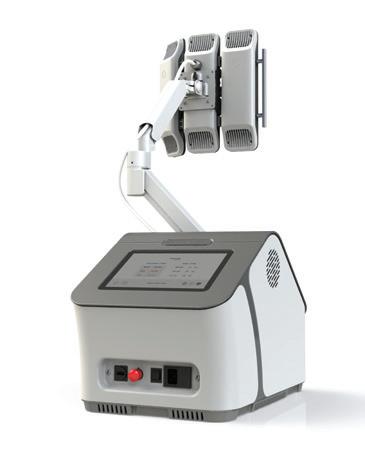
This new LED device uses Tri-Wave MD technology to reduce redness and hyperpigmentation, as well as rejuvenate blemish-prone skin. The product has an adjustable LED panel design, which enables versatile positioning for use with a treatment couch or chair.
The science
In a clinical study of the Tri-Wave MD device, 20 adult patients were treated for facial hypervascularisation separated into a LED-group and IPL-group. Results showed that treatment with combined red and near-infrared light-emitting diodes reduced the excess of facial vascularisation with moderate outcomes compared to IPL (70% of the results within four weeks compared to three months of IPL treatment).3
What practitioners say Dr Aneesha Ahmaed, director at Skyn Doctor, said, “We are seeing improvements in skin conditions after three treatments. I would recommend the Dermalux Tri-Wave MD device and look forward to the launch of the Compact Lite device.”
Reproduced from Aesthetics | Volume 10/Issue 1 - December 2022 @aestheticsjournaluk Aesthetics @aestheticsgroup aestheticsjournal.com 23 Aesthetics | December 2022 @aestheticsjournaluk Aesthetics @aestheticsgroup aestheticsjournal.com Spotlight On Innovative Products

Dermatopoietin skincare by Evenswiss UK



HArmonyCa by Allergan Aesthetics
About
This is a new skincare range based on patented technology Dermatopoietin, which aims to mimic a natural signalling cytokine found in the skin and help regulate the tissue and regeneration. Every product contains Dermatopoietin, however, each is tailored to different skin concerns. The range includes cleansing products, skincare and haircare, from serums to shampoos.
The science
In a clinical study of 22 female volunteers, all showed a significant increase of skin density accompanied by an average increase of skin elasticity by 15-21% after 28 and 56 days, respectively.4
What practitioners say
Miss Rachna Murthy, consultant oculoplastic and aesthetic surgeon at Face Restoration, said, “We’re delighted to offer our patients Evenswiss products. The brand has developed a cult following among patients who have found a reduction in redness and puffiness of the under-eye area with the Rejuvenating Eye Complex and Rejuvenating Serum as early as two weeks after beginning use.”

Human Health by Dr Mayoni Gooneratne
About
Founded by aesthetic practitioner Dr Mayoni Gooneratne, Human Health is the health and wellness arm of her aesthetic clinic. The focus is on the importance of implementing mental health support in aesthetic clinics, while introducing more wellness-focused services such as weight management and health supplements.
The science
More than 97% of 68 people have seen a significant change in their health outcomes, and a further 98% of people would recommend the service to family and friends.6
What practitioners say Dr Gooneratne said, “Without wellness, we are nothing. What we see and hear in aesthetic clinics is patients unhappy with their skin, but that’s only because they can see something’s not right with it. It’s so important to address wellness first, and I hope to see this developing over the coming years.”
About HArmonyCa is a hybrid injectable treatment combining hyaluronic acid (HA) and calcium hydroxyapatite (CaHA). The product offers a dual effect, with the HA causing immediate lifting and the CaHA stimulating new collagen production. According to the company, the product is intended for facial soft tissue augmentation via injection into deep dermal and sub-dermal layers.
The science
In a study conducted by Allergan Aesthetics, more than 90% of 162 patients reported an improvement in the general appearance of facial areas following treatment.5
What practitioners say Aesthetic practitioner at PHI Clinic Dr Tapan Patel said, “I always felt there was a missing piece from the treatments we had to offer our patients. We had great innovations for building volume, treating pigmentation and improving skin texture, but there were a lot of patients who we couldn’t help. That’s why we have a place for the new hybrid HArmonyCa collagen-stimulating injectable, which combines CaHA and HA in a single syringe for both an immediate and sustained lifting effect.”
HIT methodology by Galderma
About Taking a new holistic approach towards aesthetics, Galderma teaches the use of AART – Assessment, Anatomy, Range and Treatment in order to deliver its new concept ‘Holistic Individualised Treatments’ (HITs). The aim is to provide a simplified approach to facial aesthetic needs based on cross-usage of products for different areas of concern.
The science
Using the Restylane Eyelight products, 88.6% of 3,265 people reported looking less tired and 91.4% of people still felt attractive due to the improvement in their dark circles after six and a half months after the first treatment.7
What practitioners say Aesthetic trainer at Acquisition Aesthetics Miss Priya Chadha said, “Galderma is launching HITs to the aesthetics world – a holistic approach towards treatment for patients, following a methodology that helps patients discover how treatments can work in conjunction to achieve natural and beautiful results.”
Reproduced from Aesthetics | Volume 10/Issue 1 - December 2022 @aestheticsjournaluk Aesthetics @aestheticsgroup aestheticsjournal.com 25 Aesthetics | December 2022 Spotlight
Innovative Products
On
















TIME+ by Nuchido
About
A new oral supplement which aims to restore cellular nicotinamide adenine dinucleotide (NAD+) levels, slowing ageing and transforming skin from the inside. According to the company, the supplement increases the body’s NAD+ levels to support cellular function and maintain health and performance.
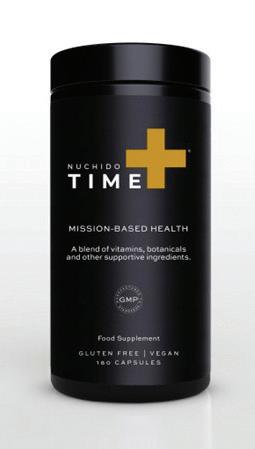
The science
NAD+ levels were measured in the blood cells of two human volunteers before, during and after taking Nuchido TIME+ for 16 days. During the 16-day supplement period, NAD+ levels increased by an average of 242% above baseline levels.8
What practitioners say
Dr Steven Land, aesthetic practitioner at Novellus Aesthetics, commented, “The insights I’ve gained from Nuchido have really educated me on the emerging field of cellular ageing and the latest best practice in addressing it. This has helped me not only diversify my current services, but also consider how my business needs to develop in the future to stay current and capture this new market coming to the UK.”
SUPERB technology by Sofwave
About
Receiving clearance from the US FDA, the SUPERB technology by Sofwave aims to lift the eyebrow, lax submental and neck tissue while improving facial lines and wrinkles. The technology generates heat at the appropriate depth to trigger neocollagenesis, which increases and regenerates collagen in the skin for a rejuvenated effect.
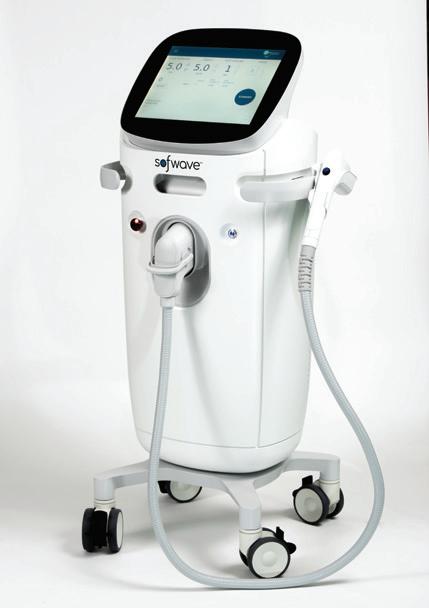
The science
A clinical study evaluating SUPERB technology in treating facial lines and wrinkles took place by the company. 60 patients were enrolled, with 58 completing the study across two sites. Results demonstrated that the blinded reviewers correctly identified the pre- and post-treatment photographs for 78% of treated subjects, and assessed a reduction of a least one unit using the Fitzpatrick Wrinkle and Elastosis Scale in 78%.10
What practitioners say
Dr Munir Somji, founder and director of Dr MediSpa clinics, explained, “I have always been an advocate of ultrasound technology to help improve the skin for some of the most common concerns – laxity, fine lines and wrinkles and overall tone and texture. Not all ultrasound is created equal, and Sofwave has managed to achieve exactly what is needed to get optimal results with just the right amount of energy and depth.”
Topilase by Prollenium
About
Topilase is a topical hyaluronidase enzymatically complexed with botanical polysaccharides that can dissolve HA filler. The product, created by Canadian-based filler manufacturer Prollenium, is a skin serum which aims to allow minor filler complications to be corrected without risk or trauma.

The science
In a clinical study, 17 females aged 23-54 with chronic post-filler contour irregularities received one to three topical treatments with Topilase. Two to four weeks after final treatment, physician-assessed contour improvement was 8-10/10 for seven patients, 5-7/10 for six, 1-4/10 for three and 0/10 for one patient. 15 patients evaluated their skin as more uniform. Satisfaction scores were 7-10/10 for 13 patients, 6/10 for two and 0-1/10 for two.9

What practitioners say
Dr Emily Mehta, medical director of Harley Academy and STORY clinics, said, “Topilase is particularly useful in the under-eye and lip areas, which is where I see more than 90% of filler problems. Both areas are easily over-treated by less experienced practitioners and can also occasionally cause product migration. The process is completely painless – it is simply a serum that is rubbed into the area where filler needs to be reduced or removed.”
To find out more about the innovations, as well as the trends over the past year, scan the QR code to read the full Trends Report released at CCR.
Reproduced from Aesthetics | Volume 10/Issue 1 - December 2022 @aestheticsjournaluk Aesthetics @aestheticsgroup aestheticsjournal.com 27 Aesthetics | December 2022 @aestheticsjournaluk Aesthetics @aestheticsgroup aestheticsjournal.com Spotlight On Innovative Products
VIEW THE REFERENCES ONLINE! AESTHETICSJOURNAL.COM
go go go





















*Letybo® is indicated for the temporary improvement in the appearance of moderate to severe vertical lines between the eyebrows in adults <75 years old seen at maximum frown (glabellar lines), when the severity of the facial lines has an important psychological impact. frown based on the investigators assessment. References: 1. Mueller DS, Prinz V, Adelglass J, Cox SE, Gold M, Kaufman-Janette J et al. Efficacy and Safety of Letibotulinum Toxin A in the Treatment of Glabellar Lines: A Randomized, Double-blind, Multicenter, Placebo-controlled Phase 3 Study. Aesthet Surg J. 2022; 42(6): 677- 88. ; 2. Letybo® smPC, https://www.medicines.org.uk/emc/product/13707 2022

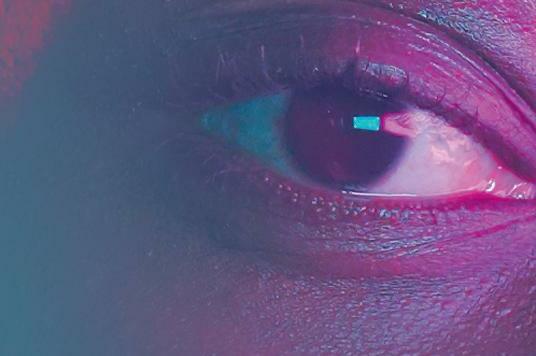








muscle.

events should be reported. Reporting forms and information can be found at: UK - http://yellowcard.mhra.gov.uk/ or search for MHRA Yellow Card in the Google
Play
2022
new ways ADLET0822UKf (QR: VID2LET0822UK) Date of preparation: August
Letybo® brings practitioners a new option to the current aesthetic market and provides aesthetic professionals and their patients with a notable efficacy and confirmed tolerability.
Apple App
94% response rate 4 weeks post injection 1,** Proven consistent effi cacy and tolerability with repeated injections for up to 12 months Scan for Reconstitution Instructions ® Response rate was defined as a ≥ 1-point reduction in FWS at maximum
Botulinum toxin units are not interchangeable
neuromuscular
effects
and injection
and also
Letybo 50 units powder for solution for injection; Abbreviated Prescribing Information: prescribing. Presentation: One vial contains 50 units botulinum toxin type A produced by Clostridium botulinum. After reconstitution each 0.1 mL of the solution contains 4 units. Indication: For the temporary improvement in the appearance of moderate to severe vertical lines between the eyebrows in adults <75 years old seen at maximum frown (glabellar lines), when the severity of the facial lines has an important psychological impact. Dosage and administration: Should only be administered by physicians with expertise in this treatment. recommended dose is a total of 20 units divided into five injections of 4 units (0.1 mL) each: 2 injections in each corrugator supercilii muscle and 1 injection in the from one product to another. Doses recommended are different from other botulinum toxin preparations. Treatment interval should not be more frequent than every three months. In the absence of any undesirable effects secondary to the previous treatment session, a further treatment session with at least a three-month interval between the treatment sessions is possible. The efficacy and safety of repeat injections beyond 12 months has not been evaluated. Special populations: No specific dose adjustment is required for use in the elderly older than 65 years of age. Letybo is contraindicated in patients 75 years or older. paediatric population. Method of administration: Intramuscular use. Care should be taken to ensure that Letybo is not injected into a blood vessel. excipients. Generalised disorders of muscle activity (e.g. myasthenia gravis, Lambert-Eaton syndrome, amyotrophic lateral sclerosis). Presence of acute infection or inflammation at the proposed injection sites. Patients with bleeding disorders. Warnings and Precautions: Injection into vulnerable anatomic structures must be avoided. Avoid use when the muscle shows excessive weakness or atrophy. Risk of eyelid ptosis following treatment. related events: Needle-related pain and/or anxiety have resulted in vasovagal responses, including transient symptomatic hypotension and syncope after treatment with other botulinum toxins. disorders: Patients with unrecognised neuromuscular disorders may be at increased risk of clinically significant systemic effects including severe dysphagia and respiratory compromise from typical doses of botulinum toxin type A. Hypersensitivity reactions: An anaphylactic reaction may occur after injection of botulinum toxin. Epinephrine (adrenaline) or any other anti-anaphylactic measures should therefore be available. of toxin effects: Adverse reactions possibly related to the spread of toxin distant from the site of administration have been reported. Patients may experience exaggerated muscle weakness. Swallowing and breathing difficulties are serious and can result in death. Use not recommended in patients with a history of dysphagia and aspiration. Patients should be advised to seek immediate medical care if swallowing, speech or respiratory disorders arise. Pregnancy & Lactation: Not recommended during pregnancy or lactation and in women of childbearing potential not using contraception. Undesirable effects: reaction. Very rarely aspirational pneumonia. For full list of side effects, consult SmPC. Legal Category: POM; Pack size: Packs containing 1 5ml vial. Multipack containing 2 (2 packs of 1) vials; 2x5ml: 120GBP; MA Number: PL 29863/0002; PA Number: PA0846/001/001; MA Holder: Croma-Pharma GmbH, Industriezeile 6, 2100 Leobendorf, Austria; Adverse
or
Store.
IE - HPRA Pharmacovigilance Website: www.hpra.ie. Adverse events should also be reported to Croma Pharma GmbH on 0118 206 6513
Pre-existing
Most common
are headache
site
Exploring the Evolution of Toxin
At that point, I was a GP with an interest in dermatology, and my dermatology patients were coming in asking about this new treatment they’d heard of that was sweeping the States. I treated one patient, who spoke to another patient, and within three months I had a regular flow of (mostly female) patients coming in to get their frown lines done – and I have to say, I was getting some very, very happy patients!”
Over the next 10 years, two more toxins were released onto the market: Azzalure (known as Dysport in other markets) and Bocouture (Xeomin). “These were the holy trinity of toxin for a very long time,” Dr Eccleston comments. However, now the UK aesthetics specialty is seeing more new toxins emerge including Letybo and Nuceiva, as well as Azzalure being relaunched in a different format called Alluzience – a ready-diluted toxin designed to make it easier for users. There are even more to come that are currently in their trial phase.
Botulinum toxin is the foundation of medical aesthetics, consistently proving to be the most popular treatment with an estimated three million procedures performed worldwide each year.1 For many years, there were only three products available in the UK market, until 2022 which saw the launch of three brand new toxins. As we head into 2023, we spoke to three aesthetic practitioners about what the future of toxin might hold, and what injectors should be considering when they look to use a new toxin.
A brief history of toxin
The first incident of the serious food-borne illness botulism was documented in the 18th century when the consumption of meat and blood sausages gave rise to many deaths throughout the kingdom of Württemberg in South Western Germany. The then-district medical officer Justinus Kerner published the first accurate and complete descriptions of the symptoms of food-borne botulism between 1817 and 1822, when he attributed the intoxication to a biological poison.2 Kerner also postulated that the toxin might be used for treatment purposes.2 Modern botulinum toxin treatment in medicine was pioneered by scientists Alan Scott and Edward Schantz in the early 1970s, when the type-A serotype was used to correct strabismus. It was later propelled into the cosmetic sphere when Dr Jean and Alastair Carruthers discovered the use of botulinum toxin for wrinkles while treating patients for blepharospasms, observing that many of their patients were also getting an improvement in their lateral canthal lines. Their research on this was published in 1992.2,3 Since then, botulinum toxin-A has developed in aesthetic medicine, with different formulations and uses of the product emerging. Botulinum toxin-B has been developed for use in muscle disorders in the US, but not yet for cosmetic use and isn’t approved in the UK.
Developments
The first licensed toxin in the UK was Botox in 2001, initially indicated to treat hyperhidrosis. In 2002 it was further approved for the treatment of glabellar lines.4 Aesthetic practitioner Dr David Eccleston notes that the introduction of Botox into his treatment offering completely transformed his practice. “I was probably one of the first doctors in the UK to start using Botox.

Dental surgeon Dr Souphi Samizadeh notes that this evolution isn’t singular to the UK, with a range of products available from the East and West that practitioners and patients can choose from. She notes, “Type-A toxin preparations have been developed and manufactured in the UK, Germany and China, whereas a therapeutic type-B toxin was prepared in the US. I like to say that Botox is like the grandfather, and the rest are its siblings or children. To date, toxin has been used globally to treat a wide variety of conditions associated with muscular hyperactivity, glandular hypersecretions and pain, as well as in aesthetics.”
Product selection
Having had experience with all six available toxins on the market in the UK, Dr Eccleston recently added Nuceiva to his treatment portfolio, which was launched at CCR 2022. “I have found that this product does not move through the tissues as much as any of the other toxins I have tried, so I know if I put it somewhere it will stay there,” he says. “This enables me to have the utmost precision when injecting, knowing it won’t affect any undesired muscles.” However, he notes that this may make it a more difficult toxin for beginners. “If the product does not go directly into the muscle it will stay in an undesirable location, so if you are a relatively unskilled injector you will need to up your game – I would say this toxin favours highly-skilled artistic injectors,” he adds.
Dr Eccleston states that although he is
Reproduced from Aesthetics | Volume 10/Issue 1 - December 2022 @aestheticsjournaluk Aesthetics @aestheticsgroup aestheticsjournal.com 29 Aesthetics | December 2022 @aestheticsjournaluk aestheticsjournal.com Special Feature Botulinum Toxin
Three practitioners discuss how botulinum toxin and its uses have developed over the last 20 years, and provide considerations for the future
Botox
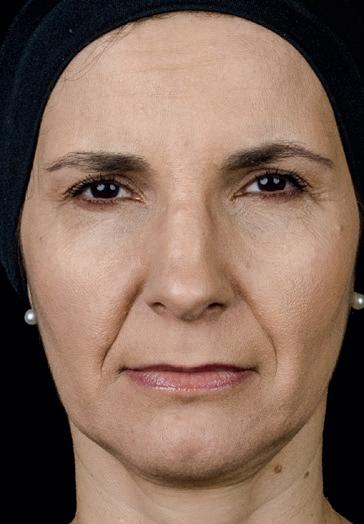
OnabotulinumtoxinA
2002
Glabellar lines, migraines
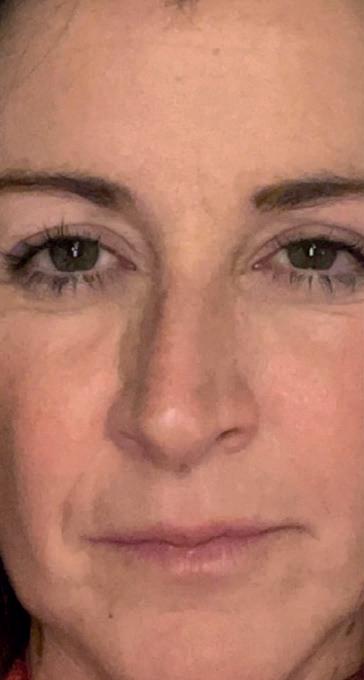
Azzalure AbobotuliumtoxinA 2009 Glabellar lines, lateral canthal lines
Bocouture
IncobotulinumtoxinA 2011 Glabellar lines, blepharospasm, cervical dystonia
OnabotulinumtoxinA, human albumin, sodium chloride 4 U/0.1ml Total: 20 U/0.5ml
AbobotuliumtoxinA, HAS, lactose 125U of powdered Azzalure reconstituted in 0.63 mL of 0.9% NaCl 50 U in 0.25 mL for GL, 60 U in 0.30 mL for LCL
IncobotulinumtoxinA, human albumin, sucrose 4 U/0.1ml Total: 20 U/0.5ml
Alluzience AbobotuliumtoxinA 2021 Glabellar lines AbobotuliumtoxinA, L-histidine, sucrose, polysorbate-80, sodium chloride, hydrochloric acid, sterile water
LetibotulinumtoxinA 2022 Glabellar lines
Letybo
Pre-diluted, no need for reconstitution 50 U in 0.25ml for GL
LetibotulinumtoxinA, human albumin, sodium chloride 4 U/0.1ml Total: 20 U/0.5ml
3-4 days 3-4 months
2-3 days 5 months
2-3 days 3 months
Within 24 hours 6 months
3 days 4 months
Nuceiva PrabotulinumtoxinA 2022 Glabellar lines PrabotulinimtoxinA, human albumin, sodium chloride 4 U/0.1ml Total: 20 U/0.5ml 2 days 5-6 months
Table 1: Differences between the types of toxin on the market5,6,7,8
enjoying using Nuceiva, he still offers other toxins in his practice. This is because some of his long-standing patients who have been having Botox for years want to continue with something familiar that has consistently given them good results. “This shows that introducing a new toxin does not necessarily take business away from the other toxins in your clinic. However, what it does do is create a new cohort of patients, because some of the younger generations have heard about new toxins when researching aesthetic treatments and are coming in and asking for the latest product,” he says. “Personally, I like having a variety of different toxins to offer as it gives me choice depending on what the patient’s wants and needs are.”
Similarly to Dr Eccleston, Dr Samizadeh likes to offer several brands of toxins in her practice. She explains, “I am happy using various brands and don’t necessarily have a preference, but what matters to me is that the ones I am investing in have a long safety and efficacy profile, as well as clinical studies to back this up. All toxins on the market differ through their manufacturing processes, formulations and assay methods-units of biological activity, so it’s important to remember they are not interchangeable.” As such, she notes that when choosing a brand, practitioners should get to know the individual product well, even if they have used another toxin before. “You should always research what the ingredients are, as well as how to correctly store and reconstitute the product. In addition, look at what the research says about volume, dosage, spread, migration and diffusion, what the onset of action and longevity is, as well as its potential interaction
Before
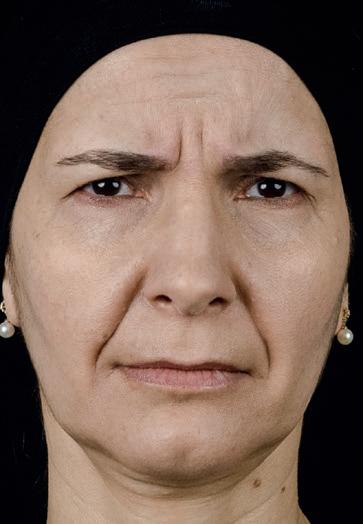
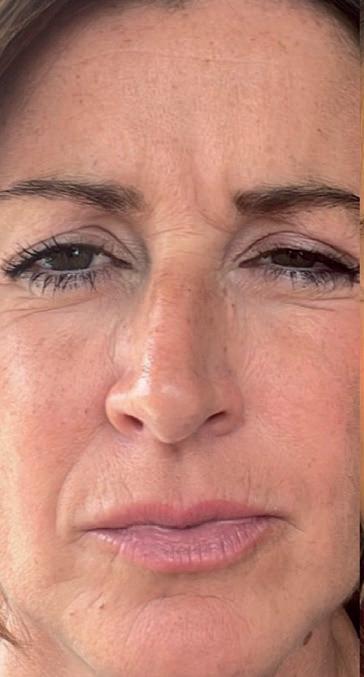
Figure 1: Patient before treatment and at 24 and 48 hours post-treatment using Nuceiva. Images courtesy of Dr Eccleston
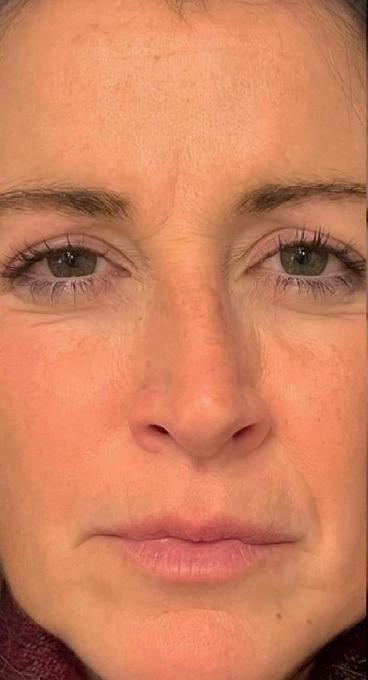
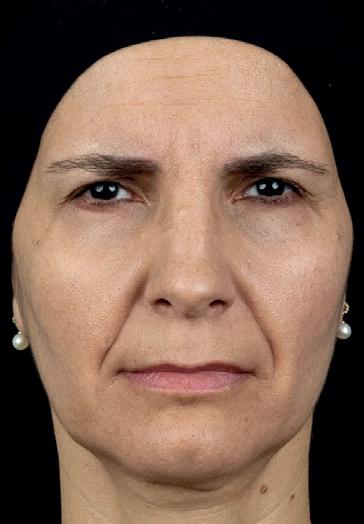
Figure 2: Patient before, one month and four months after treatment using Leytbo. Images courtesy of Professor Haq
with other medication,” she says. Professor Syed Haq notes that he determines what toxins to use by observing what gives his patients the best and most natural results. He does so by looking at the principles of proven and evidence-based safety, longevity, consistency and speed of onset. “I have had experience with all of the major toxins on the market, but personally, I like using Letybo, Botox and Alluzience as they’ve given my patients the most satisfaction,” he notes. “Letybo is the only toxin that has been trialed on patients up to 75 years of age, as well as on a large cohort of male patients, so it’s imperative to have this clinical data behind it when understanding its use and in particular the patient group one is treating.”
Toxin resistance
A complication that is often discussed though not often seen, in relation to botulinum toxin treatments, is toxin resistance. This is extremely rare when noting the impact when considering the cosmetic use of the neurotoxin. Professor Haq explains, “Usually, when we hear about cases of toxin resistance, it is from people who have used a botulinum toxin for medical reasons, and have had the injections at higher doses, often frequently and from a younger age (under 18) over a prolonged period of time. The summation of doses and amount of toxin delivered therefore eventually leads to an increased risk of developing antibodies to the toxin, where their immune system starts is triggered to produce antibodies against the light chain of botulinum toxin. It should be noted that antibodies can be produced against other elements also (non-neurotoxin associated proteins and excipients).” He adds that the studies that
Reproduced from Aesthetics | Volume 10/Issue 1 - December 2022 @aestheticsjournaluk Aesthetics @aestheticsgroup aestheticsjournal.com 30 Aesthetics | December 2022 Special Feature Botulinum Toxin
Brand name Trade name Year of approval Approved indications Components in vial
Dilutions and recommended dose Time of onset Length of results
After 1 month After 4 months After 24 hours After 48 hours Before
have been conducted to determine neutralising antibody production have often used the in vivo assessment based on antibody titres derived using an enzyme-linked immunosorbent assay kit. “This can often be somewhat inaccurate with high variability amongst suppliers,” he says, noting, “The temperature of the assay on the day, the standard curve, sample storage and ELSIA kit insensitivity can all have an impact. The use of plasmon surface resonance and looking at antibody protein interactions at the correct pH would be the gold standard method of determining the presence and later the level of neutralising antibodies in a given patient’s sera.” Botulinum toxin type-B can be used as an alternative for those who have seemingly developed resistance to all type-A botulinum toxin brands, however, these patients tend to develop resistance to type-B soon after for reasons that have not yet been fully identified.7
Considerations for toxin in your business
Professor Haq notes that after safety profile and efficacy, pricing is one of the main factors practitioners and clinics will need to consider in the next year or so, particularly as a result of the current economic crisis (find out more about how to cope during the recession on p.65). He notes, “If newer toxins getting market authorisation do end up lasting for more than six months (which the ones currently being trialled are suggested to do), the practitioner is going to have to look at alternative ways to attract the patient to the clinic at the frequency which they are used to. Whereas before, they might have visited three or four times a year, it will become no more than two if wanting a neurotoxin aesthetic treatment. So, from a business perspective, you’re going to have to strategise and work out whether using this longer-lasting toxin might be worse for your business in the long run.” He notes that there may also be a dilemma as to whether treatment prices should be raised, and whether patients will be able to afford to come to clinic if this is the case.
Professor Haq adds that the longer-lasting toxins may be a big draw for male patients and those who workout consistently, however, noting, “Stereotypically, men are a more active group, and their facial muscle bulk and intrinsic metabolic rate causes them to come and complain that the toxin treatment isn’t lasting long enough. In addition, male patients don’t tend to want to visit an aesthetic clinic as often as women do, so it may be more enticing that they only have to visit once or twice throughout the year.” Professor Haq notes that using longer acting toxins have many positive reasons to be adopted but practitioners should be cautious particularly when considering the dreaded treatment emergent adverse events; in particular lid or brow ptosis. If a toxin lasts much longer than those being currently used, then resolving complications would invariably take longer and that could be a significant problem in the future for the practice and the practitioner.
In terms of readily diluted toxins, Dr Eccleston notes that although many find it to be easier and quicker, it means you are unable to tailor the dilution for the individual patient, so this is something you should weigh up before purchasing. He explains, “I will dilute my preferred toxin at a different dilution depending on the preferred result and the area of the face that I am treating, so a pre-diluted toxin wouldn’t work for me personally.”
However, Professor Haq notes that it can be beneficial for many as it takes the guess work out of formulating the toxin and therefore may minimise practitioner error. He also advises that practitioners should choose their instrument carefully, noting that he personally prefers to use a 4mm 30 gauge needle. “This provides me with the
consistency of depth, and it’s pretty painless. If you start to go for narrow gauge needles, you have to be very careful because the extrusion forces will change and that can lead to complications,” he notes.
Dr Samizadeh notes that it is important for practitioners to be aware of some ethical considerations surrounding a product choice. She says, “For example, some products, including many skincare brands in the market, use animal testing and some botulinum toxin formulations include human serum albumin. For many patients, including vegans and those passionate about animal rights, this information would matter. Practitioners should put product ingredients on consent forms so that the patients can make an informed decision that would resonate with them, and the practitioner can offer an alternative.”
The future of toxin
Dr Samizadeh believes that, as with any aesthetic procedure, understanding your patient is crucial to conducting a successful treatment. “Their medical and cosmetic history are both important, as well as examining them both statically and dynamically. This way you can ensure you are tailoring your treatment specifically for them and getting the result they desire,” she says.
Professor Haq agrees that one should assess the patient properly in a relaxed and fully animated state, taking pictures for medical records at each juncture. He says, “Following assessment, one can treat the patient in a patient-specific manner and not just using a standard injection pattern alone. Look, feel and identify the areas you’re going to inject. Also, ask the patient what their expectations are – what is it that they’re looking for and have they previously had any issues with toxin?” He recommends that if they are a new toxin user, you should review the patient within a number of weeks following treatment and check what their pattern of change was, so that in the future you can potentially manage the patient better. He continues, “You should do the same thing if you have a long-standing toxin user but decide to change the product you’re injecting to a different one on the market. Is it comparable to the results achieved before with a previously used toxin? If not, why might this be? Try and identify its pattern of action and more”.
Dr Eccleston stresses the importance of going to training and continually updating your knowledge base and technique. He says, “I am still improving, even though I’ve been working with toxin for decades – my skill level now is more than it was a year ago and way more than it was five years ago. Do not go on a one-day course and think you are an expert. Getting good results requires experience and practice. I think everyone has been so obsessed with fillers for the last 10 years that the skillset when using fillers is far more advanced than it is with toxin, but this is changing now. There is definitely a lot more that is going to evolve regarding toxin in the next few years, and I can’t wait to be a part of it!”
Reproduced from Aesthetics | Volume 10/Issue 1 - December 2022
Aesthetics @aestheticsgroup aestheticsjournal.com 31 Aesthetics | December 2022 @aestheticsjournaluk Aesthetics @aestheticsgroup aestheticsjournal.com Special Feature
@aestheticsjournaluk
Botulinum Toxin
VIEW THE REFERENCES ONLINE! AESTHETICSJOURNAL.COM

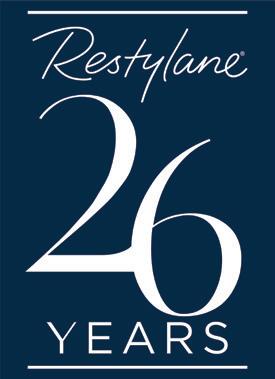
WE PROVIDE THE COLLECTION YOU PROVIDE THE LOOK UKI-RES-2200306 DOP October 2022 5 5






References: 1. Restylane KYSSE EU IFU; 2. Restylane DEFYNE EU IFU; 3. Restylane VOLYME EU IFU; 4. Restylane LYFT EU IFU; 5. Data on file (MA-39680). Adverse events should be reported. For the UK. Reporting forms and information can be found at www.mhra.gov.uk/yellowcard or search for Yellow Card in the Google Play or Apple App Store. For Ireland. Suspected adverse events can be reported via HPRA Pharmacovigilance, Website: www.hpra.ie; Adverse events should also be reported to Galderma (UK) Ltd, Email: medinfo.uk@galderma.com Tel: +44 (0) 300 3035674 For exclusive offers on the full Restylane range, visit Medfx.co.uk today Restylane® KYSSE™ Adds volume, enhancing the shape of the lip to give a natural and balanced look.1 Restylane® VOLYME™ Creates natural volume and shape in the face. For the correction of facial volume in areas such as the cheeks.3 Restylane® DEFYNE™ Shapes facial contours where definition and flexibility is required, such as augmenting the chin.2 Restylane® LYFT™ Provides lift and structure for a pronounced effect. Recommended for areas of contour and structure where precision is required.4 1 3
Understanding the Anatomy of the Muscles of Mastication
Dr Rehanna Beckhurst describes the anatomy of the muscles of mastication, as well as important considerations when administering botulinum toxin injections
With society’s levels of stress and anxiety increasing, the number of stress-related teeth clenching and grinding cases are on the rise.1 However, these symptoms are just clinical manifestations of a more complex problem called temporomandibular disorders (TMDs).2 They are often accompanied by enlargement or hypertrophy of the masseter muscle, giving the lower third of the face a squared appearance. This is an unwanted aesthetic appearance for many female patients, leading to an increased demand for an aesthetic treatment which can aid facial slimming.3 When administering botulinum toxin for facial slimming or treating temporomandibular disorders, knowledge of anatomy and topographic anatomy of the area is paramount. This article will describe the anatomy and function of the muscles of mastication, as well as the anatomical relations of them.
Temporomandibular disorders
Aesthetically undesired hypertrophy of the masseter muscle is often caused by temporomandibular disorders which are one of the leading causes of orofacial pain.1 They involve dysfunction of the temporomandibular joint and masticatory muscles, limitations of jaw movement and pain. TMDs are divided into muscle origin and joint origin. Symptoms include muscle and jaw pain, pain when chewing, referred headache, earache and neck pain.4 The aetiology of TMDs is multifactorial and triggers could be of a biologic, environmental, social, emotional and cognitive nature, such as: malocclusion or intra-articular abnormalities, anxiety, stress, diet or parafunctional habits.5
Treatment for TMDs includes conservative treatment, subdivided into pharmacological (anti-inflammatory drugs, muscle relaxants, anxiolytics, and antidepressants in severe cases), non-pharmacological (explanation, self-management, exercise, hot and cold compresses, splint therapy) and surgical. The first report on using botulinum neurotoxin type A (BoNT-A) for masseter hypertrophy was published in 1994, as an alternative treatment option for TMD, which lies on the borderline between conservative and surgical treatments.5,7 BoNT-A is a purified exotoxin of clostridium botulinum and is a neuromodulator, which affects neuromuscular junction by inhibiting production of acetylcholine, disabling muscle contraction. It has been used to treat various neuromuscular disorders since 1980.8 There is a need for more consensus in robust injection protocols and clinical studies to assess the efficacy of this treatment. Knowledge of the anatomy is paramount when injecting this area with multiple advanced physiological functions.
Muscles of mastication
The complexity of anatomical structures around the jaw and mouth is called the stomatognathic system, and its functions include mastication, deglutition and speech.9 Mastication is the most ancestral function with a higher specialisation.9 Mastication has been defined as a rhythmic, highly coordinated neuromuscular function that involves, in each of its acts, all components of the stomatognathic system, mainly executed by the masticatory muscles.10 This mechanism is achieved by perfect coordination of the masticatory muscles and by nervous control which allows for this exertion of precise and strong occlusal forces.9 Therefore, it is extremely important to understand the anatomy and the relations between the anatomical structures when injecting this area. Also, anatomical variations should be considered, therefore thorough clinical and functional patient assessment is paramount. The primary muscles of mastication are the temporalis, masseter, medial pterygoid and lateral pterygoid muscles.11 The temporalis muscle is located in the temporal fossa, the masseter muscle found in the cheek area, and medial and lateral pterygoid muscles situated in the infratemporal fossa.12 All muscles attach to the mandible and produce movements of it at the temporomandibular joint. Such movements are:13
• Protrusion/protraction (forward movement of the mandible) –mainly lateral pterygoid, with the help of the medial pterygoid
• Retraction (backward movement of the mandible) – posterior fibres of temporalis muscle
• Elevation or adduction (closing the mouth) – temporalis, masseter and medial pterygoid
• Depressions (opening the mouth) – lateral pterygoid and accessory muscles, gravity
• Rotation (side-to-side movements of the mandible) – lateral and medial pterygoids
The accessory muscles to aid masticatory function are the buccinator (helps to press cheeks against posterior teeth to keep food within the oral cavity) and strap muscles, which can be subdivided into suprahyoid muscles (digastric muscle, mylohyoid muscle and geniohyoid muscle) and infrahyoid muscles (the sternohyoid, sternothyroid, thyrohyoid and omohyoid muscles).14,15
Their primary function is to raise and depress the hyoid bone and larynx, and also assist in the depression of the mandible against the opposing force.11 Platysma also assists the depression of the mandible against resistance.14 The four main muscles of mastication are supplied by the motor fibres of the mandibular nerve deriving
Reproduced from Aesthetics | Volume 10/Issue 1 - December 2022 @aestheticsjournaluk Aesthetics @aestheticsgroup aestheticsjournal.com Aesthetics | December 2022 34 CPD Mastication Muscles
from the trigeminal nerve (CN V), and the arterial supply derives from the branches of the maxillary artery, a branch of the external carotid artery.11
Temporalis muscle
The temporalis muscle is a large flat fan-shaped muscle, originating from the temporal fossa. It is divided into two parts: the anterior fibres run almost vertically, while the posterior fibres run almost horizontally. Both parts then connect closer to form a large tendon as they run down medially from the zygomatic arch to the ascending ramus of the mandible, inserting in its anterior and lateral surfaces, while some fibres may continue into the masseter muscle. It is innervated by the deep temporal branches of the mandibular nerve (CN V3), while blood supply comes from the deep temporal branches of the maxillary artery and middle temporal branches of the superficial temporal artery.12 The main role of the temporalis muscle is the adduction (elevation) of the mandible, but because of radial orientation of its fibres, it contributes to protrusion and even retraction and takes part in the grinding action by moving the mandible from side to side.15
Medial pterygoid muscle
The medial pterygoid muscle (also called the internal pterygoid muscle) originates from the pterygoid fossa and from the lateral lamina of the sphenoid process of the sphenoid bone. It runs medially down the ramus of the mandible and inserts into the pterygoid tuberosity on the medial side of the mandibular angle. It has two parts: deep and superficial.15 Together with the masseter muscle on the outside and the medial pterygoid on the inside of the ramus, they form a sling to elevate (adduct) the mandible. The medial pterygoid is also involved in side-to-side movement during chewing and grinding, as well as protrusion of the mandible. It can be palpated medially from the ramus of the mandible both intra and extra orally.15
Buccal a. and n. (CN V3)
The innervation of the medial pterygoid muscle is supplied by the medial pterygoid branch of the mandibular nerve (CN V3). Its blood supply stems from the pterygoid branches of the maxillary artery, as well as the buccal and facial arteries.12
Lateral pterygoid muscle
Superficial temporal a.
Middle meningeal a.
Maxillary a.
Masseteric a.
Medial pterygoid n. (CN V3)
Deep temoral aa.
Zygomaticofacial n. (CN V2)
Infraorbital n. (CN V2)
Infraorbital a.
Mandibular n. (CN V3)
Mental a.
Mental n. (CN V3)
Digastric posterior belly
Inferior alveolar n. (CN V3)
Digastric anterior belly
Figure 1: Innervation, blood supply and accessory muscles of mastication20
The lateral pterygoid muscle (also called the external pterygoid muscle) is located deep from the temporalis and masseter muscles, between the sphenoid bone and temporomandibular joint. This fan-shaped muscle has two heads: the superior, smaller head originates from the greater wing of the sphenoid bone and most of it inserts into the articular disc, with additional insertions often found on the condylar process. The inferior, larger head originates from the external surface of the lateral lamina of the pterygoid process of the sphenoid bone and inserts into the condylar process of the mandible. The muscle lays almost horizontally.15 The lateral pterygoid muscle is the only muscle in the mastication group that opens the mouth; without it, the jaw opening would rely mainly on gravitational forces.16 Due to different innervation between the heads, both parts of the muscle can move independently and perform different functions at the same time. The innervation is supplied by the branches of the mandibular nerve (CN V3). The superior head and lateral fibres of the inferior head are supplied by the buccal nerve, a branch of the mandibular nerve (CN V3), while the medial part of the inferior belly is supplied directly by the mandibular nerve (CN V3).12 Vascularisation is supplied by the pterygoid branches of the maxillary artery and the ascending palatine branch of the facial artery.12 When contracting bilaterally, the lateral pterygoid muscle causes translation and rotation in both temporomandibular joints.17 The inferior head pulls the condyle of the mandible forward, resulting in rotation of the condyle against the inferior surface of the articular disc. Simultaneously, the superior head pulls the articular capsule and disc in the same direction to cushion the movement of the condylar head. The result of these simultaneous movements is an anterior translation of the disc and the condyle, with simultaneous rotation of the condyle, which is clinically seen as protrusion and depression of the mandible.12 The movement of opening the jaw is then completed by alternate contraction of the digastric and the geniohyoid muscles. This movement is limited by the retro-discal fat pad within the temporomandibular joint, to limit protrusion and depression. During the jaw closing, the same translation and rotation occurs within the temporomandibular joint, but only in the opposite direction. The inferior head of the muscle contracts to smoothen the posterior translation of the articular disc and condylar head, counteracting the net pull of the masseter and temporalis muscles which draw the mandible posteriorly when closing the mouth.12 When the inferior head contracts unilaterally, the mandibular condyle rotates anteromedially, moving the jaw side-to-side. This action occurs in synergy with contraction of the medial pterygoid muscle on the same side, and is clinically seen as swinging the jaw to the opposite side when chewing/grinding on one side of the mouth.12 Although palpating the lateral pterygoid muscle is a standard diagnostic procedure for diagnosing TMD, some studies suggest that this muscle is not palpable intraorally or extraorally and should not be performed as it is the medial pterygoid muscle which is palpable instead.12

Reproduced from Aesthetics | Volume 10/Issue 1 - December 2022 @aestheticsjournaluk Aesthetics @aestheticsgroup aestheticsjournal.com Aesthetics | December 2022 35 @aestheticsjournaluk CPD Mastication Muscles
Relations and anatomical structures
The lateral pterygoid muscle makes up the medial wall of the infratemporal fossa and is contained within the masticator space, bounded by the deep cervical fascia, which splits into the superficial and deep parts at the level of the mandibular ramus. These two parts of the cervical fascia cover the masseter muscle and the deep part of the medial pterygoid muscle.16
@aestheticsjournaluk Aesthetics @aestheticsgroup aestheticsjournal.com
@aestheticsjournaluk Aesthetics @aestheticsgroup aestheticsjournal.com
The masticator space also contains the tendon of the temporalis muscle, masseter and medial pterygoid, and the pterygoid venous plexus. Within this space, the lateral pterygoid lies deep to the superficial part of the medial pterygoid and the temporalis tendon, but it lies superficial in relation to the deep part of the medial pterygoid, sphenomandibular ligament, middle meningeal artery and mandibular nerve (CN V3).16
Temporal and masseteric branches of the mandibular nerve (CN V3) cross the upper border of the muscle, and the lingual and inferior alveolar nerve cross the lower border. The split between the superior and inferior heads of the lateral pterygoid muscle is where the maxillary artery and buccal nerve (branch of the mandibular nerve CN V3) pass through.15
Masseter muscle
The masseter muscle is a strong bulky muscle composed of two layers: the superficial, large layer originates from the maxillary process of the zygomatic bone and the anterior two-thirds of the zygomatic arch, running down to insert into the masseteric tuberosity on the lateral wall of the angle and the lower part of the ascending ramus of the mandible.12 Its deep part originates from the medial surface and inferior border of the zygomatic arch, then runs vertically down and inserts into the upper part of the ascending ramus and coronoid process of the mandible. A study by Lee et al in 2017 discovered a deep inferior tendon located in the deep superficial part of the masseter muscle in all 44 cadaver specimens examined.11 This tendon may block toxin diffusion from the deep part to the superficial part, therefore, it may stay unaffected and overcompensate for the affected deep part post-toxin injections.17 The masseter muscle is innervated by the masseteric nerve from the mandibular nerve (CN V3), and vascularisation is derived from the masseteric artery, a branch of the maxillary artery.12 The main function of the masseter muscle is the elevation of the mandible when closing the mouth, with a very small contribution to the protrusion function.16 Parafunctional activity of the masseter muscle
often leads to its hypertrophy, however, other factors such as parotid gland disease, dental problems, compensatory-occlusal hypertrophy, masseter tumours and neoplasms must be ruled out. With suspected parafunction accompanying hypertrophy, the patient should be referred to a dentist for occlusion analysis and splint therapy as the first choice of treatment.18

Figure 2: Masseter muscle20

Reproduced from Aesthetics | Volume 10/Issue 1 - December 2022
Aesthetics | December 2022 36
CPD Mastication Muscles
Figure 3: Anatomical relations of the masseter muscle20
Although current literature suggests the safety and efficacy of masseter treatment with toxins, there is a lack of treatment protocols and guides for safe injections
Galea aponeurotica Occipitofrontalis frontal belly Procerus Orbicularis oculi Levator labii superioris alaeque nasi muscle Nasalis Levator labii superioris Orbicularis oris Zygomaticus major and minor Depressor labii inferioris Risorius Mentalis Masseter Muscle Platysma Depressor anguli oris Superior auricularis Temporalis Anterior auricularis Occipitofrontalis occipital belly Posterior auricularis
Buccinator
Relations and anatomical structures
Masseteric fascia covers the entire superficial aspect of the masseter muscle. This fascia is thin, but very strong. Anterolaterally, below the zygomatic bone, the duct of the parotid gland crosses over the muscle. The superficial part of the parotid gland itself is also located superficially to the masseter, laying posteriorly to the muscle, but covering almost the entire posterior part of it.6 Along with the parotid gland, a few more structures can be found over the lateral side of the muscle:22
• Terminal branches of the facial nerve
• Facial vein
• Facial artery
• Risorius muscle
• Zygomaticus major muscle
The inner surface of the masseter muscle is almost completely covered by the mandibular ramus, and they form a space called submasseteric space, part of the facial space. This space is where a submasseteric abscess would form, and it is important to differentiate and diagnose any odontogenetic infections.15
Deep posterior to the inner part of the masseter muscle, the temporal muscle is found. Both muscles partially cross over. Anterior to the muscle, the buccinator muscle is located. The risorius muscle is also located anteriorly, laying superficially over the buccinator, and both muscles insert into the modiolus. These are two important muscles to consider when injecting the masseter muscle.15
The above-mentioned duct of the parotid gland penetrates the fibres of the buccinator muscle to find its way to the inside of the oral cavity and finally open onto the inner side of the cheek.20
Treating with botulinum toxin
According to numerous studies, masseter injections with toxin are relatively safe and have a high efficacy profile, however, there are complications associated with these injections.2,7,21-25 It is important to note that only injection site-related complications are listed here to demonstrate the importance of anatomical knowledge.
• Loss of full smile/asymmetric smile can happen due to unilateral toxin diffusion and relaxation of the risorius and zygomatic major muscles. Injecting too anterior, too high and superficially should be avoided.7 Sunken lateral cheeks (infra-zygomatic hollows) due to toxin affecting the upper parts of the masseter and administering the excess dose, leading to its atrophy. Injecting too high should be avoided7
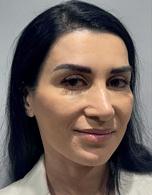
• Difficulty in opening the mouth due to toxin diffusion into lateral pterygoid muscle. In this case, injecting too high should also be avoided19
• Xerostomia – toxin affecting the parotid gland when injected too posterior10
• Neuropraxia – mandibular nerve damage when injected too inferior. In some anatomical variations, the mandibular nerve may lay too superior on the mandibular margin10
• Paradoxical bulging due to excessive compensation of the superficial layer of the masseter muscle. As described above, the deep inferior tendon may prevent toxin diffusion into the superficial part of the masseter and lead to its overcompensation and bulging. Injecting both deep and superficial parts will help to prevent this complication18
Based on anatomical considerations, for safe performance of injections into the masseter when treating hypertrophy for facial
slimming, the injector should stay 1cm from all borders. The following guide may be useful:19
• Superior: Ear lobe to cheilion
• Inferior: 1cm above the inferior margin of the mandible
• Posterior: 1cm from tragus
• Anterior: 1cm behind the anterior border of the masseter muscle; this can be felt by asking the patient to clench and palpating the border7
Know your anatomy
When treating muscle hypertrophy, if temporomandibular disorder is suspected, a referral to a dental professional should be made for thorough diagnosis and splint therapy, as a first choice of treatment. Although current literature suggests the safety and efficacy of masseter treatment with toxins, there is a lack of treatment protocols and guides for safe injections. Knowledge of anatomy and its variations is paramount when administering any aesthetic treatment.
Dr Rehanna Beckhurst is a cosmetic dental surgeon with a special interest in aesthetic medicine. Dr Beckhurst has been in aesthetics for more than 10 years. She holds a Level 7 qualification and a postgraduate certificate in Aesthetic Non-Surgical Interventions through City of London Dental School. She is a co-owner of ifab clinic in Barnstaple.
Qual: MBA, PgDip, CoLDS, ANSI
Test your knowledge!
Complete the multiple-choice questions and go online to receive your CPD certificate!
Questions Answers
1. The masseter is the strongest muscle of mastication. What are the other three main muscles?
a. Temporalis, lateral and medial pterygoids b. Temporalis, buccinator and medial pterygoid c. Medial and lateral pterygoid and platysma d. Temporalis, buccinator and platysma
2. What are the three muscles that elevate the mandible (close the mouth)? a. Temporalis, masseter and lateral pterygoid b. Temporalis, masseter and medial pterygoid c. Masseter, medial and lateral pterygoid d. Platysma, masseter and temporalis
3. What is the main muscle that depresses the mandible (opens the mouth)?
4. Which artery supplies the arterial blood to the muscles of mastication?
5. Asymmetric smile is one potential complication after injecting the masseter muscle with botulinum toxin type-A. What causes it?
a. Lateral pterygoid muscle b. Platysma c. Masseter d. Medial pterygoid
a. Superficial temporal artery b. Facial artery c. Zygomaticofacial artery d. Maxillary artery
a. Insufficient dose b. Toxin diffusion into risorius and zygomatic major muscle c. Dose too high
d. Toxin diffusion into buccinator muscle
Answers: A,B,A,D,B
VIEW THE REFERENCES ONLINE! AESTHETICSJOURNAL.COM
Reproduced from Aesthetics | Volume 10/Issue 1 - December 2022 @aestheticsjournaluk Aesthetics @aestheticsgroup aestheticsjournal.com Aesthetics | December 2022 37 @aestheticsjournaluk Aesthetics @aestheticsgroup aestheticsjournal.com CPD Mastication Muscles
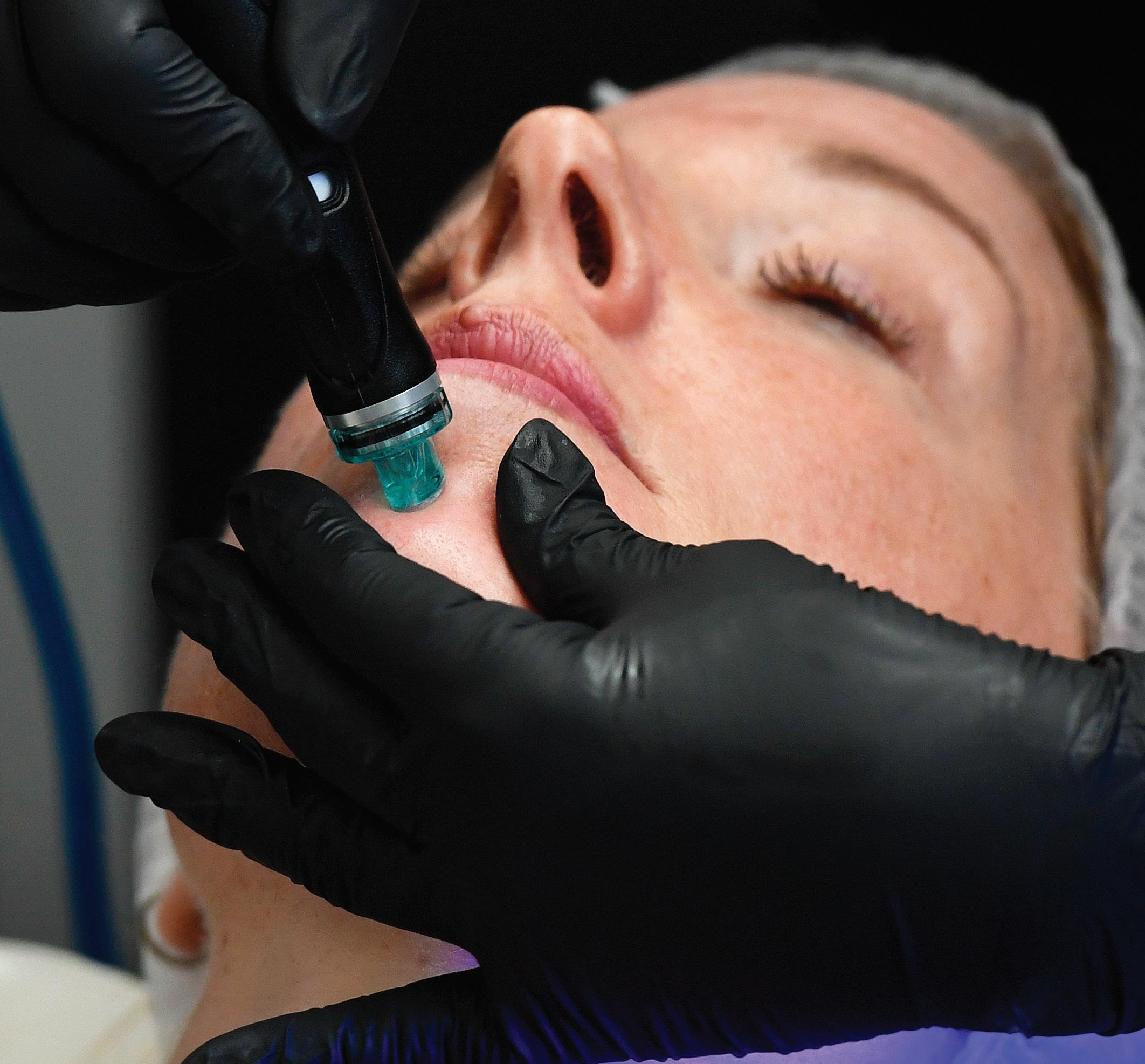
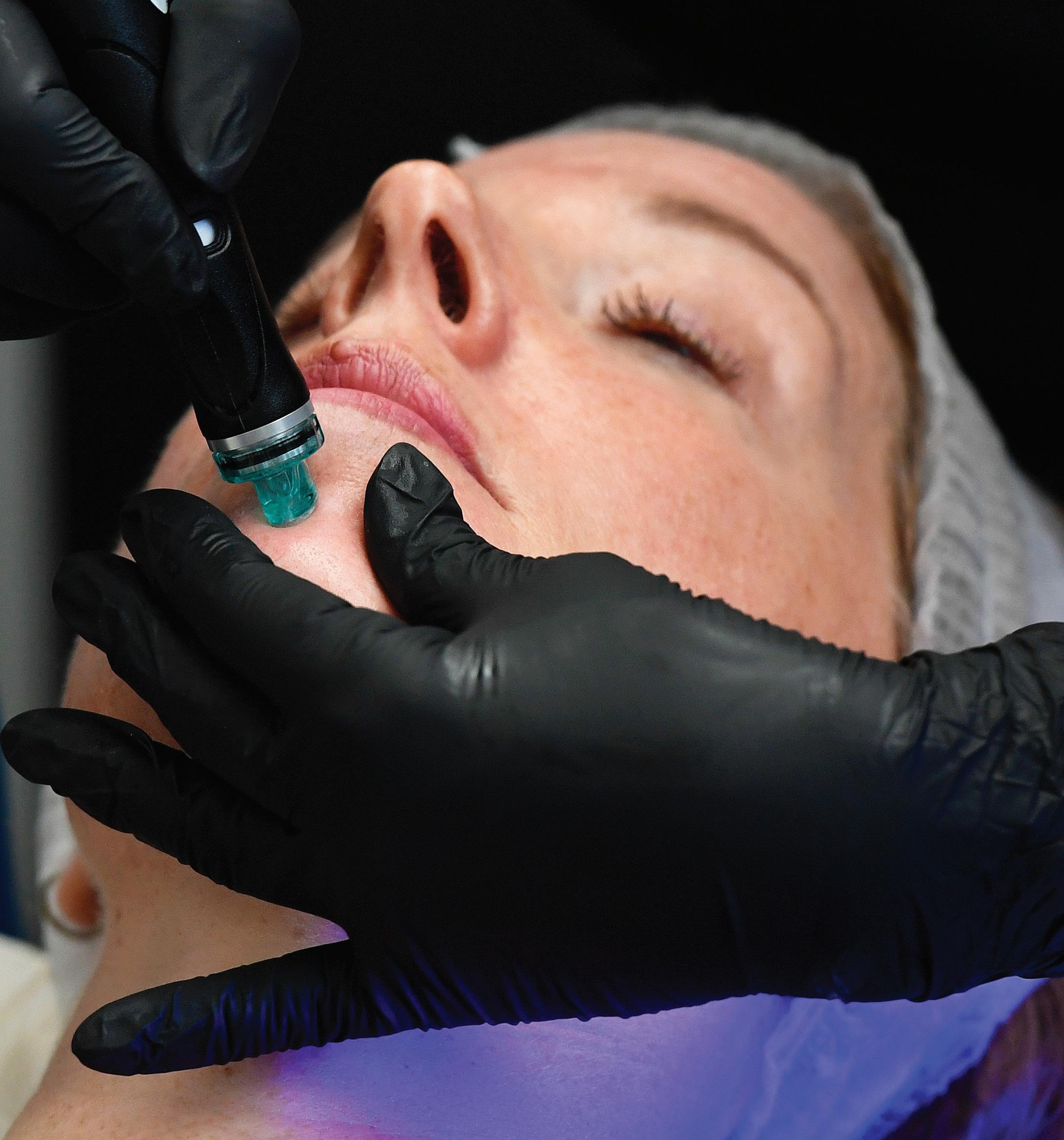
Headline Sponsor Register FREE for ACE 2023, the must-attend event for every medical aesthetic practitioner aestheticsconference.com Co-located with AWARDS 11 March, Grosvenor House, London
AWARDS 11 March, Grosvenor House, London


2,300+ colleagues 80+ leading brands 16 CPD points for your appraisal “Well organised event with a good variety of exhibitors and sessions. I will definitely be coming back next year! I give the show a 10/10” ACE visitor 2022 (Facial Aesthetics Doctor) 5 CPD Accredited Conferences
Main Auditorium Innovation Stage Symposiums Masterclasses In Practice Theatre Details of the complete conference agenda for ACE, including clinical session details from aesthetic leaders Teoxane, HA-Derma, Galderma, Prollenium and Croma will be revealed soon. @aestheticsjournaluk @aesthetics @aestheticsgroup SCAN TO REGISTER NOW
Teoxane
If you or your patients aren’t supplementing with NAD+ you need to take a look at the reasons why.

It is found that our NAD levels start depleting rapidly in our 20’s with as much as a 50% decrease before we reach 30.
WHAT IS NAD+? NAD + (Nicotinamide adenine dinucleotide) is a coenzyme found in all cells. It is an electron carrier used to temporarily store energy during cellular respiration.
WHY DO WE NEED NAD+? Without NAD+, your body wouldn’t be able to transfer the energy from the foods you eat to vital cell functions, especially in the brain.
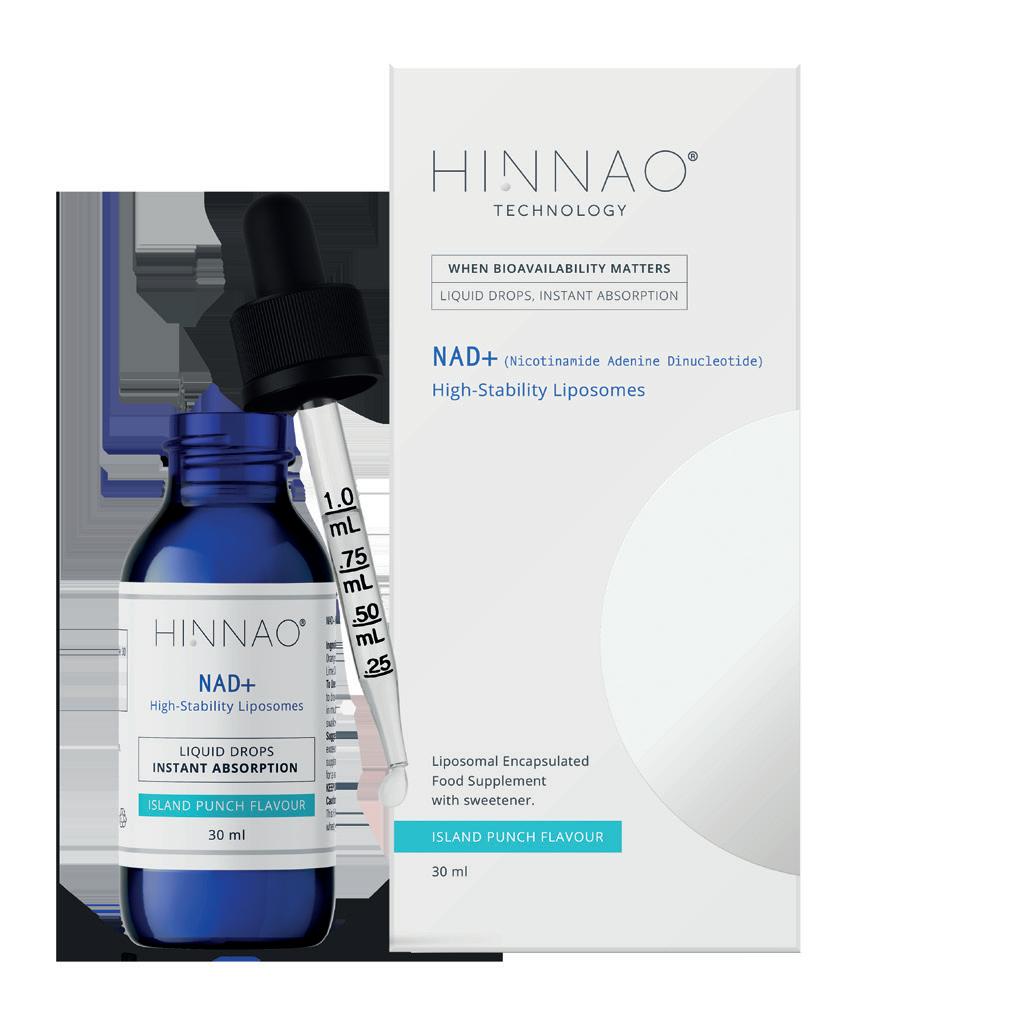
Importance of NAD+ Replacement Therapy HINNAO ® TECHNOLOGY NAD+ LIFE LONG TREATMENT, DAILY REPLACEMENT THERAPY STABLE NAD+ 3RD-PARTY TESTED BIOAVAILABILITY THE POWER OF IV THERAPY WITHOUT THE MEDICAL PROCEDURE Scan the QR code for 20% OFF introductory offer. Contact us for professional advanced NAD+ training. Lead Clinical Trainer HINNAO TRAINING WITH SUNIL KOCHHAR hinnao.com 0203 835 5855 info@hinnao.com Age NAD CD38/NADase Mitochondrial Function Activity / Levels
The
Treating the Inner Thighs with EMSCULPT NEO
One of the most stubborn areas to treat on the female body is, without any doubt, the inner thighs. Nevertheless, Dr Diane Duncan, globally recognised plastic and reconstructive surgeon, has published an MRI study on synchronised high-intensity focused electromagnetic field (HIFEM) and radiofrequency (RF) in the Journal of Clinical and Aesthetic Dermatology which reveals some amazing results achieved with the use of EMSCULPT NEO treatments.1
Dr Duncan presents these impressive results after four synchronised HIFEM and RF treatments on inner thighs: significant fat reduction (-27.4%) and muscle mass increase (+23.2%) at three months post-treatment.1
Demand for brilliant results
Modern-day beauty standards and aesthetic aspirations have propelled interest in new and safer techniques for non-invasive body contouring. As the public’s demand for greater efficacy and safety has grown steadily over the past decades, so too has the search for and development of new measures for fat reduction. The main fat reduction devices approved for use in aesthetic medicine employ cryolipolysis, high-intensity focused
ultrasound (HIFU), lasers, RF or HIFEM.2-6

Simultaneous application of HIFEM and synchronised RF might be one possibility to treat both fat and muscles in the same session. HIFEM generates an electromagnetic field that activates neuromuscular tissue through induced electric current, leading to supramaximal
muscle contractions and creating a significant energy demand that forces muscles to utilise the stored energy in adipocytes in the form of free fatty acids. Consequently, under the extreme muscle load, the size number of adipocytes are reduced.4
Dr Duncan’s research not only confirms the efficacy and safety of simultaneous application of HIFEM and synchronised RF for non-invasive fat reduction and muscle enhancement in the inner thigh, but also highlights a significantly high level of patient satisfaction (94%) with this combination.1 Results imply that the application of HIFEM and synchronised RF is more effective than using these energies alone.
Analysis of magnetic resonance images and thigh circumference showed that therapy combining HIFEM and RF is highly effective for subcutaneous fat reduction and increased muscle thickness in inner thighs.

EMSCULPT in the clinic
When launched in 2018, the EMSCULPT therapy was the world’s first and only treatment to use HIFEM technology to build muscle and sculpt the body in a 30-minute session. EMSCULPT NEO, launched in 2020, expanded upon its predecessor’s capabilities by simultaneously delivering heat and magnetic energy. The result provides more fat reduction and more muscle growth than any single gold standard product. Clinical studies have shown that, on average, patients experience a 30% fat reduction and a 25% increase in muscle in the treated area.*
REFERENCES
1. Duncan D. ‘Safety and Efficacy of Simultaneous Application of High-intensity Focused Electromagnetic Field and Synchronized Radiofrequency for Non-invasive Fat Reduction and Muscle Toning in Inner Thighs: Magnetic Resonance Imaging Evaluation’ The Journal of Clinical and Aesthetic Dermatology (2022).
2. Farberg A S et al. ‘Update on non-invasive body contouring techniques’ Cutaneous Medicine for the Practitioner,101:4 (2018), pp. 285-288.
3. Mordon S, Plot E. ‘Laser lipolysis versus traditional liposuction for fat removal’ Expert Review of Medical Devices, 6:6 (2009), pp. 677-688.
4. Griffith R, et al. ‘Non-invasive subcutaneous fat reduction: a review’ Journal of the European Academy of Dermatology and Venereology, 29:9 (2015), pp. 1679-1688.
5. Geronemus R G, Kim K H, ‘Laser lipolysis using a novel 1,064 nm Nd:YAG Laser’ Dermatologic Surgery, 32:2 (2006), pp. 241-248; discussion 247.

6. Abrou A E, et al. ‘Laser-assisted lipolysis: a review’ Dermatologic Surgery, 38:2 (2012), pp. 155-169.
*Data on file
Reproduced from Aesthetics | Volume 10/Issue 1 - December 2022 @aestheticsjournaluk Aesthetics @aestheticsgroup aestheticsjournal.com Aesthetics | December 2022 41
Advertorial BTL Aesthetics
A study has claimed 94% patient satisfaction with EMSCULPT NEO treatment to the inner thighs
This article was
by BTL
Read the full publication via the QR code below Figure 1: Inner thigh fat loss resulted in a wider gap between the thighs (back view) Figure 2: Inner thigh reduction at one-month post-treatment (front view) showing noticeable improvement in both limbs Before Before During After After
administered,
funded
Aesthetics
With over a million treatments
EMSCULPT and EMSCULPT NEO are gold standards in non-invasive body contouring therapies
Beauty flows through us
Blunt-tip reduces friction and glides through dermal tissue Ultra-thin cannula wall increases lumen diameter and reduces injection forces

Premium quality single-use cannula used by clinical and industry leaders
Made in Britain for over 30 years

Reproduced from Aesthetics | Volume 10/Issue 1 - December 2022
OVER 100 MILLION SOLD
AESTHETIC +44 1527 501480 ● www.sterimedix.com AESTHETIC CANNULA
photo-numeric rating scales that should be used during the consultation to have a discussion with the patient regarding their specific concerns and possible outcomes.7,8 These scales are also useful to communicate with the patient the possible outcomes that may be achieved through treatment of the dorsal hand.
The five-point plan
When planning possible treatment options, I believe the following five points should be considered:
1. Skin lesions
2. Skin quality/laxity
3. Volumetric changes
4. Veins
5. Nails
Rejuvenating the Hands
Age-related changes affect all body areas, but in aesthetics, while the most treated areas are the face and neck, the ageing hands are rarely addressed.1 Concomitant skin wrinkles, hollowing of the dorsal web spaces and prominence of veins and extensor tendons are all indicators of the ageing process in the hands, which can be visible to the observer. These are associated with atrophy of the intrinsic muscles of the hand and subcutaneous fat, accompanied by laxity of the skin, which allows the underlying tendons and veins to become more prominent.2

Concern for the ageing hands is growing, and from a patient perspective, 75% said they believe their age is betrayed by their hands, with 80% of women saying they would notice if another woman’s hands looked elderly. In addition, 42% stated that their hands had started looking old as early as age 34, and 33% of married women admitted they felt self-conscious on their wedding day as they felt their rings would draw attention to any changes in their hands.3
A strategy to address the ageing hands will be explored in this article, as a ‘five-point plan’ that practitioners can introduce into their clinical practice.
Anatomical changes to the hands
There are many anatomical-pathological changes in hand appearance and function, and many of these are clinically important in the more mature patient aged over 65, with a decrease in hand function in both sexes, mostly related to secondary degenerative changes in their musculoskeletal, vascular and nervous systems.2 From an aesthetic perspective, the most common patient concern is excess skin laxity and prominent veins.4
Aesthetic evaluation of the hand correlates to the structural proportion of the hand in relation to artistic ideals – a factor that is not easy to deal with – and the concept of hand attractiveness which has rarely been addressed.5 A distinct correlation between facial attractiveness and hand attractiveness has been drawn, with links to hand shape, femininity, ‘fattiness’, skin health and grooming.6 For the aesthetic practitioner, there are many validated
A helpful acronym for these points is ‘S2 V2 N’. These points should all be examined and evaluated prior to initiating a treatment programme. It is best to deal with any underlying medical issues and skin lesions before embarking on volumetric treatment and progressing to skin laxity and quality. Often the visible veins are hidden by the other treatments and can be disguised by volumetric changes. However, dorsal hand vein treatment can be complex and will need specialist opinion for adequate treatment. A detailed knowledge of the anatomy of the dorsal hand (Figure 1) is mandatory before starting any treatment programme, and the concept of the dorsal layers is useful in planning the depth of placement of products used in hand rejuvenation.1
Skin lesions
Skin lesions are one of the most common issues with the ageing hand and need a dermatological assessment to distinguish normal age-related pigmentation from actinic damage, benign lesions, pre-cancerous lesions (such as actinic keratosis) or malignant lesions (such as basal cell carcinomas). The normal age-related lesions will need to be treated appropriately, with the options being:
• Topical skin lightening – practitioners can use tyrosinase inhibitors. The novel oxyresveratrol, for example, appears to be showing some benefits in this area9

• Chemical peels – a variety of superficial peels can address different aspects of skin pigmentation10
• Laser – vascular specific lasers and
Reproduced from Aesthetics | Volume 10/Issue 1 - December 2022 @aestheticsjournaluk Aesthetics @aestheticsgroup aestheticsjournal.com 43 Aesthetics | December 2022 @aestheticsjournaluk Aesthetics @aestheticsgroup aestheticsjournal.com Technique Hands
Mr Dalvi Humzah outlines a five-point plan to enable a holistic approach for hand rejuvenation
fractional lasers may be used to deal with any specific vascular or structural abnormalities11
• Radiofrequency – surface treatment and resurfacing with radiofrequency on a low setting will work effectively in a similar way to ablative laser12
• Cryotherapy – an effective technique to treat early surface lesions causing apoptosis of the superficial tissues in the epidermis and dermis e.g. actinic keratosis13
• Plasma treatment – judicious use with caution, as the skin on the dorsum of the hand is sensitive to ablative treatments and may cause visible scarring14
Volume loss
With ageing, the dorsal interossei exhibit a decrease in volume and develop weakness over time.2 This volumetric change can be treated by specific augmentation in the intermediate laminae with either autologous fat grafting or the use of biocompatible dermal filler/injectable implants.
Currently there are only two specific compounds that have approval by the US Food and Drug Administration (FDA) to be used as dermal fillers for hands (product code ‘PKY’ under FDA coding). These are Radiesse, which obtained regulatory approval in 2015, and Restylane Lyft with lidocaine, which obtained approval in 2018.15 Other products have been proposed for the volumetric treatment of the hands, however, these are currently all off-label and the practitioner using these will need to be aware of the regulations regarding off-label use of injectables.16
The technique of injection into the intermediate laminae may be performed by either needles or a minimum 25 gauge cannula.17 The practitioner will need to be trained to use a cannula and know how to
@aestheticsjournaluk Aesthetics @aestheticsgroup aestheticsjournal.com
@aestheticsjournaluk Aesthetics @aestheticsgroup aestheticsjournal.com
enter this space – a skin-tenting technique will often allow this space to be entered. A dorsal distal wrist crease insertion point is a useful entry site – a multiple web space entry technique, although relatively easier, may risk injury to the dorsal intermetacarpal arteries which are communicating vessels between the dorsal and palmar arterial vessels.18
Injection techniques
Once a patient has been adequately assessed and a treatment plan proposed, any intervention involving injection into the hand should observe strict aseptic techniques. Infections in the hand can cause severe long-term problems and should be avoided.19
I recommend these steps as a protocol for use in our clinical practice:
1. Patient uses a liquid soap to wash hands and wrists thoroughly and socially clean hands – rings should be removed
2. Antiseptic is applied to palmar and dorsum of hands using the ‘WHO Hand Rub’ technique20
3. Aseptic technique should be maintained while the procedure is performed
(practitioner to ensure personal aseptic protocols are followed), and the patient’s skin kept clean with antiseptic prior to insertion of cannula/needle. This should be repeated prior to each pass into the skin
4. At the end of the procedure, the skin should be cleaned with antiseptic and injection points should be covered for further protection to prevent entry or contamination
5. Patients are recommended to maintain hand elevation when possible, and to not wear rings for 24-48 hours until any swelling subsides
Skin quality
Skin quality is an important component of facial attractiveness, so in terms of hand attractiveness, it is also an important issue to consider.11 I find that products that may be used intradermally such as NCTF 135HA work well in stimulating the dermis and improving skin quality. Injecting products such as Profhilo Body or dilute/hyperdilute Radiesse can also be effective, in my clinical experience. For these, you should inject in the superficial laminae using a sub-dermal gliding technique and in the hypodermis with a cannula, which provides a longer-lasting effect through a multicellular activation of dermal elements. With appropriate training and careful placement, injecting normal dilute/hyperdilute Radiesse superficially appears to provide a longer-term rejuvenation of the dorsal hand.1 As above, injection into the hand should observe strict aseptic techniques.
Veins
The dorsal veins appear more prominent with age as do the dorsal tendons, which is often due to dermal thinning with age and volume loss of the soft tissues in the
Reproduced from Aesthetics | Volume 10/Issue 1 - December 2022
44 Aesthetics | December 2022
Technique Hands
Products that may be used intradermally such as NCTF 135HA work well in stimulating the dermis and improving skin quality Skin Dorsal Superficial Fascia Dorsal Intermediate Fascia Dorsal Deep Fascia Extensor Tendon S: Superficial lamina I: Intermediate lamina D: Deep Lamina S I D Figure 1: Dorsal hand anatomy
intermetacarpal space.4 Treatment of the volumetric changes and skin quality often results in camouflaging the veins and many patients are no longer concerned with the minimal venous protrusion. For the more recalcitrant venous appearance, sclerotherapy has been used as an option for the cosmetic treatment of dorsal hand varicose veins.12 This is a specialised procedure and should be performed by those with specialist knowledge and training in hand anatomy and treatments, as many complications including acute hand ischaemia have been described following this procedure.13
• Leukonychia – minor trauma/infections/ systemic disease/drugs
• Mees’ lines – arsenic poisoning
• Beau’s lines – malnourishment/zinc deficiency/pneumonia
• Terry’s nails – congestive cardiac failure/ diabetes/liver disease
• Yellow nail syndrome – internal malignancy/respiratory disease
This is not an exhaustive list, but an indication of some associations that the practitioner should be aware of, and they should ensure patients are referred appropriately to a specialist e.g. dermatologist for investigations before embarking on a treatment pathway.
Mr Dalvi Humzah is a consultant plastic surgeon and delivers his clinical practice through PD Surgery in the West Midlands, Gloucester, and The London Welbeck Hospital. He is also director of the award-winning Dalvi Humzah Aesthetic Training and clinical director of Derma-Seal Ltd. He has wide experience in teaching and training nationally and internationally.

Qual: BSc(Hons), MBBS(Hons), AKC, FRCS(Glas), FRCS(Eng), FRCS(Plast)
REFERENCES
1. M. Humzah and A. Baker, “Hand Rejuvenation,” Aesthetics Journal, 2016
2. E. Carmeli, et al, “The Aging Hand,” Journal of Gerontology: Medical Sciences, 2003
3. K. Winter, “Forget wrinkles or crow’s feet:75% of women fret most about their HAND aging,” Mail Onine, 2014, https:// www.dailymail.co.uk/femail/article-2591694/Forget-wrinklescrows-feet-75-women-fret-HANDS-aging.html>
4. P. Saffar, “What’s new in cosmetic surgery of the hand? Technical notes,» Ann Chir Plast Esthet, 1998
5. R. Jakubietz, M. Jakubietz, D. Kloos and J. Gruenert, “Defining the Basic Aesthetics of the Hand,” Aesthetic Plastic Surgery, 2005
6. K. Koscinski, “Hand attractiveness - its detetminants and associations with facial attractiveness,” 2012.
7. A. Carruthers, et al, “A validated hand grading scale.,” Dermatol Surg, 2008.
8. M Suwanchinda et al, “Validated 5 - Point photonumeric scales for the assessment of hand atrophy”, 2022
aseptic techniques
Endovenous laser treatments are being developed, although currently the larger truncal veins are more accessible, with a combined sclerotherapy approach for the dorsal veins providing a good option for this treatment. Disruption of the dorsal veins of the hand may also be problematic in limiting venous access for many surgical procedures requiring anaesthetic access to the veins.21
Nails
In youth, the nails appear smooth with a consistent colour, but with age they develop longitudinal ridges and may become brittle. Often these longitudinal ridges may be polished by a manicure; but brittle nails may be due to a relative insufficiency of biotin – here, an oral supplementation such as Skinade may be beneficial.22
The nails are also an indicator of underlying disease processes, such as:22-29
• Onycholysis – fungal/psoriasis/ thyroid disease
• Clubbing – cardiovascular disease/liver disease/inflammatory bowel disease
• Koilonychia – iron deficiency/ hypothyroidism/Raynaud’s disease
• Pitting – psoriasis
Appropriate treatment of ageing nails will also require grooming with specific manicures. Good nail care to prevent infection and moisturising the nail and nail bed using urea creams or mineral oils should be recommended to patients.
Maintenance
Following the five-point plan, the practitioner should also consider that the initial treatments may need further maintenance. Patients should consider a rigorous prevention programme, including the use of SPF creams to mitigate against sun damage and physical protection such as gloves when undertaking activities like washing or gardening. Regular use of hand moisturisers should also be recommended as an ongoing maintenance programme.
Create a treatment plan
Following an evaluation and assessment of the patient’s concerns, a five-point plan will enable the practitioner to provide the patient with a possible treatment pathway. The S2 V2 N acronym will allow a full evaluation and plan to be made to treat the main areas of concern that patients have with regards to the appearance of their hands.
9. Y. Kim et al , “Oxyresveratrol and Hydroxystilbene Compounds Inhibitory Effect on Tyrosinase and Mechanism of Action,” The Journal of Biological Chemistry, 2002
10. N. Zakopoulou and G. Kontochristopoulos, “Superficial chemical Peels,” Journal of cosmetic dermatology, vol. 5, 2006
11. G. J. Hruza, “Laser treatment of epidermal and dermal lesions,” Dermatologic clinics, 2002
12. S. Sachdeva and A. Dogra, “Radiofrequency ablation in dermatology,” Indian Journal of Dermatology, vol. 52, no. 3, 2007
13. D. M. Hexsel, et al, “Clinical comparative study between cryotherapy and local dermabrasion for the treatment of solar lentigo on the back of the hands,” Dermatological surgery, 2000
14. E. V. Di Brizzi et al, “Plasma rediofrequency ablation for treatment of benign skin lesions. Clinical and reflectance conofocal microscopy outcomes,” Skin Research and Technology, 2009
15. F. P. Database, 2002, <https://www.accessdata.fda.gov/ scripts/cdrh/cfdocs/cfPMA/pma.cfm>
16. C. S. Pavicic et al, “Plastic and reconstructive surgery,” 2019
17. Y. Maruyama, “The reverse dorsal metacarpal flap,” British Journal of Plastic Surgery, vol. 43, no. 1, pp. 24-27, 1990.
18. Y. S. Ong and L. S. Levin , “Hand Infections,” Plastic and Reconstructive Surgery, vol. 124, no. 4, pp. 225e-233e, 2009.
19. W. H. Organization, “WHO guidelines on hand hygiene in health care,” 2009.
20. G. Galanopoulos and C. Lambidis, “Minimally invasive treatmentof varicose veins: Endovenous laser ablation (EVLA),” Int J Surg Lond Engl, 2012
21. S. Rao, S. Banerjee, et al, “Study of nail changes nd disorders in the elderly,” Indian journal of dermatology, 2011
22. R. Scher, A. Takakkol, B. Sigurgeirsson et al, “Onychomycosis and definition of cure,” Journal of the American Acadamy of Dermatology, 2007
23. O. J. Stone, “Clubbing and koilonychia,” Dermatologic clinics, vol. 3, 1985
24. R. S. Fawcett, S. Linford and D. L. Stulberg, “Nail abnormalities clues to systemic disease,” American family physician, 2004
25. C. Robert, V. Sibaud, C. Mateus et al, “Nail toxicities induced by systemic anticancer treatments,” The Lancet Oncology, 2015
26. J. O. Podjasek and R. H. Cook-Norris, “Mees Lines,” Clinical Toxicology, 2010
27. H. J. Park et al, “A Clinical study of Beaus lines,” Korean Journal of Dermatology, 2013
28. F. Flores, et al, “Terry’s nails, tracking an underneath disease,” Postgraduate Medica; Journal, 2019
29. F. Maldonado, et al, “Yellow nail syndrome: analysis of 41 consecutive patients,” Chest, vol. 134, 2008
Reproduced from Aesthetics | Volume 10/Issue 1 - December 2022 @aestheticsjournaluk Aesthetics @aestheticsgroup aestheticsjournal.com 45 Aesthetics | December 2022 Technique Hands
Any intervention involving injection into the hand should observe strict
the NEW depigmenting solution by mesoestetic®
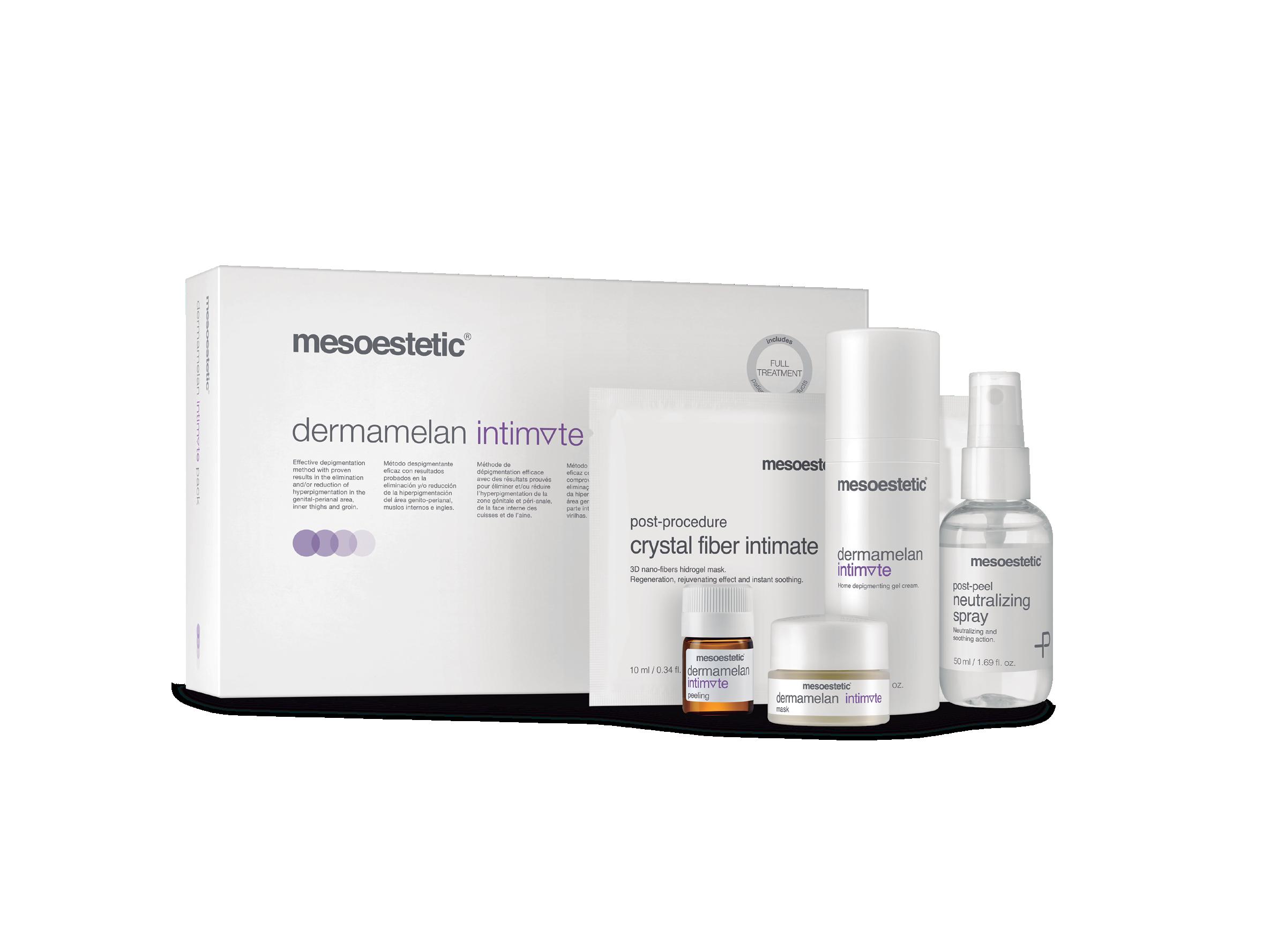
NEW from the world leader in depigmentation treatments
now you can correct pigmentation imperfections and improve the quality, turgor and appearance of the intimate area in a single clinical session.
This is the latest innovation in pigmentation treatment brought to you by mesoestetic® through over 35 years of research and development. Developed in collaboration with specialised gynaecologists.
mesopeel® advanced dermapeels by mesoestetic®
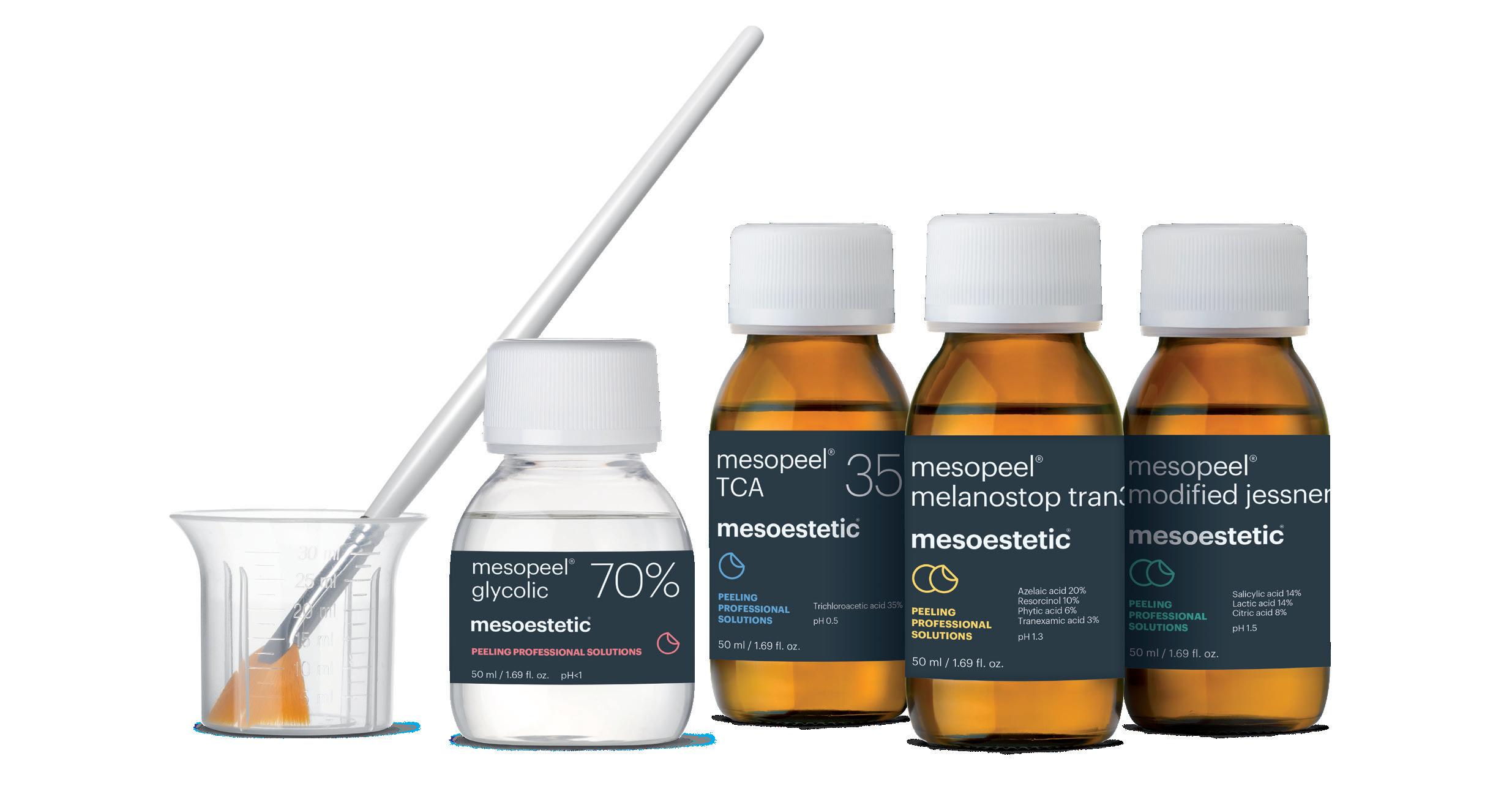
maximum versatility and effectiveness with clinically proven results

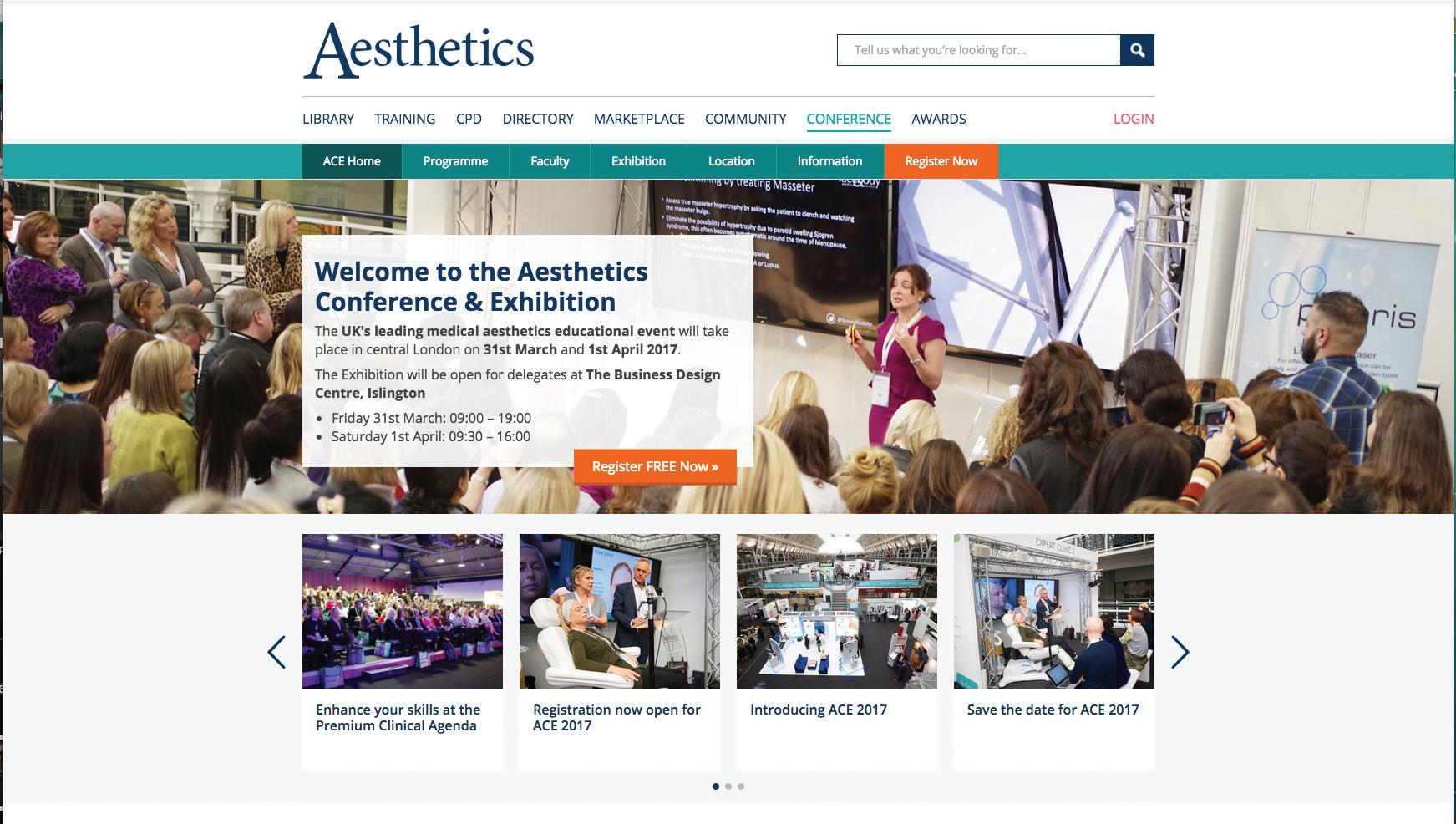
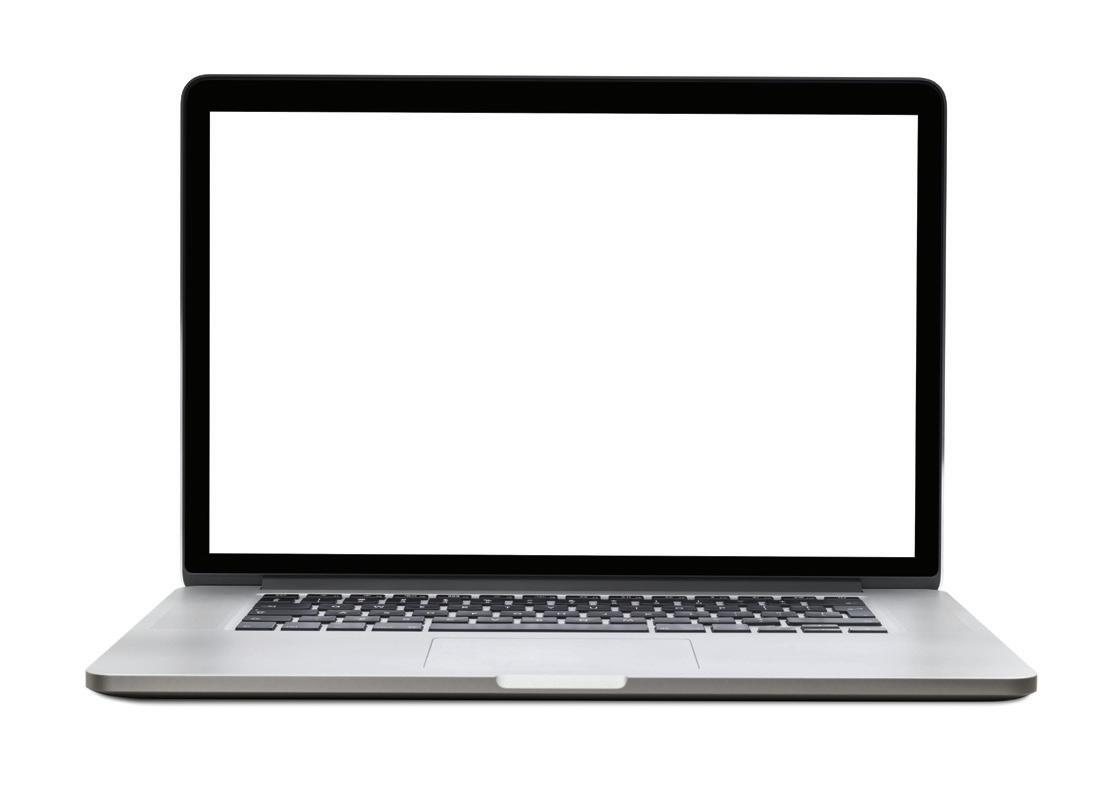
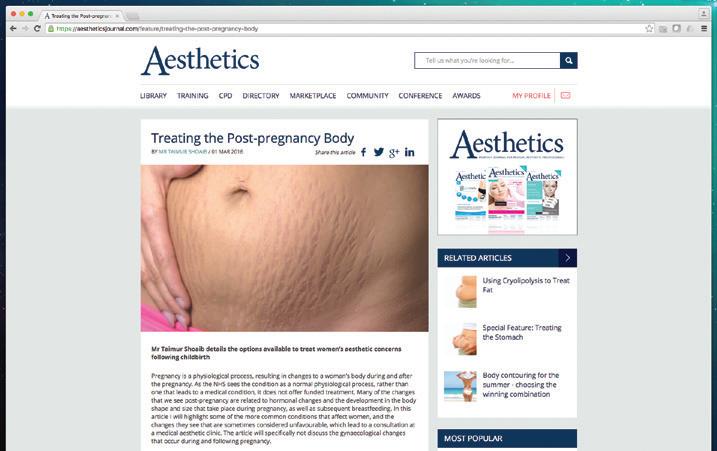


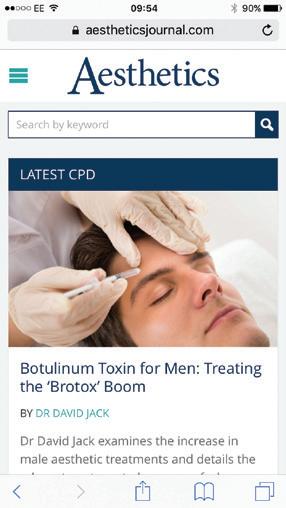
AESTHETICSJOURNAL.COM Keep up-to-date with the latest aesthetic developments and best practice guidance on your desktop, tablet or phone AESTHETICSJOURNAL.COM @aestheticsjournaluk Aesthetics @aestheticsgroup
Addressing Peri-Genital Hyperpigmentation
to improve. Whilst this could be perceived as being undertaken for male pleasure, in fact I find that women come to me for help with confidence. Men may also wish to have treatment for similar indications, however this is outside the scope of this article. Our role as aesthetic practitioners is to help our patients actualise those decisions.
The evolution of gynaesthetics
Gynaecological practice covers physiology and pathology of all aspects relating to primary and secondary sexual characteristics, with the ‘intimate area’ generally referring to that subset of genital and peri-genital areas: vaginal, vulval, inguinal, perineal, perianal and the proximal inner thighs.4,5
This area has historically been the territory of the gynaecologist. Sexual health is incredibly complex and important, incorporating puberty, sexual disease and disorders, contraception and pregnancy, before extending to management and quality of life delivery in menopause and older age.
There is an argument that the aesthetics of the intimate area should be an extension of normal gynaecological care, but in my opinion, we should consider the clear separation of obligatory clinical treatments and those that are elective, bringing us into the realm of aesthetics.6 The first aesthetic interventions were surgical – principally the labioplasty, which was first described medically in the 1970s, and then in 1984 as a cosmetic procedure.7 These interventions have become more and more prevalent since their publicisation in popular culture in the early 2000s, and require the specific skill set and support of plastic surgeons.8,9
In recent times, I have seen an exploding interest in aesthetic care and treatment for the intimate area. Google Trends from 2022 show hundreds of thousands of monthly searches for related conditions, which I find hardly surprising.1 We live in the age of the internet, which I believe has three particular areas of relevance here:
1) Traditionally awkward or uncomfortable questions can be asked and answered in the (relative) privacy of your web browser and phone screen
2) Social media and chat culture promotes comparison and discussion of areas previously considered private or even taboo
3) Hand in hand with these, sexuality has become subject to more open-minded consideration and discussion, and has become a key area of individual self-expression and development
There are many superficial downsides to this, including increased comparison, rising insecurities and acceptance issues (of self and others).2,3 But the truth is that just like a person’s face, the intimate area has always been a key aspect of who people are, both with themselves and other people. The difference is that today, people are generally more empowered to change the aspects of themselves which they are not comfortable with or want
The past two decades have seen the development and growth of a plethora of minimally- or non-invasive techniques in aesthetic treatments. Almost all of these are applicable to the intimate area, such as chemical depigmentation peels, botulinum toxin, mesotherapy, laser, radiofrequency, platelet-rich plasma and fillers. This goes hand in hand with a need for a general treatment approach which has understanding, setting and meeting patients’ hopes and expectations for the most personal part of their own body at its core.
Pigmentation in the intimate area
Aesthetic practice and techniques can be directly applied to the peri-genital area, as the same broad aetiologies apply to its conditions, wherever on the body it may be located.10 However, an understanding of the female intimate area is needed to be able to apply for vaginal rejuvenation. Hyperpigmentation (dark lesions), matrix disfunction and connective tissue breakdown (loss of elasticity, wrinkles and lack of volume), vascular insufficiency and loss of skin tone all apply, and a range of aesthetic techniques can be utilised to help.
The peri-genital area is prone to hyperpigmentation because it is replete with melanocytes (the cells that generate pigmentation), with density of up to 2,400 per square millimetre – the highest of any area of the body.11 The tissues of the area are also densely populated with sex hormone receptors, which have been demonstrated to regulate (and particularly upregulate) baseline

Reproduced from Aesthetics | Volume 10/Issue 1 - December 2022 @aestheticsjournaluk Aesthetics @aestheticsgroup aestheticsjournal.com @aestheticsjournaluk Aesthetics @aestheticsgroup aestheticsjournal.com Aesthetics | December 2022 49
Focus
Treatment
Hyperpigmentation
Dr Loredana Nigro shares her expertise on treating the intimate area with a minimally invasive approach
Before Before
After After
Figure 1: 38-year-old patient 45 days post single treatment plus homecare regime.
concerns
Figure 2: 44-year-old patient 45 days post single treatment plus homecare regime.
melanogenesis through activation of the non-classical receptors such as GPER and PAQR7.12 The physiological regulatory pathway is the mechanism behind gestational pigmentation such as chloasma and the linea nigra (the ‘mask’ and ‘line’ of pregnancy), and is a significant aetiological factor for peri-genital hyperpigmentation linked to puberty, birth control, pregnancy and menopause.13 In addition to the physiological propensity of intimate tissues to dyspigment because of the high expression of both melanocytes and sex hormone receptors, the area is also subject to a set of adjunctive environmental factors which are experienced by a large proportion of the population due to their grooming and clothing regime.14,15 Hair removal has become the norm. Waxing, heat and energy-based treatments have all been demonstrated to contribute to post-inflammatory hyperpigmentation.17 Moreover, although shaving is generally disregarded as benign, it in fact triggers a continuous inflammatory process resulting from regular microtrauma.18 Tight clothing and exercise also contribute to friction and the direct inflammatory stimuli which cause and increase intimate hyperpigmentation.
The environmental factors which commonly aggravate pigmentation, in conjunction with normal ageing, stress and hormonal imbalances, can cause these tissues to weaken, structurally and functionally, which can lead to aesthetically undesirable outcomes, as well as loss of sexual function, desire and confidence. The good news is that the growth and advancement in minimally-invasive aesthetic treatments has broad applicability to patients’ intimate concerns.
Emerging treatments
There are a myriad of treatments with peri-genital applicability, but they can be broadly split into five categories:
1. Applied cosmeceutical – this includes multi-action peels which have a variety of effects, including skin tightening, direct depigmentation and modulation of melanogenic pathways to
control ongoing pigmentation.18 These treatments are generally safe, low impact and efficacious.19,20
2. Injectables – these include a range of intradermal substances introduced with a hypodermic needle, cannula or specialised device. These may be cosmeceutically active sera, as used in mesotherapy, or structural fillers, which are typically cross-linked hyaluronic acid of specific, appropriate viscosity. Mesotherapy has applications for treatment of dyspigmentation, but also the introduction of rejuvenating components to improve skin tone, viscosity and regenerative function.21 Fillers can be used to improve the condition of the general extracellular matrix of the vaginal mucosa using a tracing technique, or to structurally augment the clitoris and g-spot to improve female sexual function.22
3. Neuromodulators – botulinum toxin has demonstrated efficacy in the direct treatment of vaginismus and other conditions.23
4. Energy-based – a variety of energy-based treatments (including lasers, high intensity focused ultrasound and radiofrequency stimulation) are used to generate controlled damage/inflammatory stimuli, triggering the body’s own rejuvenating processes in a controlled and optimised way.24
5. Clinical supplementation/application – this can provide the required micronutrients for healthy tissue maintenance and regeneration, and also stimulate and upregulate the relevant biochemical pathways associated with their maintenance.
Case studies
Patient 1 is a 38-year-old woman with Fitzpatrick skin type III. She exercises regularly, including cycling, spinning and road running. Throughout her 20s she used depilatory creams and shaved frequently. She noticed progressive darkening of the peri-genital area and became concerned about the aesthetics of the condition,




Reproduced from Aesthetics | Volume 10/Issue 1 - December 2022 @aestheticsjournaluk Aesthetics @aestheticsgroup aestheticsjournal.com @aestheticsjournaluk Aesthetics @aestheticsgroup aestheticsjournal.com Aesthetics | December 2022 50 Treatment Focus Hyperpigmentation Treatment Focus Hyperpigmentation
Growth and advancement in minimally-invasive aesthetic treatments has broad applicability to patients’ intimate
and coincidentally reported acanthosis nigricans and darkening of the elbow. This progressed to the point where the patient sought professional clinical aesthetic assistance for the specific condition. In Patient 1’s case, the likely aetiology appeared to be a combination of general age progression (possibly including hormonal factors) along with chronic low level inflammatory factors from grooming and tight clothing.
Patient 2 is a 44-year-old woman who presented with post-pregnancy melasma of the face, which is a frequent complication of pregnancy. This was successfully treated with a medium depth peel, and after that positive result, the patient admitted to similar concerns about darkness in the intimate area, which had worsened significantly during the pregnancy. The primary cause in Patient 2’s case was likely to have been the hormonal fluctuations of pregnancy, possibly with some adjuvant environmental factors.
As is the case with dermatological peels, the treated skin needs to be healthy at the time of treatment: that is to say free of infections, rashes and burns (including sunburns). As this is an external treatment there is no specific indication for a gynecological assessment. An adequate history and visual examination is all that is required.
For both of these patients, I recommended that a chemical peel would be the best treatment option for them because peels are the best mechanism to deliver combination treatments to deal with pigmentation in a way that is suitable for this area. I recommend in this case a full stack peel which includes combination acids to stimulate rejuvenation and additional ingredients such as vitamin C and retinol to clear existing pigment and improve tissue condition, as well as tyrosinase inhibitors and copper chelators to control repigmentation. It’s also useful from a patient confidence perspective to have a formulation that is approved for on-label use in this area. The type of peel I choose in my clinic is the Dermamelan intimate, a version of the Dermamelan Peel specially configured for use in the peri-genital area and CE approved, which follows three stages:
1. Pre-treatment assessment and preparation which involves assessment of the patient for suitability and contraindications, and administration of antiviral prophylaxis if required (e.g. in the case of history of recurring herpes simplex).
2. An intensive clinician-supervised, in-clinic application of the Dermamelan Intimate peel and mask, after covering sensitive mucosal areas with a protective gel. Post-application, the area is covered with a crystal fibre soothing mask and left to act for four hours, after which it is simply washed off in the shower.
3. Follow-up treatment with topically applied products to regulate skin rejuvenation and pigment production. The formulation is compounded into a liposomal topical delivery suspension, and works through three main effect arms: depigmentation, anti-inflammation and antiageing.
The tailored composition of Dermamelan Intimate is also designed to support optimal function of the peri-genital skin, including rejuvenation of the extracellular matrix to support normal connective tissue function. The tissue-firming and condition-improving effects in both patients can be clearly seen, along with depigmentation efficacy of the product (Figure 1-2). In my experience, side effects are rarely reported. It is extremely well-tolerated and the treatment area is amenable to therapeutic intervention if required. There are normally only very mild transient local symptoms such as redness or mild swelling, which resolve after 72 hours. The treatment of the existing pigmentation is permanent at the point of treatment, and the progression of any future dyspigmentation will depend on the environment and clinical condition (and lifestyle) of the patient. Typically, if required, treatment could be repeated at an interval of three to five years given a normal maintenance routine.
Creating awareness
Intimate pigmentation is a common, chronic condition, exacerbated by environmental and hormonal factors, which can cause significant distress. The raised profile of the issue, and the ability to borrow and customise safe and predictable treatments from general aesthetics, has led to safe, regulator-approved, on-label treatments for effective, predictable remediation. It is important for all practitioners to have an in-depth knowledge of the female intimate area and anatomy before conducting these treatments, as well as specific training.
Dr Loredana Nigro has evolved a practice in aesthetic medicine for more than a decade, specialising in antiageing and bioidentical hormone therapy. A special interest in pigmentation has naturally led to an area focus on gynaesthetics, which is an exciting new subspecialty in the aesthetic industry.
Qual: MBBCh (WITS)

Reproduced from Aesthetics | Volume 10/Issue 1 - December 2022 @aestheticsjournaluk Aesthetics @aestheticsgroup aestheticsjournal.com @aestheticsjournaluk Aesthetics @aestheticsgroup aestheticsjournal.com Aesthetics | December 2022 51 Treatment Focus Hyperpigmentation
THE
ONLINE!
The peri-genital area is prone to hyperpigmentation because it is replete with melanocytes
VIEW
REFERENCES
AESTHETICSJOURNAL.COM
FEEL GOOD

LOOK GOOD
Bocouture® (botulinum toxin type A (150 kD), free from complexing proteins) 50/100 unit vials*. Prescribing information: M-BOC-UK-0432. Please refer to the Summary of Product Characteristics (SmPC) before prescribing. Presentation: 50/100 units of Clostridium Botulinum Neurotoxin type A, free from complexing proteins as a powder for solution for injection. Indications: Temporary improvement in the appearance of moderate to severe upper facial lines (glabellar frown lines, crow’s feet lines, horizontal forehead lines) in adults ≥18 and <65 years when the severity of these lines has an important psychological impact for the patient. Dosage and administration: For intramuscular use only. Unit doses recommended for Bocouture are not interchangeable with those for other preparations of botulinum toxin. BOCOUTURE should only be administered by an appropriately qualified healthcare practitioner with expertise in the treatment of the relevant indication and the use of the required equipment, in accordance with national guidelines . The intervals between treatments should not be shorter than 3 months. Reconstitute with 0.9% sodium chloride. Glabellar Frown Lines: Total recommended standard dose is 20 units. 4 units into 5 injection sites (2 injections in each corrugator muscle and 1 injection in the procerus muscle). May be increased to up to 30 units. Injections near the levator palpebrae superioris and into the cranial portion of the orbicularis oculi should be avoided. Crow’s Feet lines: Total recommended standard dosing is 12 units per side (overall total dose: 24 units); 4 units injected bilaterally into each of the 3 injection sites. Injections too close to the Zygomaticus major muscle should be avoided to prevent lip ptosis. Horizontal Forehead Lines: The recommended total dose range is 10 to 20 units; a total injection volume of 10 units to 20 units is injected into the frontalis muscle in five horizontally aligned injection sites at least 2 cm above the orbital rim. An injection volume of 2 units, 3 units or 4 units is applied per injection point, respectively. Contraindications: Hypersensitivity to the active substance or to any of the excipients. Generalised disorders of muscle activity (e.g. myasthenia gravis, Lambert-Eaton syndrome). Infection or inflammation at the proposed injection site. Special warnings and precautions: It should be taken into consideration that horizontal forehead lines may not only be dynamic, but may also result from the loss of dermal elasticity (e.g. associated with ageing or photo damage). In this case, patients may not respond to botulinum toxin products. Should not be injected into a blood vessel. Not recommended for patients with a history of dysphagia and aspiration. Caution in patients with botulinum toxin hypersensitivity, amyotrophic lateral sclerosis, peripheral neuromuscular dysfunction, or in targeted muscles displaying pronounced weakness or atrophy. Bocouture should be used with caution in patients receiving therapy that could have an anticoagulant effect, or if bleeding disorders of any type occur. Too frequent or too high dosing of botulinum toxin type A may increase the risk of antibodies forming. Should not be used during pregnancy unless clearly necessary. Should not be used

during breastfeeding. Interactions: Concomitant use with aminoglycosides or spectinomycin requires special care. Peripheral muscle relaxants should be used with caution. 4-aminoquinolines may reduce the effect. Undesirable effects: Usually, undesirable effects are observed within the first week after treatment and are temporary in nature. Undesirable effects independent of indication include; application related undesirable effects (localised pain, inflammation, swelling), class related undesirable effects (localised muscle weakness, blepharoptosis), and toxin spread (very rare - exaggerated muscle weakness, dysphagia, aspiration pneumonia). Hypersensitivity reactions have been reported with botulinum toxin products. Glabellar Frown Lines: Common: headache, muscle disorders (elevation of eyebrow). Crow’s Feet Lines: Common: eyelid oedema, dry eye, injection site haematoma. Upper Facial Lines: Very common: headache. Common: hypoaesthesia, injection site haematoma, application site pain, application site erythema, discomfort (heavy feeling of frontal area), eyelid ptosis, dry eye, facial asymmetry, nausea. For a full list of adverse reactions, please consult the SmPC. Overdose: May result in pronounced neuromuscular paralysis distant from the injection site. Symptoms are not immediately apparent post-injection. Legal Category: POM. List Price: 50 U/vial £72.00, 50 U twin pack £144.00, 100 U/vial £229.90, 100 U twin pack £459.80. Product Licence Number: PL 29978/0002, PL 29978/0005 Marketing Authorisation Holder: Merz Pharmaceuticals GmbH, Eckenheimer Landstraße 100,60318 Frankfurt/Main, Germany. Date of Preparation:August 2021. Further information available from:. Ground Floor Suite B, Breakspear Park, Breakspear Way, Hemel Hempstead, Hertfordshire, HP2 4TZ Tel: +44 (0) 333 200 4143
Adverse events should be reported. Reporting forms and information can be found at www.mhra.gov.uk/yellowcard for the UK. Adverse events should also be reported to Merz Pharma UK Ltd at the address above or by email to UKdrugsafety@merz.com or on +44 (0) 333 200 4143.
*Botulinumtoxin type A, purified from cultures of Clostridium Botulinum (Hall strain)1
References: 1. BOCOUTURE® (incobotulinumtoxinA) Summary of Product Characteristics. Merz Pharmaceuticals GmbH. 2. Vistabel® (onabotulinumtoxinA) Summary of Product Characteristics. Allergan Ltd. 3. Dysport® (abobotulinumtoxinA) Summary of Product Characteristics. Ipsen Ltd. M-BOC-UK-0451 Date of Preparation: March 2022
BOCOUTURE®
is the only toxin that can be transported and stored prior to reconstitution without the need for cold chain1–3


(Botulinum toxin type A)
Continue advancing your knowledge on Ecademy Join our community to access tailored training modules and learn from industryleading experts
Free from complexing proteins



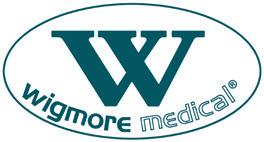
Understanding Exosomes

Canikyan Turkay
Unlike 10 years ago, there is a public interest from both patients and practitioners surrounding adipose-derived stem cells. These stem cells are suitable for the treatment of diseases such as autoimmune illnesses, soft tissue defects and even ageing.1-3 Whilst we are still trying to understand this revolution in regenerative medicine, scientists and clinical researchers are already moving to the next stage, away from autologous stem cells to their messengers – exosomes. Therefore, it is time for practitioners to understand this revolution in progress, moving us from traditional medicine to stem cell treatments and further to exosome research.
Background
Back in 2001, the industry learnt that we could harvest stem cells from fat tissue.4 Since then, many different methods have been created to isolate our own stem cells and use them for different medical problems and diseases. Today, autologous fat-derived stem cells are successfully used for soft tissue defects, cancer reconstruction, radiotherapy injury and other indications.4-6 However, if we take a close look into the mode of action of these cell treatments, we discover that these stem cells do not only fill defects or reinforce the host area, but they also send messages or orders out to the local cells to regenerate. The messengers carrying orders of anti-inflammation and regeneration are called exosomes.7
Recently, studies focusing on reversing the ageing mechanism and extending the lifespan of human beings have attracted the great attention of scientists and physicians.8-10 The article, Ageing research: Blood to Blood published in 2015, brought realism to ancient ‘vampire stories’ that have existed for centuries.11 Parabiosis is a 150-year-old surgical technique which includes the vascular structures of two living animals (the word comes from the Greek para, meaning ‘alongside’, and bios, meaning ‘life’) mimicking the natural instances of shared blood supply, like conjoined twins.12 Here, by joining the circulatory system of an old mouse to that of a young mouse, scientists have produced results with the heart, brain, muscles and almost every other tissue examined, the blood of young mice brought youth to older organs, making old mice healthier and stronger.11,13 Furthermore, several clinical trials are taking place to test the
benefits of young blood in older patients with diseases like Alzheimer’s or Parkinson’s.14,15
In the last few years, scientists have begun to identify the components of young blood that are responsible for these changes. This transfer of youth is carried by small messengers in the plasma component of the blood called exosomes. Exosomes are messenger particles that release naturally from a cell and are responsible for cell-to-cell communication. They carry genetic information and proteins to cells throughout the body and create paths for communication between cells. Also known as extracellular vesicles (particles that release naturally from a cell that cannot replicate) they are responsible for cell-to-cell communication. Exosomes are released naturally from cells upon the fusion of a discontinuous closed membrane system, also known as the intermediate endocytic compartment.16-18 Exosomes have begun to emerge in the UK market with skincare products containing exosome ingredients. If used intradermally, intramuscularly or intravenously, all these treatments need approval from the Medicines & Healthcare products Regulatory Agency (MHRA) and US Food and Drug Administration (FDA) and require an Investigational New Drug Application (IND) submission.19 This is because we cannot read and control what is written in those exosomes.20-21
Reproduced from Aesthetics | Volume 10/Issue 1 - December 2022 @aestheticsjournaluk Aesthetics @aestheticsgroup aestheticsjournal.com Aesthetics | December 2022 55 Clinical Focus Exosomes
Mr Tunc Tiryaki and Serli
introduce exosomes in aesthetic regenerative medicine and present their latest clinical research
Our capacity to utilise exosomes will ensure these regenerative treatments are more reachable, effective and affordable
Fibroblast
regular use.
The animal based cord blood exosome formulation , depth, count, volume, and area after 56 days from the product application.
3 :
application.
AFTER TREATMENT
AFTER TREATMENT
AFTER TREATMENT


TOPICAL TREATMENT LABELS// Figure
animal necessary animal based assay, a in terms that, Fibroblast wound by demonstrating that healing.



animal necessary based assay, a terms that, Fibroblast wound that
Focus Exosomes
//INSERT
//INSERT IMAGES AND DESIGNER TO ADD LABELS// progression after two years based cord blood exosomes cream topically.
//INSERT IMAGES AND DESIGNER TO ADD LABELS// progression after two years based cord blood exosomes cream topically.
IMAGES AND DESIGNER TO ADD LABELS// progression
after two years animal based cord blood exosomes cream topically.
//SUBHEAD// The future of exosomes
//SUBHEAD// The future of exosomes
//SUBHEAD//
the inflammatory process. steps together. This is a rate application of cord blood exosomes to the cell lines proliferation (40 components that play a vital role in healing cord blood exosomes increase collagen data. According to our findings, fibroblast levels increased in response to cord blood exosomes exosomes treatment of HDF and human umbilical vein growth factor (VEGF) was upregulated in the
dermal fibroblast (HDF) cells treated with cord blood serum exosomes migrated faster, resulting in a 50% higher wound closure rate after 24 hours. The findings showed that these nanoparticles could be internalised by fibroblasts and dramatically increased their proliferation and migration potential, demonstrating that the activation of fibroblasts is a way through which cord blood exosomes facilitate wound healing.
inflammatory process. together. This is a rate application of cord blood exosomes to the cell lines proliferation (40 50%) in a that play a vital role in healing blood exosomes increase collagen According to our findings, fibroblast increased in response to cord blood exosomes treatment of HDF and human umbilical vein factor (VEGF) was upregulated in the
the inflammatory process. steps together. This is a rate application of cord blood exosomes to the cell lines proliferation (40 components that play a vital role in healing cord blood exosomes increase collagen data. According to our findings, fibroblast levels increased in response to cord blood exosomes exosomes treatment of HDF and human umbilical vein growth factor (VEGF) was upregulated in the
Anti-inflammation effect of hydrosomes
inflammatory process. together. This is a rate application of cord blood exosomes to the cell lines proliferation (40 50%) in a that play a vital role in healing blood exosomes increase collagen According to our findings, fibroblast increased in response to cord blood exosomes treatment of HDF and human umbilical vein factor (VEGF) was upregulated in the
Disclosure: Mr Tiryaki is currently working on a topical skincare product which contains exosomes.
The future of exosomes
Regenerative and cellular treatments are proven to be effective in problems such as hematopoietic disease, soft tissue defects these methods still harness surgical intervention, limiting their availability. Our capacity to utili e exosomes will ensure these regenerative treatments Treatments with exosomes or expanded mesenchymal stem cell and FDA regulatory bodies. The invasive treatments or similar organisations, but as we have shown in our pre clinical studies, the topical applications seem to work successfull y. While increasing our experience and understanding of this technology through topical use, it is vital to have reliable data from more invasive tudies in human subjects that can prove that exosome products are safe and effective.
Cell proliferation assay
In acute wounds, the proliferative phase starts after the inflammatory process. To bridge the gap, this stage involves both cell migration and proliferation steps together. This is a rate-limiting healing factor that must be presented for effective healing. The application of cord blood exosomes to the cell lines evaluated resulted in a considerable increase in cell proliferation (40-50%) in a dosage-dependent manner.
Collagen and elastin assay
Collagen and elastin are extracellular matrix components that play a vital role in healing. As a result, our findings support the hypothesis that cord blood exosomes increase collagen and elastin expression levels based on immunocytochemistry data. According to our findings, fibroblast transforming growth factor-β (TGFB) expression levels increased in response to cord blood exosomes administration. Furthermore, after cord blood exosomes treatment of HDF and human umbilical vein endothelial cells (HUVEC), vascular endothelial growth factor (VEGF) was upregulated in the vascularisation and wound healing (Figure 2).
Regenerative and cellular treatments are proven to be effective in problems such as hematopoietic disease, soft tissue defects these methods still harness surgical intervention, limiting their availability. Our capacity to utili e exosomes will ensure these regenerative treatments Treatments with exosomes or expanded mesenchymal stem cell and FDA regulatory bodies. The invasive treatments or similar organisations, but as we have shown in our pre clinical studies, the topical applications seem to work successfull y. While increasing our experience and understanding of this technology through topical use, it is vital to have reliable data from more invasive clinical studies in human subjects that can prove that exosome products are safe and effective.
Regenerative and cellular treatments are proven to be effective in problems such as hematopoietic disease, soft tissue defects these methods still harness surgical intervention, limiting their availability. Our capacity to utili e exosomes will ensure these regenerative treatments Treatments with exosomes or expanded mesenchymal stem cell and FDA regulatory bodies. The invasive treatments MHRA or similar organisations, but as we have shown in our pre clinical studies, the topical applications seem to work successfull y. While increasing our experience and understanding of this technology through topical use, it is vital to have reliable data from more invasive clinical studies in human subjects that can prove that exosome products are safe and effective.
Anti-inflammation is a major process in healing. Hydrogen peroxide (H2O2) tests are used during in vitro research to drive the onset and stimulate inflammation via the activation of nuclear factor kappa B (NFκB) transcription factors. H2O2 was utilised and shows that when it is only used, high cellular toxicity was detected, whereas when H2O2 and cord blood exosomes were administered at the same time onto healthy cell lines to initiate an inflammation reaction, results showed similarities with positive control, indicating that animal-based cord blood exosomes influenced pulling inflammation back to the control level. It can be concluded that cord blood exosomes can shield fibroblast cells against inflammation caused by reactive oxygen species.
Third party clinical trials

The aim of the test was to define the direct influence of the tested product on the reduction of the wrinkle area. The measurements have been performed at the site of application, before product application, after 28 days and after 56 days of regular use (Figure 3).
The animal-based cord blood exosome formulation was shown to reduce wrinkle length, depth, count, volume and area after 56 days from the product application.
The future of exosomes
Regenerative and cellular treatments are proven to be effective in problems such as hematopoietic disease, soft tissue defects and radiation injury. However, these methods
Serli Canikyan Turkay is a genetic bioengineer. After graduation she worked as a research assistant at Harvard Medical School on stem cells and microchip technology. She continued her career in a stem cell GMP lab as a coordinator of production and research and development. For the last 10 years, she has worked as the chief research officer at Mane Biotech. Qual: Msc
VIEW
THE

AESTHETICSJOURNAL.COM
LABELS// Figure 2: Immunocytochemistry analysis after dermal cells. Red shows increase of collagen and
Figure 2: Immunocytochemistry analysis after dermal cells. Red shows increase of collagen and
Figure 2: Immunocytochemistry analysis after dermal cells. Red shows increase of collagen and
@aestheticsjournaluk Aesthetics Aesthetics | December 2022 57 Clinical
Reproduced from Aesthetics | Volume 10/Issue 1 - December 2022 @aestheticsjournaluk Aesthetics application and Figure 1)
application and treatment (Figure 1).
uptake of animal nucleus. is necessary animal based widely performed to In this assay, a closure in terms revealed that, Dermal Fibroblast higher wound internalised by demonstrating that healing. Figure 1).
LABELS// Figure 2: Immunocytochemistry analysis after dermal cells. Red shows increase of collagen and
Mr Tunc Tiryaki is a consultant plastic surgeon and works in facial regeneration. He was one of the first surgeons to use fat-derived stem cells for mini facelift procedures. Mr Tiryaki is the chair of the Humanitarian Programmes of ISAPS and founder of ISAPS-LEAP Surgical Relief Teams. He is a section editor for the Aesthetic Plastic Surgery Journal and has authored several internationally published publications on regenerative facelifts and micro-lifting. Qual: MD
AFTER TREATMENT
TREATMENT
Figure 3: Diabetic unhealing wound progression after two years and a finger amputation. Both cases used an animal-based cord blood exosomes cream topically.
regular use.
The animal based cord blood exosome formulation , depth, count, volume, and area after 56 days from the product application.
AFTER TREATMENT
TREATMENT
The animal based cord blood exosome formulation , depth, count, volume, and area after 56 days from the product application.
AFTER TREATMENT
TREATMENT
define the direct influence of the tested product on the reduction of the
instrumental study was carried out on 108 subjects. I The measurements have been blood
application –before product application, after 28 days and after 56 days of
exosome formulation was shown to reduce wrinkle length , depth , count,
BEFORE THE TREATMENT
2 WEEKS AFTER THE
was shown to reduce wrinkle length , depth , count,
Diabetic u nhealing w ound progression
2 WEEKS AFTER THE
TOPICAL TREATMENT
REFERENCES ONLINE!
Before Before Two weeks after After one week
still harness surgical intervention, limiting their availability. Our capacity to utilise exosomes will ensure these regenerative treatments are more reachable, effective and affordable. Treatments with exosomes or expanded mesenchymal stem cells are not yet authorised by the MHRA and FDA regulatory bodies. The invasive treatments, such as injections, require approval from the MHRA or similar organisations, but as we have shown in our pre-clinical studies, the topical applications seem to work successfully. While increasing our experience and understanding of this technology through topical use, it is vital to have reliable data from more invasive clinical studies in human subjects which can prove that exosome products are safe and effective.





Reproduced from Aesthetics | Volume 10/Issue 1 - December 2022 @aestheticsjournaluk Aesthetics aestheticsjournal.com








Reproduced from Aesthetics | Volume 10/Issue 1 - December 2022 @aestheticsjournaluk Aesthetics @aestheticsgroup aestheticsjournal.com
Modern hair transplantation has evolved from punch hair transplantation into more advanced treatment options.1 Currently, the most common hair restoration techniques for commercial use are follicular unit transplantation (FUT) and follicular unit excision (FUE).2 FUT is an invasive surgical procedure where a long strip of scalp with hair follicles is excised in order to get donor hair grafts or follicular units. A scalpel is used to cut and remove a part of the skin, while stapling and suturing are used for closure.3 In contrast, FUE utilises small punches to detach demarcated hair grafts (follicular units) from the scalp.4 FUE requires hair grafts to be harvested individually in a two-step method – sharp punch placed into the scalp and forceps to manually separate grafts – which can be very laborious and tedious due to volumes of up to 2,000 to 3,000 grafts. With many of the issues and challenges with harvesting and implantation discussed above, advancements in artificial intelligence (AI), machine learning and vision have allowed for mitigation of many of the challenges faced with FUE procedures.
A new era in hair restoration
The first robotic platform to contribute to the evolution of hair restoration and address its challenges in hair transplantation was the ARTAS® Robotic Hair Restoration System, developed by Venus Concept Inc. (San Jose, CA). This device focuses on AI-assisted robotic FUE. It harnesses the power of mechanical imaging, AI and the robotic execution capabilities of the system to harvest follicular units and create recipient sites. The most recent version, ARTAS iX Robotic Hair Restoration System, virtually robotises the entire hair transplantation process by adding implantation capabilities.

Robotic Hair Restoration in Modern Aesthetics
ARTAS iX from Venus Concept is a robotic medical device that offers precise, accurate and reproducible harvesting with simultaneous recipient site-making and implantation functionalities in a single, compact platform. The ARTAS iX system contains AI integration, a high-definition multi-camera stereoscopic vision system and state-of-the-art medical-grade hardware that contributes to hair transplantation technology.
ARTAS iX’s AI machine learning recognises and digitally maps past, current and future grafts on the scalp. The AI can intelligently analyse, monitor and track each hair follicle’s characteristics, such as the position, angle, size and orientation for optimal harvesting, site making and implantation, delivering repeatability and precision.


An effective alternative Manual FUE is a widely used and clinicallyproven technique in hair transplantation. However, the procedures are often long and require thousands of precise repetitive motions to accurately excise and implant individual grafts. Fatigue can cause pain and discomfort for the clinician, and potentially lead to human error and higher transection and reduced yield rates, particularly towards the end of long cases. Furthermore, manual implantation requires a significant amount of graft handling at the bulb of the hair follicle.
Before After
Given the relative fragility of the follicles, increased handling can lead to a higher risk of damaging the follicle. The amount of handling, and hence opportunity for the graft to be damaged, is limited with the use of the robotic implanter. Use of an image-guided, AI controlled robotic system, such as the ARTAS iX to assist in the procedure, addresses many of the physical limitations of human vision, decision of the location from which to excise or where to implant, physical fatigue and motor skill precision. At the same time, ARTAS iX produces comparable 12-month results to those achieved using manual techniques by an experienced surgeon. The stick and place method of implantation used by ARTAS iX (placing the graft immediately after incision) reduces bleeding, and eliminates the need for continual cleaning of the recipient sites of blood as is common when sites are premade. ARTAS iX is able to excise hairs at a rate of 1,000 grafts/hour, which is at the top of the range possible by an experienced surgeon doing a manual hair transplant. Typical excision rates vary between 100-1,000 grafts/hour for the manual method. The implantation rate is 500 grafts/hour, which is significantly faster than manual stick and graft placement rates of about 400 grafts/ hour. The ARTAS iX can provide clinicallyefficient surgical workflows that are superior to manual techniques, with the potential to reduce total case time for FUE procedures, while at the same time reducing graft manipulation thanks to the stick and place technique used by the device.
REFERENCES
1. Chumak M, ‘Robotics in Hair Transplant surgery’, Hair by Dr. Max, Restoration Center
2. Berman D, ‘Robotic, AI-assisted Follicular Unit Incision and Implantation for Hair Restoration with ARTAS iX’, Berman Skin Institute.
3. Williams KL, Gupta AK, Schultz H, ‘Ergonomics in hair restoration surgeons’, J Cosmet Dermatol, 2016.
4. Avram MR, Watkins SA, ‘Robotic Follicular Unit Extraction in Hair Transplantation’, Dermatologic Surg, 2014.
This advertorial was written and supplied by
Email: info.uk@venusconcept.com
Aesthetics | December 2022 60 @aestheticsjournaluk Aesthetics @aestheticsgroup aestheticsjournal.com Advertorial Venus Concept
How artificial intelligence and technology developments are revolutionising hair restoration
Figure 1: Before and after ARTAS by Bernard Salameh, MD
A summary of the latest clinical studies
Title: Use of Liquid Concentrated Growth Factor in the Management of Necrotic Tissue after Facial Vascular Complications Induced by Hyaluronic Acid Injection
Authors: Wang X, et al.
Published: A Compendium of Clinical Research and Practice, November 2022
Keywords: Complication Management, Facial Tissue Necrosis, HA Filler
Abstract: HA fillers may induce facial vascular embolism, resulting in tissue ischemia and necrosis are severe iatrogenic complications. This single-centre case series studied the use of liquid CGF in managing facial tissue necrosis due to HA injections. All 12 patients with facial tissue necrosis (two mild, three moderate, seven severe) were previously treated with hyaluronidase injection in outside hospitals. They received a routine injection of hyaluronidase (dose of 400-1500 U) at the site of ischemia immediately after admission to the authors’ hospital, but CGF was also injected. CGF injection was repeated once weekly until wound healing. Efficacy was assessed at four weeks. No patient experienced wound expansion or aggravation or infection at the sites of necrosis. A complete healing rate of 91.67% was noted at the four-week follow-up. No scarring was evident in patients with mild to moderate necrosis. Those with moderate necrosis exhibited varied degrees of scarring after recovery, and scarring was evident in those with severe necrosis. No severe adverse effects occurred. CGF promoted the healing of ischemic and necrotic tissue wounds induced by facial vascular embolism following injection of HA fillers. CGF should be considered as a non-surgical treatment method for this complication.
Title: Multi-centre Pivotal Study Demonstrates Safety and Efficacy of a New Cellulite Procedure: Final Results at 12 Months
Authors: Stevens W, et al.
Published: Aesthetic Surgery Journal, November 2022
Keywords: Body, Cellulite, Device
Abstract: A single-arm, multi-centre, open-label pivotal study, using CONtrolled Focal Fibrous Band Release Method to assess Targeted Verifiable Subcision (TVS) for the treatment of cellulite. Final, twelve month data describing durability of treatment effect and safety of using a single TVS procedure performed by the Avéli device (Revelle Aesthetics, Inc., Mountain View, CA) to treat cellulite on the buttock and thigh areas of adult females are presented here for the first time. Effectiveness was determined by three independent physicians using the Cellulite Severity Scale (CSS) and Global Aesthetic Improvement Scale to assess improvement of baseline photographs when compared to 3-, 6- and 12-months post-treatment photographs. Blinded participant-reported outcomes and safety evaluations were also performed at all post-procedure time points. Clinically significant improvement in primary endpoint CSS scores were sustained out to one year, improving by 1.50 (p< .0001) at three months, 1.54 points at six months and 1.48 points at 12 months. Adverse events were mild and mostly resolved by the 12 month visit. A single TVS treatment has durable efficacy and safety in reducing cellulite on the buttocks and thighs of women with moderate to severe cellulite out to 12 months post-treatment.
Title: Condensing of Low-Density Fat by Mechanical Process Improves Fat Retention and Reduces Oil Cyst Formation in Breast Reconstruction
Authors: Quan Y, et al.
Published: Aesthetic Plastic Surgery, November 2022
Keywords: Breast Reconstruction, Breast Surgery, Plastic Surgery Abstract: Although autologous fat grafting is a useful adjunct for breast reconstruction, its indications remain limited as largevolume fat grafting results in high absorption and complication rates. Low-density fat includes small numbers of viable cells and considerable oil, resulting in nodules and oil cysts. This study evaluated the volumisation effect and complications with combined fat grafting of condense low-density fat and high-density fat. This retrospective, single-centre study included 25 patients who underwent combined grafting of condensed low-density fat and high-density fat (CLDF + HDF) and 20 patients who underwent conventional Coleman fat grafting for breast reconstruction from December 2017 to January 2022. Graft retention rate was higher in patients who underwent CLDF + HDF than Coleman fat grafting. One patient in the CLDF + HDF grafting group, compared with twelve in the Coleman fat grafting group, developed oil cysts exceeding 1cm. Patient satisfaction rate was higher in the CLDF + HDF grafting group. Mechanical processes can concentrate the cellular content of LDF and remove oil, condensing LDF to the level of HDF. Combined grafting of CLDF and HDF is effective for breast reconstruction, with a higher retention rate and a lower incidence of complications than Coleman fat grafting.
Title: Recent Advances in Herbal-Derived Products with Skin Anti-Ageing Properties and Cosmetic Applications
Authors: Costa E, Magalhães W, di Stasi L


Published: Molecules: A Journal of Synthetic Chemistry and Natural Product Chemistry, November 2022
Keywords: Anti-ageing, Herbal Formulations, Wellness
Abstract: Although aesthetic benefits are a desirable effect of the treatment of skin ageing, it is also important in controlling several skin diseases, mainly in aged people. The development of new dermocosmetics has rapidly increased due to consumers’ demand for non-invasive products with low adverse effects. Natural compounds of plant origin and herbal-derived formulations have been popularised due to various safe active designed for treatment of skin ageing. Based on this, the aim of the review was to identify the recent advances in herbal-derived product research, including herbal formulations and isolated compounds with skin anti-ageing properties. The studies evaluated the biological effects of herbal-derived products in vitro, ex vivo and in vivo studies, highlighting the effects that were reported in clinical trials with available pharmacodynamics data that support their protective effects to treat, prevent or control human skin ageing. Thus, it was possible to identify that gallic and ferulic acids and herbal formulations containing Thymus vulgaris, Panax ginseng, Triticum aestivum or Andrographis paniculata are the most promising natural products for the development of new dermocosmetics with skin anti-ageing properties.
Reproduced from Aesthetics | Volume 10/Issue 1 - December 2022 @aestheticsjournaluk Aesthetics @aestheticsgroup aestheticsjournal.com 61 Aesthetics | December 2022 @aestheticsjournaluk Aesthetics @aestheticsgroup aestheticsjournal.com Clinical Papers Abstracts
Implementing Sustainability in Your Clinic
As we continue to witness intense environmental challenges across the globe, from climate change to plastic pollution, efforts to be more sustainable are now more crucial than ever. Over the past decade, ‘sustainability’ has become the buzzword for the future, and is fast becoming a necessity. People have become more receptive to green messaging, and the growing number of eco-friendly options now on the market proves that the interest is there. A 2022 survey by Deloitte found that of 2,000 UK adults surveyed, 40% chose brands that have environmentallyfriendly practices and values, suggesting that sustainability is becoming more important to the consumer.1
Within the aesthetic clinic, many areas can be assessed and improved upon to enhance sustainability. This includes reduction of single-use plastics and energy consumption, as well as looking closely at suppliers and employee behaviours. Fortunately, professionals can implement small and cost-effective changes that, in the long-term, will have a positive effect on the planet.
Single-use plastic
As the war against plastic rages on, we’re still seeing worrying reports, statistics and news stories about the damaging effects plastic has on habitats and ecosystems. For example, it’s estimated that five million tonnes of plastic are used every year in the UK alone, with nearly half coming from packaging.2 It comes as no surprise, then, that microplastics (fragments of plastic less than 5mm in length) have been found in both human lung tissue and deep-sea sediment.3-5 A plastic bag has been found in the Mariana Trench – the deepest point in the ocean at around 36,000 feet.6
Within the healthcare sector, plastic continues to be a prevalent issue. Prior to the pandemic, the NHS produced 11,300 tonnes of waste daily, 2,500 tonnes of which was plastic waste.7 Of course, during the pandemic, the demand and consumption of plastic products such as masks and personal protective equipment (PPE) was immense for the general public and healthcare professionals alike. The need to protect human health largely superseded environmental concerns,
with many plastic reduction policies and waste management strategies being temporarily put on hold.8 Now, aesthetic practitioners and clinics must be vigilant when it comes to cutting down on single-use plastics. The health of patients and staff members is of the utmost importance, and there may be concerns about whether more environmentally appropriate alternatives provide the same level of protection and quality as disposable/reusable materials. Indeed, single-use plastic items meet the requirements of the industry, whereby patients are partly protected from the spread of infection by using disposable sterile products. Nevertheless, a balance must be achieved between human and environmental health. There are various areas within the clinic where plastic usage can be reduced. For example, in the staff room, you can stock up on reusable cups, dishes and cutlery, and encourage your team to bring in reusable containers and water bottles. Where singleuse items are used for treatments, such as cotton buds, investigate alternatives that use environmentally-friendly or biodegradable materials like bamboo. There are also other options available like reusable syringes, which may not be viable for all indications, but can still cut plastic waste in some situations. Indeed, some plastic items are unavoidable, so it’s crucial to implement strict recycling and/ or reusing protocols within your team.
You could organise the recycling of your PPE, gloves and face masks, or consider investing in reusable or biodegradable alternatives that will reduce your wastage. If you do not do so already, position recycling bins around the clinic, especially in the waiting area and staff room, to encourage your patients and team to be more mindful when disposing of their waste. It is also worth considering if the plastic equipment you use is correct for your practice – do you need your current size of sharps container? Is it full when it’s collected, or could you opt for a smaller one? Going paperless is a great way to reduce waste and streamline processes within the clinic on a larger scale. Many professionals have now automated procedures within their clinic, whereby patient forms, payment receipts and recalls can all be handled electronically with no paper required. There are countless digital solutions that can support your decision to go paperless, including clinic management software apps which can make your practice more efficient (turn to p.66 to learn more about your options).
Reproduced from Aesthetics | Volume 10/Issue 1 - December 2022 @aestheticsjournaluk Aesthetics @aestheticsgroup aestheticsjournal.com 62 Aesthetics | December 2022 Clinic Development
Sustainability
Product manager Rebecca Waters shares her advice on cost-effective changes you can introduce in your clinic to make a difference to the planet
Products and suppliers
It can be challenging to source a supplier whose sustainable vision aligns with yours, but nowadays more and more companies are recognising the significance of providing greener options. As such, there is more choice and it’s worth exploring different suppliers and finding out about their practices. You could work together with your chosen supplier and arrange bulk deliveries to reduce the environmental impact of transport from the supplier to your clinic.9 Have you considered working with UK suppliers, if you don’t already? Not only can you cut costs and delivery times by going local, but you’ll also be helping reduce emissions and your carbon footprint. To further minimise waste and prevent over-ordering and over-spending, it’s vital that a member of your team completes a thorough stock audit and rotation to ensure items with the shortest shelf-life are being used first. Many clinics will have worked with one manufacturer for a long time, and if you are reluctant to look elsewhere just yet, address your concerns with them and see if they are open to making changes to their products, as prioritising sustainability will increases products’ appeal to consumers. For example, many skincare manufacturers are using packaging that is made from recycled materials or is reusable, so make sure to ask your supplier about this. Further positive switches can be made with the cleaning products you stock. From washing up liquid to laundry detergent, there are plenty of environmentally-friendly brands available. Even the soaps in your toilets can be switched to those which contain more natural ingredients without harsh chemicals. To save money and lower your carbon footprint, bulk buying products is also a good idea.
Reducing energy consumption
Another common conversation within healthcare revolves around energy consumption. Fortunately, encouraging better habits among the team can be cost-efficient
and highly effective. Machines which aren’t used constantly, such as the printer, coffee machine or computer, can simply be switched off when not in use. Computers are thought to draw 94% less energy when in hibernation mode compared to being idle.9 Here, switching the device’s settings to automatically enter hibernation mode after a period of time could help your energy-saving efforts. Aesthetic devices can also consume more energy than is necessary – consider switching them off at the wall at the end of each day or installing plugs which switch off automatically when not in use. Similarly, swapping your lightbulbs to more energy-efficient alternatives can not only reduce your energy consumption, but also prove a far better long-term investment for your clinic and the environment. According to the Energy Saving Trust, switching from a 50-watt halogen bulb to a light-emitting diode (LED) bulb could save you up to £5 per bulb per year, or as much as £13 per bulb per year when switching from a 100-watt incandescent bulb to an LED one.10 LED lighting is also thought to use around 75% less energy and last 25 times longer than incandescent or fluorescent-tube lighting.11
Employee behaviours
Around 9.5 billion miles of all road travel in England is related to patients, visitors and suppliers of the NHS, contributing to approximately 14% of the service’s total emissions.12 This goes to show the additional emissions created by the healthcare industry in general. There are many ways team members could reduce their own environmental impact when travelling to clinic, which will help create a more sustainable workplace ethos. For instance, could those who drive to work take public transport, walk or cycle? Could they team up with other colleagues and carpool? A study noted that a 5% shift to walking and cycling in staff commuting would help reduce carbon and air pollution emissions by more than six tonnes of nitrogen oxide and 0.4 tonnes of particle matter, which are both harmful to health.13 This would avoid around £300,000 in costs to
healthcare and society.13
Staff engagement is highly important when making your clinic an environmentally conscious establishment. Consider getting your team together and chatting through the ways everyone can make changes for the better. Increase awareness through training days, posters and videos and encourage proactiveness – ask questions and get your team working together. It’s best to introduce any changes slowly so everyone can get used to them in their own time.
Small changes for the better
These changes are all cost-effective, with most taking minimal time to implement. In fact, many clinics may already be utilising these tips without even realising. Making switches from single-use plastics to more sustainable alternatives, in addition to prioritising reusing and recycling, can radically reduce the environmental impact of your clinic. Turning off lights and devices when not in use and encouraging staff to establish more positive habits are also simple practices.
Starting small is a great way to recognise how straightforward sustainability can be. Alongside these small changes, you can start planning for larger adjustments further down the line, which might include investing in solar panels, for instance. The topic of environmental sustainability within all areas of the healthcare sector has been firmly brought to the fore, and it’s here to stay.
Plastic pollution and climate change seem like insurmountable challenges, but only continuous efforts (big and small) can trigger long-lasting, positive change for the planet.
Rebecca Waters is the product manager for Initial Medical and has worked in the healthcare sector for the past 13 years.
Waters keeps up-to-date on all developments within the clinical waste management industry and is an active member of the Chartered Institution of Wastes Management, Sanitary Medical Disposal Services Association and British Dental Industry Association.

Reproduced from Aesthetics | Volume 10/Issue 1 - December 2022 @aestheticsjournaluk Aesthetics @aestheticsgroup aestheticsjournal.com 63 Aesthetics | December 2022 Clinic Development Sustainability
VIEW THE REFERENCES ONLINE! AESTHETICSJOURNAL.COM
Sustainability has become the buzzword for the future, and is fast becoming a necessity
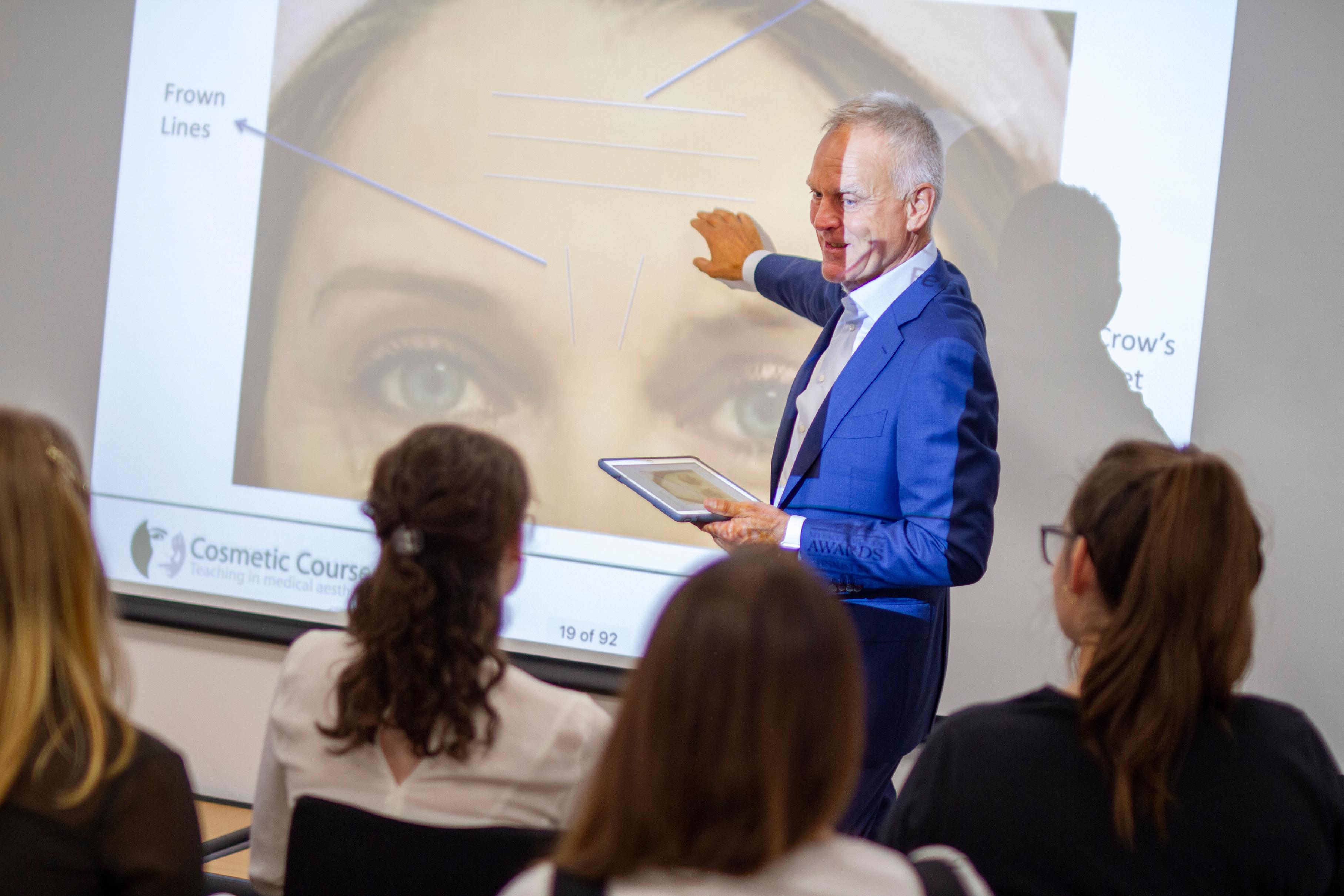
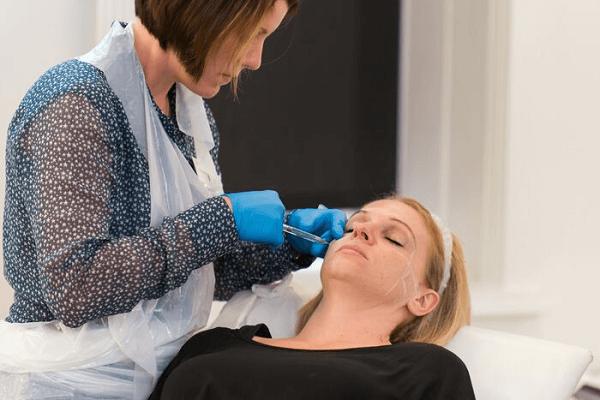





Reproduced from Aesthetics | Volume 10/Issue 1 - December 2022 THINKING THINKING ABOUT ABOUT LEVEL 7? LEVEL 7? WHY COMPLETE YOUR LEVEL 7 WITH COSMETIC COURSES? 4 390110 | ask@cosmeticcourses.co.uk www.cosmeticcourses.co.uk | @cosmeticcourses 10% OFF until 31/01/23 ✔ Industry leading Level 7 Diploma ✔ Only using live models ✔ 10% lifetime discount off courses ✔ No hidden costs ✔ 0% finance options ✔ Award winning training provider ✔ Accredited with JCCP and CQC standards ✔ Experienced team of medical aesthetic teachers ✔ Multifaceted engaging online learning ✔ Partners with the leading aesthetic insurance providers ✔ Dedicated team to prepare you ✔ Further training available YOUR OPTIONS: Talk to the team today: Fast Track: Recognition of Prior Learning (RPL) Full Qualification SCAN TO FIND OUT MORE: THINKING ABOUT 7? LEVEL WHY YOUR LEVEL 7 WITH 01844 390110 | ask@cosmeticcourses.co.uk www.cosmeticcourses.co.uk | @cosmeticcourses 10% OFF 31/01/23 ✔ leading Level 7 Diploma ✔ Only using live models ✔ lifetime courses ✔ No hidden costs ✔ 0% finance ✔ winning training ✔ with JCCP and CQC ✔ Experienced team of medical aesthetic teachers ✔ engaging online learning ✔ Partners with the leading aesthetic ✔ Dedicated team to prepare you ✔ YOUR OPTIONS: Talk the team today: Fast Track: Recognition Prior Learning (RPL) Qualification SCAN FIND MORE:
Tackling the Recession
Three business professionals discuss the impact the impending recession will have on the aesthetics specialty, and how practitioners can optimise their resources to cope

It is no secret that the UK, and indeed the world, is currently going through a period of economic hardship. Political uncertainty, turbulent international relations and the UK’s shifting place in the world market have combined to create an economic crisis that is projected to soon descend into what Bank of England officials are saying could be the longest recession since records began.1
This prospect is daunting to most people, and the aesthetics industry is no exception. Many practitioners may be concerned that their patients will be less willing to continue with a course of aesthetic treatments or regimens when times are tough. Indeed, research conducted by Rare: Group consultancy firm concluded that three in four people out of 3,500 UK adults agree finance is an important factor when preventing them from receiving medical aesthetic treatments.2
Aesthetics spoke to three business gurus who have a positive view on how practitioners can navigate the situation with the correct strategy and mindset. In this article, previous clinic owner and founder of medical aesthetic distributor AestheticSource Lorna Bowes, social media marketing and business trainer Miranda Pearce and director at aesthetic service provider for Plim, Nada Ali Rheda, share how practitioners and clinics can practise efficiently and retain patients during this time.
The aesthetic industry and the recession
The business experts we have spoken to explain that the recession will have a number of direct effects upon the aesthetics industry, some of which have already emerged. Some distributors and manufacturers have already experienced problems with supply chains of both products and ingredients, which they say have been exacerbated by both Brexit and the Ukraine war. Placing sanctions on Russia due
to their invasion of Ukraine has increased the price of imports, meaning many suppliers are increasing their prices.5 Bowes explains that the pricing issue is a difficult one to navigate, but clinics have various options including increasing their own prices to account for this, altering their supply chain to find more affordable alternatives or absorbing costs and losing out on some short-term revenue. Imports and exports have also been slowed down due to new customs regulations post-Brexit, as since January 2021, all cargo leaving or arriving in the UK from the EU has to undergo a full customs declaration.6 This has caused huge delays because every vehicle takes approximately 15 minutes to register the required paperwork, sometimes leading to queues of up to 20 miles of lorries backing up from ports in Dover.7 Consequently, supplies get stuck, aggravating delays. However, the primary concern for aesthetic practitioners and business owners in the current climate is likely to be whether they can retain their patients or attract new business when so many people will be cutting back on expenses. Research conducted by Rare: Group found that of 3,500 UK adults, 78% of people considering medical aesthetic treatment in the next 12 months believe the cost of living crisis will impact them,8 and 80% of those considering botulinum toxin and dermal filler treatments in the next 12 months believe the cost of living crisis will impact them.9
Formulating a strategy
The key to coping with a difficult economic climate is to stay composed and think methodically, according to Bowes, who advocates for a solid strategy. “There is massive opportunity out there, it’s just a case of making sure that you are really true to your business plan,” she explains. “Sit down and think it through, making sure you
Recessions past and present
A recession occurs when a country’s economy declines rather than grows for more than two subsequent quarters; this often happens in conjunction with rising unemployment rates and falling retail sales.3 There can be multiple causes of a recession, but according to Forbes, the primary ones are sudden economic shock (in this case, triggered by Russia’s invasion of Ukraine), excessive national debt (caused by the increased investment required during the COVID-19 pandemic), or too much inflation/deflation (exacerbated by the UK’s unsettled political climate).3
The most recent recession in the UK occurred during Q1 and Q2 of 2020 due to the beginning of the pandemic, but at this moment, many people will be thinking of the Great Recession in 2008.4 From April 2008 to mid-2009, the UK economy shrunk for five subsequent quarters, and it took five years to recover to pre-recession levels.4 The severity of the impending recession in comparison to the 2008 crisis is yet to be seen.
Reproduced from Aesthetics | Volume 10/Issue 1 - December 2022 @aestheticsjournaluk Aesthetics @aestheticsgroup aestheticsjournal.com 65 Aesthetics | December 2022 Business Development Recession
know exactly what your unique selling point (USP) is.”10
Bowes explains that if your USP is a high-end service with bespoke, top quality treatments, feel free to highlight this to attract higher-paying patients. You can even consider a price increase if you feel your patients would be accepting of it, as this could help offset rising supplier costs. Adversely, Bowes advises not to shy away from offering more affordable options, as long as you are appealing to your ideal patient base.
Introduce automation
There are various platforms available to assist in implementing automation in your clinic. Here are a few examples:
• Aesthetic Nurse Software*
• AesthetiDocs*
• Collums Clinic Software
• e-clinic*
• iMediDoc
• Pabau
the last six months? What have your customers used the most? You can use this information to ensure you’re only spending money on what your patients respond positively to. If practitioners really tap into the data that they have and consolidate that data, they can better manage their cash.”
Maximising your marketing potential
• Rushcliff
• Sellsio
• Zenoti
A central aspect of your strategy could be establishing skincare as one of your clinic’s key offerings, as this is an easy way to generate repeat passive income. Bowes has had personal experience of this being a successful approach, saying, “When we went through some tough financial challenges while I had my clinic, skincare was my bread and butter. It was my rock, which everything else was built upon.”
*Visit these companies at ACE –check out p.20 to learn more!
She goes on to say, “I recommend doing an individual plan for each patient to achieve what they’re looking for. You want repeat business from your patients, so if you provide them with a cleanser, a day cream and an eye cream for example, and they see results, you can earn your extra income because there’s a lot of money to be earnt by doing skincare well.” Bowes recalls generating exceptional patient loyalty from this approach, with one patient even staying with her for 20 years and spending more than £70,000 on skincare and in-clinic treatments.
Optimising technology
Offering top-quality service and treatments is crucial, but good use of technology is key in order to deliver this successfully. The use of technological automation is something to consider to boost your business efficiency in a financial downturn. One area in which automation can be effective is through managing your finances. Ali Rheda thinks that patients and practitioners alike will become increasingly interested in incremental payment options whereby patients can pay for treatments and practitioners can pay for new devices through regular increments over an agreed period, rather than all at once. She says, “Buying a laser device can cost anywhere from £40,000-250,000. Usually, clinics buy a machine and then spend a lot to acquire customers to come and use it and that’s how they repay that amount. If you use a financing service to buy it in instalments however, it can help cash flow tremendously because customers are paying for the machine while using it.” Such services include Plim, Karma Finance, Pretty Face Finance and Snowbird Finance.
There are also various technology applications on the market which can help in implementing automation in your clinic’s everyday services and processes (see box above).
Technology can also be used to gather information on your patients’ wants and needs, especially through using artificial intelligence (AI) such as data analytics and social media metrics in your analysis.
According to Ali Rheda, practitioners are liable to lose money if they invest in expensive devices or treatments without gauging patient demand, which technology can help with. “AI can be used to answer multiple questions about your practice,” she says, explaining, “Always consider: who is your best practitioner? What is your best service in
When drawing in and retaining patients is a key concern, an informed and consistent approach to marketing is essential.11 This is another area where automation can be employed.12
Ali Rheda explains, “I think using platforms to help reduce customer acquisition costs is a big potential money-saving tool. For instance, instead of paying someone to manage social media, sales strategies and telemarketing, practitioners could actually use a platform to market their products and services. By doing this, you’re centralising the services a little bit, making it cheaper for you to bring in new customers.”
Pearce is a big advocate of using social media to boost your clinic’s presence and engage with both existing and prospective patients, and especially recommends capitalising on the rise of short-form video.13 She says, “When it comes to selling to your patients, you need to think where’s the most bang you’re going to get for your buck? And by buck, I mean your time, because promotion is free these days. The answer is definitely short-form video – Instagram Reels and TikToks. I recently went viral three or four times on TikTok, and it showed me the power of that platform to reach a ridiculous amount of people. I think the reason it’s so powerful is because people want to escape, even just through educational content that allows people to be consumed in that moment.”
She emphasises that this engagement, even if just on Instagram stories, is crucial to keep patients interested. “Through consistent communication, patients are going to quietly build a relationship with you in a way that you don’t even see happening,” she says. For a more hands-on approach, Pearce recommends trying your hand at organising events and showcasing what your clinic offers. She explains, “My partner (Dr Tim Pearce) and I were trying to build a business during the recession in 2008, we hustled hard. We focused on creating hype around events we were running, like demonstration evenings. Lean into ‘what’s in it for me’ and consider
Reproduced from Aesthetics | Volume 10/Issue 1 - December 2022 @aestheticsjournaluk Aesthetics @aestheticsgroup aestheticsjournal.com 66 Aesthetics | December 2022 Business Development Recession
“There is massive opportunity out there, it’s just a case of making sure you are true to your business plan”
Lorna Bowes
why would anyone come to your promotional or educational event? If you really focus on what the patient potentially wants, you can benefit your patients as well as your practice.”
The lipstick effect
The lipstick effect is a phenomenon coined by author Juliet Schor in 1997, and refers to the concept that in times of recession/economic stress, people (mostly women) are more likely to invest in discretionary purchases in order to boost their mood.14 Research conducted by American psychologists between 1992 and 2011 found that during times of economic hardship and high unemployment, the US census revealed reduced spending on electronics, furniture and leisure/ hobbies, but increased spending on clothing/accessories and cosmetics.15
Making your patients feel valued
In a time of turbulence such as this one, taking a personal approach to your patients so they feel like they know you before, during and after treatment is invaluable.
Ali Rheda agrees with this concept, saying, “Post-treatment engagement or interaction plays a big role. It’s psychological – it makes patients think that your service was money well-spent because they’ve made a connection.” She highlights that, once again, automation can come in handy here. “One way to achieve this is to have a properly designed automated email message. To emphasise that you’re there for the patient, or to remind them to drink plenty of water post-procedure, for example. This is a small solution that can enhance customer loyalty.”
Bowes states that this is also important when ensuring patients understand the treatments they are considering. “Practitioners need to engage in dialogue with every single patient about the products they use and the clinical evidence behind them to demonstrate that they’re using the best skincare, the best filler, the best device or whatever it is – they’re really going to want to understand the science before they spend their money. Communicate with everybody in the clinic team –front of house, therapists, nurses, doctors – to ensure they know the science behind every treatment you’re providing.”
Actions that don’t take too much energy away from clinic time can still be effective here, as Pearce highlights. “One way to keep in touch with patients is to just reach out to literally say, just thinking of you and I thought I’d reached out and say hi, I hope you well, let me know if I can help you with anything,” she advises, adding, “The majority of people will come back to you because they’ll just be grateful that someone remembered them. I promise you when they’re ready, they’ll come to you because you’ve built that relationship.”
Weathering the storm
We cannot ignore that there are tough times ahead, but there could be potential positives on the horizon, such as making your clinic more efficient, learning more about what your patients actually want and building a stronger relationship with your patients and team.
Despite all of the uncertainty around how the recession will impact the medical aesthetics specialty, Ali Rheda remains hopeful. “Even though there is a recession or there is a downturn in the economy, aesthetics is no longer a thing that people think of as a luxury – it’s actually something they think is an essential part of feeling good,” she says. “I think that after COVID-19, people have started investing
in experiences, and are more willing to spend on things like aesthetic treatments despite financial hardship.” This idea is often referred to as the lipstick effect.
Bowes believes practitioners should capitalise on this, saying, “Instead of going on the expensive holiday, patients may go on a weekend break, but stick with their brands. I think we’re going to see an increase in brand loyalty, which highlights the importance of trust with your supplier. Is the science genuine? Do patients really see the results? If so, they’re going to have a home-cooked meal instead of a takeaway, but keep hold of their skincare and other aesthetic procedures.”
Pearce seconds the significance of this mindset, adding, “I think that when we think of aesthetics, far too many people think that it entails vanity and indulgence, but I actually see it as the opposite, because it’s about carving out control. By choosing to have a treatment, patients are showing themselves that they can control this one area of their life. I think if we can have that kind of mindset, then we will take the kinds of actions that will allow us to weather the storm.”
She concludes that it’s key for business owners to maintain a positive mental attitude throughout the recession and beyond, sharing that, “At the start of the pandemic in 2020, I felt like I was staring down the barrel of a gun, but a friend told me, you are going to tell a story at the end of this period. Do you want your story to be that you thrived during this period? And in that moment, I just made the decision and we thrived. I think the recession we’re facing right now is much the same.”
REFERENCES
1. Thomas D, Jordan D. ‘Bank of England expects UK to fall into longest ever recession’ BBC News (UK: BBC News, 2022) <https://www.bbc.co.uk/news/business-63471725>
2. Rare: Consulting Adults 16+ in the UK (N=3,519) Data collected 16th September - 1st November 2022. Q108r5 - How influential would the following be in preventing you from receiving medical aesthetic treatment? - The ongoing financial commitment. Those who answered ‘Very’/’Somewhat influential’. Base: full sample (N=3,519).
3. Rodeck D, ‘What Is A Recession?’ Forbes Advisor (UK: Forbes, 2022) <https://www.forbes.com/uk/ advisor/investing/what-is-a-recession/>
4. Office for National Statistics, ‘The 2008 recession 10 years on’ (UK: ONS, 2018) <https://www.ons.gov. uk/economy/grossdomesticproductgdp/articles/the2008recession10yearson/2018-04-30>
5. Lawrence D, ‘UK trade and the war in Ukraine’ Chatham House (UK: Chatham House, 2022) <https:// www.chathamhouse.org/2022/09/uk-trade-and-war-ukraine>
6. Yarwood M, ‘Brexit: guidance for ports and terminals’ Through Transport Mutual Insurance Association Limited (UK: TT, 2021) <https://www.ttclub.com/news-and-resources/articles/brexit-guidance-for-portsand-terminals/>
7. BBC News ‘What’s been causing lorry queues at Dover?’ (UK: BBC News, 2022) <https://www.bbc. co.uk/news/60111856>
8. Rare: Group. Adults 16+ in the UK (N=3,519) Data collected 16th September - 1st November 2022. Q10 - How is, if at all, the cost of living crisis impacting you? Those who are considering any medical aesthetic treatment in the next 12 months (N=710).
9. Rare: Group. Adults 16+ in the UK (N=3,519) Data collected 16th September - 1st November 2022. Q10 - How is, if at all, the cost of living crisis impacting you? Those who are considering medical aesthetic treatment in the next 12 months. Dermal fillers (N=223), botulinum toxin (N=285), medicated weight management (N=182).
10. Bird V. ‘Developing a USP’ Aesthetics (UK: Aesthetics, 2022) <https://aestheticsjournal.com/feature/ developing-a-usp>
11. Dempster J. ‘Attracting Your Ideal Patient’ Aesthetics (UK: Aesthetics, 2022) <https://aestheticsjournal. com/feature/attracting-your-ideal-patient>
12. O’Neill R. ‘Understanding Marketing Automation’ Aesthetics (UK: Aesthetics, 2022) <https:// aestheticsjournal.com/feature/understanding-marketing-automation>
13. McLaughlin C. ‘Utilising Social Media Effectively’ Aesthetics (UK: Aesthetics, 2022) <https:// aestheticsjournal.com/feature/utilising-social-media-effectively>
14. Danziger P, ‘With Recession Threatening, The Lipstick Effect Kicks In And Lipstick Sales Rise’ Forbes (UK: Forbes, 2022) <https://www.forbes.com/sites/pamdanziger/2022/06/01/with-inflation-rising-thelipstick-effect-kicks-in-and-lipstick-sales-rise/?sh=6b16db231276>
15. Hill S, et al. ‘Boosting Beauty in an Economic Decline: Mating, Spending, and the Lipstick Effect’ Journal of Personality and Social Psychology (US: American Psychological Association, 2012) <https:// personal.tcu.edu/sehill/LipstickEffectMS20March2012.pdf>, p. 3.
Reproduced from Aesthetics | Volume 10/Issue 1 - December 2022 @aestheticsjournaluk Aesthetics @aestheticsgroup aestheticsjournal.com 67 Aesthetics | December 2022 @aestheticsjournaluk Aesthetics @aestheticsgroup aestheticsjournal.com Business Development Recession
Implementing Trends in Your Clinic
To future proof revenue, all businesses must be dynamic and evaluate the key themes that drive their patient base. If you maintain the status quo and ignore global trends, you may find yourself getting left behind. Former Intel Corp CEO Andrew Grove once said, “Success breeds complacency. Complacency breeds failure.”1 Therefore, we must understand what is shaping the aesthetic specialty of tomorrow and the evolving demands of our patients. Global trend reports talk of the destigmatisation of cosmetic treatments, increased aesthetic fluency and patient knowledge around treatment options, as well as a desire for more natural results.2-4 The reports highlight the march of younger generations who seek age prevention over a cure, a growing diversity amongst patients who want treatments tailored to their skin colour and ethnicity, with gender-inclusive and de-gendered beauty targeting men and LGBTQ+ people now at the forefront of the social zeitgeist.2,3 By embracing trends and implementing changes in your business, you may be able to communicate more effectively with your patients, now and in the future.
Aesthetics for the 2020s
Over the past decade, our approach to aesthetics has shifted significantly. We now incorporate more advanced injectable techniques which give more natural results, and use a 360-degree approach of combining skincare, devices and injectables to target what a patient truly needs. Interest in aesthetic treatments amongst consumers has never been greater. Once a hushed topic of conversation, shifting cultural norms mean that modern aesthetic consumers are happy to shout about it from the rooftops. I have noticed that they now have a ‘know-what-they-want’ attitude combined with a heightened understanding of antiageing and rejuvenating products and techniques. The increasingly natural results and the appearance of looking fresher rather than having had aesthetic treatments have made this more socially acceptable. Once all about the ‘Boomers’ – patients are getting younger, but ironically so - this crowd of ‘Millennials’ and the ‘GenZ’, or ‘Zoomers’, who follow them are shaking things up. Below, I outline some of the top global trends which practitioners need to be aware of and implement into their practices.
1. Age prevention
GenZ and most millennials are not seeking a cure for ageing – simply because they have not yet aged – but instead they crave prevention and preservation. Finding very subtle signs of ageing (such as early crow’s feet lines or a slight nasolabial fold), they embark on aesthetic treatments in their 20s and 30s. They have money to spend (or will find it) and do not feel self-conscious investing in their appearance – which their parents’ generation might regard as selfish or vain. Thankfully, increased awareness of the power of these treatments through educational social media and expert-led conversations for the readiness of this generation to seek aesthetic procedures makes these treatments more readily available. The key to nurturing and cultivating this spending relationship as your ‘patients-of-the-future’ lies in evolving your communication and the treatments you deliver. Many procedures will be the same (dermal fillers and neurotoxins), but will start with lower doses/volumes or milder device protocols as proactive age prevention, adapting over time to result in increased spending. Global pharmaceutical companies are actively targeting product marketing campaigns at younger, more diverse users.5-8 Practitioners must alter how they communicate, becoming more visually centred in consultations. Discuss and objectively view photographs, explain how their appearance changes with different camera angles, lighting and filters. Photographs can both distort and enhance facial features and anomalies, allowing you to tap into the small details that may be
bothering them. Remember, although they are younger with only subtle concerns, it should not raise a flag for body dysmorphia by default, but practitioners should be wary to look out for this in their patients.
Society will continue evolving on a visual foundation, with the metaverse tipped as the next iteration of the internet and set to become a huge trend over the coming decade (read more on p.72).3 As a result, future generations will become even more embedded in their virtual selves.
2. Diverse individuality
The UK has a diverse, multicultural society. Government figures show that in 2021, 14% of the UK population was from a minority ethnic background.9 Depending on the location of your clinic, it is highly likely that your patient database is equally as diverse, if not more so, and you are seeing more and more patients from different ethnic backgrounds. With diversity comes individuality – we are not all the ‘same’, so we cannot be ‘treated’ the same with generic procedures. It cannot be about treating skin of colour based on the Fitzpatrick scale alone. We must respect ethnic characteristics, facial anatomy and cultural ideals of beauty to ensure that people of all ethnicities are represented and reflected in the aesthetic sector of the future. For example, consider if you highlight diverse case studies in your digital marketing. You can achieve diverse individuality by understanding the unique needs of different ethnicities, creating personalised treatment plans and educating yourself where you lack knowledge in treating a broader spectrum of skin types and face shapes. Look for training courses where anatomical variations are explored and expose yourself to advanced education opportunities, such as at international conferences. Do not be afraid to refer onwards if you fear you will deliver a one-size-fits-all-beauty result; there is less shame in admitting your shortcomings than in ‘Westernising’ an Asian patient, for example.
3. Gender inclusivity
Gender identity and gender inclusivity are a hot topic – understanding how others view their gender, accepting those differences and not perpetuating gender stereotypes. Remember this when considering your aesthetic patient; for example, women in their 40s and 50s have historically been the ‘bread and butter’ of an aesthetic clinic. Nowadays, I have noticed that we see many more men as a growth market. Although these cisgender individuals are
Reproduced from Aesthetics | Volume 10/Issue 1 - December 2022 @aestheticsjournaluk Aesthetics @aestheticsgroup aestheticsjournal.com 68 Aesthetics | December 2022 @aestheticsjournaluk Aesthetics @aestheticsgroup aestheticsjournal.com Marketing Trends
Dr Sophie Shotter discusses five global trends which are driving the future of aesthetics and how you can easily execute them in your practice
the most common visitors, many clinicians are treating an increasing number of non-binary and transgender patients who, thankfully, no longer seek clandestine treatment for fear of discrimination.
Modern men are far more comfortable looking after themselves than their fathers and grandfathers, who were content with a bar of Imperial Leather and a splash of Old Spice on special occasions. This new breed has male grooming high on their agenda and spend list. Men want to look good, maintain professionalism and career progression and enjoy new relationships later in life. According to the latest data from the International Society of Aesthetic Plastic Surgery, men make up 14.3% of the global market for non-invasive procedures, with statistics expected to increase.10 Hence, the demand for male-centred aesthetic treatments is on the rise.11
Marketing campaigns by many dermal filler brands now include men in promotional materials to help you tap into this market. You can also make your clinic environment male-friendly and consider the fact that men might feel uncomfortable in a waiting area full of women or posters aimed at women. Consider using male imagery on your social media to make it clear these treatments and your clinic are a great environment for men.
Gender-inclusive beauty means that traditional ideas and assumptions around masculinisation or feminisation are turned on their head. We must adopt a degendered approach to aesthetic treatment to celebrate all the possible ways patients wish to express their identity and gender. For example, the K-Pop culture has created a trend for men to have much softer and less masculine features, whilst some women seek a stronger jawline as an expression of female power.
Approach your consultation in a way that does not prejudice the treatment outcome based on the gender you think you see in front of you. Consider if you want to ask your patients for their pronouns on your forms.
4. Aesth-ethics
Ethics or aesth-ethics is driving a clean-up in the aesthetic sector. As a medical professional with a background and oath of ‘do no harm’, it upsets me to see the consumer press full of stories about ‘botched’ jobs, thanks to the rise in the number and variety of non-regulated and non-medical practitioners now involved
in providing lucrative aesthetic treatments, with little to no oversight or training standards. This results in unnatural patient outcomes and some new words to add to our lexicon –overtreated and overfilled.
Of course, we must get our own house in order, including ensuring treatments are always in the best interests of the patient and their mental health, and not only beneficial to our bottom line. Know when you should just say no – when you think your patients’ desires don’t align with what you feel comfortable with, when what they’re asking for is beyond the realms of healthy (in either a physical or psychological way), and also just when your gut is telling you there is something not quite right here.
Regulation of the sector has been notoriously poor, but this rose to heady heights following the 2013 Keogh report which appeared to offer unfettered access to treatment delivery and training due to a lack of statutory instruments.12 Times are changing with tighter regulations and registration models on the horizon due to changes promised in the new Health and Social Care Act 2022.13 Review your credentials, ensure your CPD is relevant and updated and consider advanced post-graduate or prescribing qualifications to fit into the future landscape of aesthetics, then we can all distance ourselves from a ‘botched’ world.
5. Patient experience
Who doesn’t like to feel loved and nurtured, to be valued, and enjoy a bit of pampering and the odd perk? Hairdressers learnt this some time ago, so you can expect a drink and a head massage alongside your cut and blow-dry. However, many aesthetic practitioners start in small, back-room clinics, perhaps shared premises that do not evoke a luxury experience.
Aesthetics is about building relationships, retention and loyalty, but for many patients, treatment is a significant investment, so they expect a relaxed, luxurious experience that complements a holistic, patient-centred approach to individualised treatments to keep them loyal. They are not just buying a syringe of filler; they are buying into a lifestyle. Drive retention by creating great experiences and ensuring your lapsed patients feel special and missed. Focus on each patient’s journey with you making them feel valued and understood from the moment of their first interaction with you, their first consultation visit, to aftercare. Patients want to feel noticed and cared
about. Build relationships with them, make notes about their upcoming special events or how they take their coffee, and think about picking up the phone if you’ve not seen them for a while. When they realise they’ve been missed, it often reignites their connection to your business.
We can also create spaces that reflect us as clinic owners – trendy, arty, luxury etc. High-end décor and clinic furniture, fresh flowers, music, attention to detail from engaging staff (such as remembering their name and giving them a friendly smile) and complimentary refreshments all add to an elevated experience for your patients before entry into the clinical environment.
Are you ready for modern aesthetics?
Times are changing and trends predict a new era for the aesthetic specialty. As clinic owners, we must regularly reflect to optimise communication and engagement with our patients. Consider their age, gender, personality and diversity when creating individualised treatment plans, practise ethically and create enjoyable patient experiences.
Dr Sophie Shotter is an aesthetic doctor with practices in Kent and London. She is a full member and Board Trustee at the British College of Aesthetic Medicine and is a member of the Allergan mentorship programme. Dr Shotter is a key opinion leader for several leading aesthetic companies and is regularly called on to speak and teach.

Qual: MBChB, BSc(Hons), PGDip(Hons), PGCert, MBCAM

Reproduced from Aesthetics | Volume 10/Issue 1 - December 2022 @aestheticsjournaluk Aesthetics @aestheticsgroup aestheticsjournal.com 69 Aesthetics | December 2022
Marketing Trends
WANT TO KNOW THE LATEST TRENDS IN THE
Scan the QR code to read the new CCR Trends Report! VIEW THE REFERENCES ONLINE! AESTHETICSJOURNAL.COM
UK?


After being one of the first aesthetic practitioners to introduce botulinum toxin to the UK, Dr David Eccleston has since grown a leading clinic and established his own training academy. Dr Eccleston was born and bred in Sutton Coldfield in Birmingham, conducting his medical degree at Birmingham Medical School and qualifying in 1987. His initial enthusiasm lay with dermatology, as he says, “I found that the skin taught me so much about underlying disease processes and it was really a reflection of the personality of the individual.” His interest grew, and he trained at the Birmingham Skin Centre before entering cosmetic dermatology in 1994. He received training from Drs Jean and Alastair Carruthers, who first discovered that botulinum toxin can be used to treat glabellar lines, hence becoming one of the first UK practitioners to learn about toxin’s aesthetic usage in 1999. He does not underestimate the privilege of being involved in the birth of aesthetic medicine in the UK, saying, “We were actually making a difference. I know that to many people outside the aesthetics specialty it may sound silly and vain, but when your patient looks in the mirror and sees a miserable, angry person looking back at them, it makes them feel miserable and angry. But, if the person is relaxed and chilled and doesn’t look stressed out after toxin treatment, that gives positive feedback and therefore can completely transform the lives of our patients.”

In 1999, Dr Eccleston opened his own clinic – MediZen – just down the road from his childhood home in Sutton Coldfield. In the preceding two decades, the clinic has grown to house five medical practitioners across nine treatment rooms, offering injectables, skincare regimens, radiofrequency, CO2 laser, weight management services and more. He values the variety he offers his patients, commenting, “I like a broad portfolio. I think if you just become an expert in one thing, then it’s a very narrow level of expertise and one’s career can be quite short because eventually, you start sounding like a scratched record.” As well as being passionate about amazing aesthetic results, Dr Eccleston is deeply invested in responsible practice, with aesthetic procedures delivered solely by medical professionals. He is a faculty member of the Aesthetic Complications Expert Group World and a member of the British College of Aesthetic Medicine. He also set up his own training academy –MediZen Academy – 15 years ago, where he teaches qualified doctors, dentists and nurses safe and effective techniques for injecting filler and toxin. To ensure he stays abreast of the latest treatments and products, Dr Eccleston set up an in-clinic clinical study facility in 2002, from which he has conducted more than 30 studies on various hyaluronic acid fillers and six different toxins. He is passionate about remaining at the forefront of medical research, commenting, “It’s such an evolving science that I need to be at the front of it. For me to stand up on stage as an expert, I need to have the credibility of being able to list the pros and cons of each product and treatment.”
Dr Eccleston is a key opinion leader for pharmaceutical company Allergan, medical aesthetic company Evolus, aesthetic manufacturer Cutera and medical-grade skincare brand AlumierMD, and has taught and spoken for them all on the international stage. He was a founding member of Allergan’s Medical Institute (AMI) Faculty, and is now AMI’s national complications manager, helping spread the word on responsible practice.
Having been in the industry throughout its rise to popularity in the UK, he is in a brilliant position to comment on the incredible evolution the specialty has seen over the years. Dr Eccleston explains that he has noticed that patients are now seeking a more natural look, commenting, “In the olden days, the endpoint, particularly for toxins, was to freeze the muscles completely, but now patients don’t want a pillow face, they don’t want to look frozen.” He is also excited about the future of addressing cellular ageing and wellness, including
weight management, supplements and dietary advice. “We’re moving into the rejuvenation market from an internal point of view rather than just treating the external manifestation,” he says. “I think the term ‘holistic’ is a huge buzzword which is long overdue, and it’s certainly something I’m moving into with enthusiasm and alacrity.” Dr Eccleston’s journey in aesthetics has not always been easy. At the beginning of his career, he found juggling family life with being a figurehead for the UK aesthetics specialty difficult, while today the biggest challenge is dealing with complications following procedures performed by non-medics. He says, “That’s a real frustration of mine, and it’s something that I’m really passionate about – I wish I had the time to campaign more actively on it.”
He encourages practitioners new to the industry to seek mentorship where they can, and always put medical knowledge first.
“Don’t leave your degree and go straight into aesthetics,” he says, “You need to understand everything from a medical point of view. The investment made in training a new doctor or nurse is so huge, that morally I think there is a duty to give something back to the state that’s trained you. I would say learn to consult properly, and also be humble because if you’re not humble, there will always be someone who wants to see you fail.”
The most popular treatments for patients in your clinic...


Botulinum toxin, combination microneedling, dermal fillers and skin-hydrating injectables.
An ethos you keep in mind throughout your practice…
Be nice – give support freely and ask for it when you need it yourself.
Reproduced from Aesthetics | Volume 10/Issue 1 - December 2022 @aestheticsjournaluk Aesthetics @aestheticsgroup aestheticsjournal.com 71 Aesthetics | December 2022 In Profile Dr David Eccleston
“Aesthetics is such an evolving science that I need to be at the front of it”
Dr David Eccleston reflects on his career in aesthetics and how he has seen the specialty grow since its inception
Favourite thing about the industry… Making patients happy and improving their quality of life.
The Last Word
The aesthetics industry has been rapidly growing for several decades now, and during that time we have seen many trends come and go. We have experienced the impact of social media and filtered images, the dramatic changes resulting from a global pandemic and the rise of body treatments offering a new frontier to the modern aesthetic practitioner. Aesthetics has embraced and manoeuvred through these trends year on year. Founder of Facebook Mark Zuckerberg would have us believe that the metaverse is the next significant trend that will cause seismic changes to every industry including aesthetics. Many large retail companies are already rushing to buy virtual real-estate in the metaverse to get ahead of the competition.1,2 Whether we buy into this idea or not, the technologies associated with a metaverse (such as virtual reality) will undoubtedly open new and exciting opportunities in aesthetics.
A background on the metaverse
According to technological research and consulting firm Gartner, the metaverse is a collective virtual space created through the convergence of virtually enhanced physical and digital reality.3 The metaverse

is neither device-dependent nor owned by a single vendor. Instead, it has numerous contributing trends including virtual reality (VR), augmented reality (AR) and artificial intelligence (AI).3 According to venture capitalist Matthew Ball, who has written a nine-part primer on the topic, a full adoption of the metaverse is likely decades away.4 Despite this, there have been some developments in VR, AR and immersive games which enable people to get a feel for virtual worlds with headsets and simulations.
The concept of a metaverse can be traced back as early as 1838 when Sir Charles Wheatstone coined ‘binocular vision’, combining two images to make a single 3D image which led to the development of stereoscopes. This is the same concept used in VR headsets today.5 Many of these ideas are not as new or extreme as they sound, but have in fact been around for centuries. The key concepts of a metaverse include the emergence of VR, an increasing focus on how we portray ourselves online and seeking to socialise/work in a virtual setting. These are already prominent in our society today. This is why companies such as Meta (previously Facebook) are so keen to get ahead of the curve and seek out opportunities in this new space. The implications of the emergence of the metaverse were highlighted in Allergan Aesthetics’ recent Trends Report.6 For more general information on the metaverse, please see references.5-8
How the metaverse may change aesthetics
Although a fully-fledged metaverse is likely a long time away, the aesthetics industry is already embracing some aspects of this new digital era.4 Many consultations became remote due to the pandemic, allowing patients to access clinical expertise and solutions from qualified medical professionals in the comfort of their own homes. Many clinics (including my own) saw an increase in appointments post-lockdown as patients spent more time working on video platforms like Zoom. The well-documented phenomenon of ‘Zoom face’ was the culprit, with many people noticing features of
Reproduced from Aesthetics | Volume 10/Issue 1 - December 2022 @aestheticsjournaluk Aesthetics @aestheticsgroup aestheticsjournal.com 72 Aesthetics | December 2022 @aestheticsjournaluk The Last Word Metaverse
Dr Matthew Jarvie-Thomas debates how the metaverse may affect the future of aesthetic medicine
The metaverse is a collective virtual space, created through the convergence of virtually enhanced physical and digital reality
their appearance on long video calls that bothered them.
In my own practice, I do frequent video consultations and reviews for patients who travel (often internationally) to see us in clinic. In the future, patients are likely to expect virtual consultations to be the norm in the format of virtual clinics. These ‘meta-clinics’ could provide new ways for practitioners to interact with their patients, while also providing valuable education on potential treatments.6 This will offer clinics opportunities to dramatically widen their pool of potential clients.
The shift toward virtual presence will also allow practitioners to attend virtual conferences and events, facilitating conversations and connections with colleagues and enabling virtual delegates to observe live demonstrations closely.6 This would allow practitioners to attend numerous events from around the world, without concern about travel and costs. It would also be contributing towards sustainability through reducing the amount of air travel.
Perhaps the most exciting opportunity with these technologies is the potential to provide virtual training for aesthetic practitioners. Instead of the age-old format of ‘see one, do one, teach one’, future practitioners will hone their skills in VR and practise procedures in the comfort of their own home. This application is already being put to good use in other medical specialties, with the University of Oxford using VR to train laparoscopic surgery and Imperial College providing VR headsets for medical students to practise managing emergency situations such as cardiac arrests.9,10
The negative impact on patients and practitioners
Despite the many opportunities that these technologies are likely to present, there are clearly some possible drawbacks. Many of these we have already seen with the growth of social media such as unrealistic aspirations and beauty ideals, as well as the associated rise of mental health disorders such as body dysmorphic disorder. Practitioners must be mindful of these changes as they happen in coming years.
Having the opportunity to visit global conferences and events virtually could be seen as reducing networking opportunities and changing the dynamic of how practitioners interact. With some practitioners working alone, this could be detrimental to building connections and could make the industry a lonelier profession to work in. As the pandemic highlighted, people enjoy meeting others face-to-face, and events are ideal opportunities to talk, catch up and exchange ideas and thoughts with fellow peers. The metaverse could potentially be destructive to how we build relationships and learn as an industry.
Today there is an abundance of information for patients to access regarding aesthetic treatments. Although this information may be easily accessible in the metaverse, this does carry the risk of misinformation being propagated and shared. The aesthetics industry is already in dire need of regulation, and hopefully laws within the industry will be brought in on how advertising and information sharing is verified and moderated online.
Embracing the future
Once the elements of the metaverse have been established, it will undoubtably have a huge impact on our industry. However, what this will look like in terms of the day-to-day impact is unclear. The ways people interact are constantly changing, and this transformation will only accelerate under the metaverse. Aesthetic practitioners must therefore stay abreast of these developments and be ready to incorporate them into their practice.
While the full metaverse is still distantly on the horizon, the shift toward virtual presence and embracing the digital era is a change that is happening now. Clinics and practitioners who are ahead of the game and embrace these changes will be best placed to reap the rewards.
Dr Matthew Jarvie-Thomas
studied medicine at the University of Oxford and was awarded a first-class MA in medical sciences. He is a published author in the fields of plastic surgery and oncology as well as specialising in advanced non-surgical aesthetics at The Cosmetic Skin Clinic. Dr Jarvie-Thomas combines a variety of treatment modalities for both facial rejuvenation and body contouring with a focus on natural results. Qual: MA (OXON), BM, BCh

REFERENCES
1. Marr B, ‘A Short History of the Metaverse’, Forbes, 2022, <https://www.forbes.com/sites/bernardmarr/2022/03/21/a-shorthistory-of-the-metaverse/?sh=4f19040f5968>
2. Meta, ‘Introducing Meta: A Social Technology Company’, 2021, <https://about.fb.com/news/2021/10/facebook-company-is-nowmeta/>
3. Wiles J, ‘What is a Metaverse? And should you be buying in?’, Gartner, 2022, <https://www.gartner.com/en/articles/what-is-ametaverse>
4. Ball M, ‘The Metaverse: And How it Will Revolutionize Everything’, 2022.
5. Allergan Aesthetics, ‘The Future of Aesthetics’, 2022, <https:// media.allergan.com/allerganaesthetics/futures-of-aesthetics/ UK%20Futures%20of%20Aesthetics%20Report%202022.pdf>
6. Virtuzone, ‘8 Metaverse Business Opportunities: Making Money in the Virtual World’, 2022, <https://www.vz.ae/metaversebusiness-opportunities/>
7. BBC, ‘Apparently, it’s the next big thing. What is the metaverse?’, 2021, <https://www.bbc.co.uk/news/technology-58749529>
8. Moreland K, ‘Your Guide to the Metaverse’, Ledger Academy 2022, <https://www.ledger.com/academy/your-guide-to-themetaverse>
9. University of Oxford, ‘Virtual Reality and Augmented Reality Lab’, <https://www.ctl.ox.ac.uk/virtual-reality-and-augmented-realitylab>
10. Keane D, ‘London university becomes first to use virtual reality to train doctors in emergency situations’, Evening Standard 2022, <https://www.msn.com/en-gb/health/other/londonuniversity-becomes-first-to-use-virtual-reality-to-train-doctors-inemergency-situations/ar-AA13CrE5>
11. Drapkin A, ‘Metaverse Companies: Who’s Involved and Who’s Investing in 2022’, tech.co, 2022, <https://tech.co/news/ metaverse-companies-whos-involved-whos-investing>
12. Kovach S, ‘Next for the Metaverse: convincing you it’s not just for kids’, CNBC, 2021, <https://www.cnbc.com/2021/12/22/here-are-the-companiesbuilding-the-metaverse-meta-roblox-epic.html>
Reproduced from Aesthetics | Volume 10/Issue 1 - December 2022 @aestheticsjournaluk Aesthetics @aestheticsgroup aestheticsjournal.com 73 Aesthetics | December 2022 @aestheticsjournaluk Aesthetics @aestheticsgroup aestheticsjournal.com The Last Word Metaverse
The metaverse could potentially be destructive to how we build relationships and learn as an industry
Introducing the Aesthetics Reviewing Panel 2022
Aesthetics celebrates the success of our new peer-reviewing panel
As a publication, the Aesthetics journal always strives to be at the forefront of the specialty, bringing the community together to promote best practice and provide leading educational insights. That’s why this year we launched our new Aesthetics Reviewing Panel (ARP) to ensure each clinical article undergoes a scrupulous peer-reviewing process. The role of the panel is to critically assess the quality and scientific merit of clinical articles to ensure readers can be confident in the accuracy and credibility of our clinical content.
The panel has been constructed to feature industry leaders who are highly experienced in their field. As we approach the end of 2022, we want to take this opportunity to say thank you to those who reviewed articles for us this year, and helped us take the next step in cementing the Aesthetics journal as the leading educational resource in aesthetics. Note that there are several more panel members who are working on reviewing content for 2023, and will be recognised next year.
THE 2022 PANEL
Anna Baker is an aesthetic nurse who practises from The Retreatery Medical Aesthetic Clinic in East Grinstead, West Sussex, as well as Anna Baker Skin Clinic in Ancoats, Manchester.

Miss Elizabeth Hawkes is the lead oculoplastic surgeon at the Cadogan Clinic. Miss Hawkes is an examiner and fellow of the Royal College of Ophthalmologists.
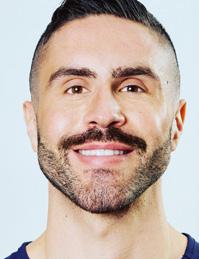

Dr Dev Patel is founder and medical director of the multiaward-winning Perfect Skin Solutions. He has previously served as both a naval doctor and NHS general practitioner.



Julie Scott is a registered nurse and independent nurse prescriber with more than 20 years’ experience in aesthetics. She practises from her own Essex clinic, Facial Aesthetics.

Sharon Bennett is chair of the British Association of Cosmetic Nurses (BACN). Bennett has previously won The Aesthetics Award for Nurse Practitioner of the Year and the Award for Outstanding Achievement.


Dr Ahmed El Houssieny is a trained anaesthetist and an honorary lecturer at the University of Chester and an education provider on cosmetic procedures.

Jackie Partridge is an aesthetic nurse prescriber with a BSc in Professional Practice (Dermatology). Partridge is a founding board member of the BACN.




Dr Lee Walker is an aesthetic dental surgeon and director and clinical lead at BCity clinics, Liverpool. He is chairman of the Complications in Medical Aesthetic Collaborative (CMAC).
Dr Shirin Lakhani trained in the NHS and various hospital sub-specialities. Dr Lakhani then went on to complete her training in general practice. She is now the medical director of Elite Aesthetics in Kent.
Want to help educate the medical aesthetic community?
Once again, the team at Aesthetics wants to give a massive thank you to all of our Aesthetics Reviewing Panel members for their help this year. We can’t wait to continue this initiative in 2023 and
Rachel Goddard is an independent nurse prescriber who is a country expert for the Teoxane Medical Faculty and director of Totally Aesthetics and Rachel Goddard Aesthetics in Manchester.
Dr Martyn King is the director of Cosmedic Skin Clinic. He is medical director of the Aesthetic Complications Expert (ACE) Group World and vice-chair of the JCCP.
Dr Souphi Samizadeh is a dental surgeon with a Master’s in Aesthetic Medicine. She is the founder of the Great British Academy of Aesthetic Medicine and Revivify London Clinic.
Miss Mayoni Gooneratne founded The Clinic by Dr Mayoni and is an associate member of BCAM. Miss Gooneratne is a trainer for AestheticSource, OFAA and Cosmetic Courses.
Mr James Olding has completed a Bachelor’s of Medicine and Surgery and is a specialist registrar in oral and maxillofacial surgery. He is the founder of aesthetic training provider Interface Aesthetics.
provide our readers with more leading peer-reviewed clinical content, ensuring you get the highest level of education. We are always eager to work with top practitioners in the aesthetic medicine specialty who want to help improve education and drive the industry forward.
So, if you are interested in joining our reviewing panel, send us an email at editorial@aestheticsjournal.com. Or, if you are keen to see your name in print and write for the journal in 2023, please get in touch with our team of friendly journalists!
Reproduced from Aesthetics | Volume 10/Issue 1 - December 2022 @aestheticsjournaluk Aesthetics @aestheticsgroup aestheticsjournal.com
74 Aesthetics | December 2022 Development
Reviewing Panel









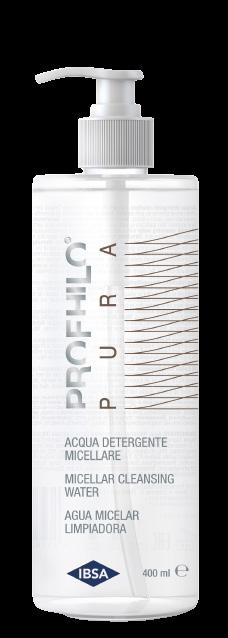

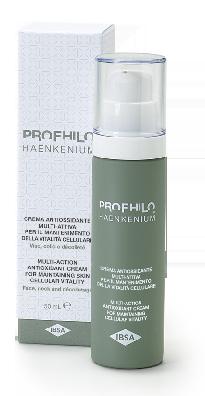

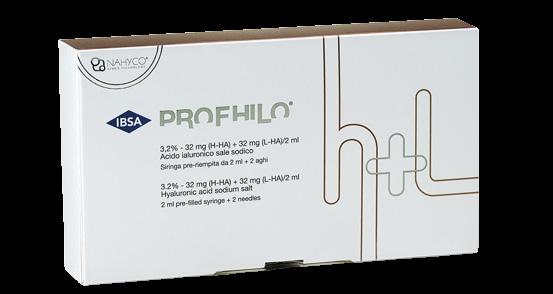


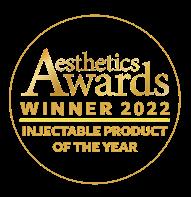


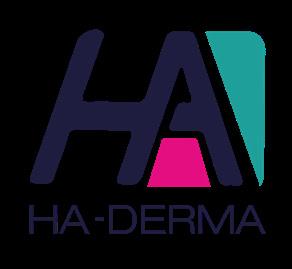
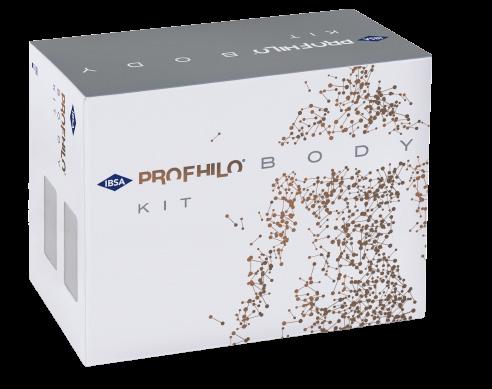
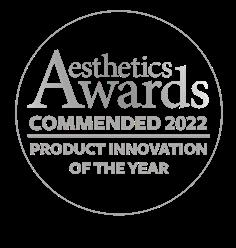









AWARD-WINNING ha-derma.co.uk 0208 455 4896 hadermauk @ha_dermauk Exclusive UK & Ireland distributor/ training provider of IBSA’s aesthetic products PRODUCTS


















































































































































































































































































































